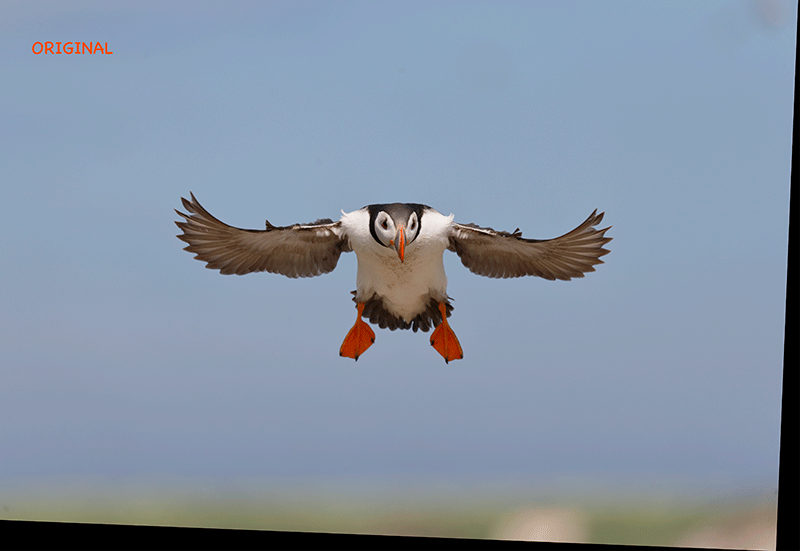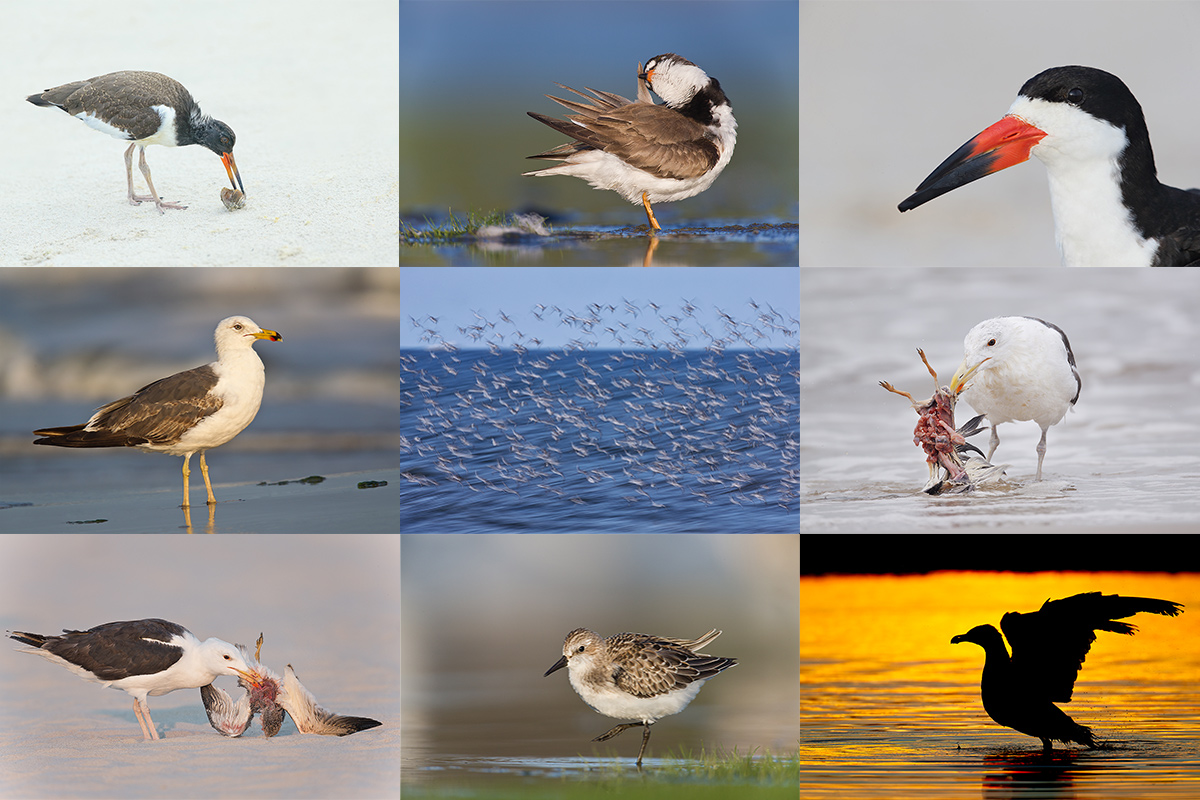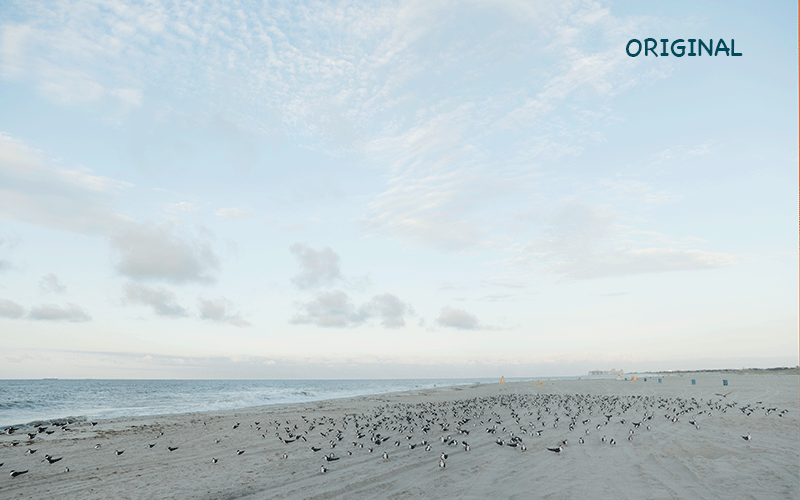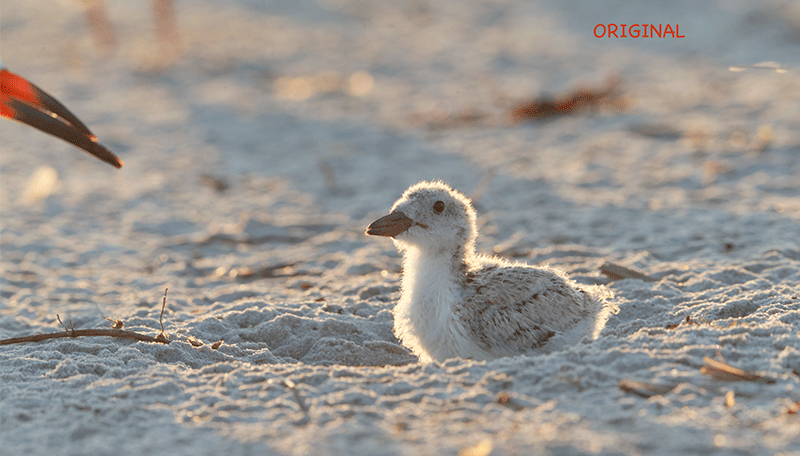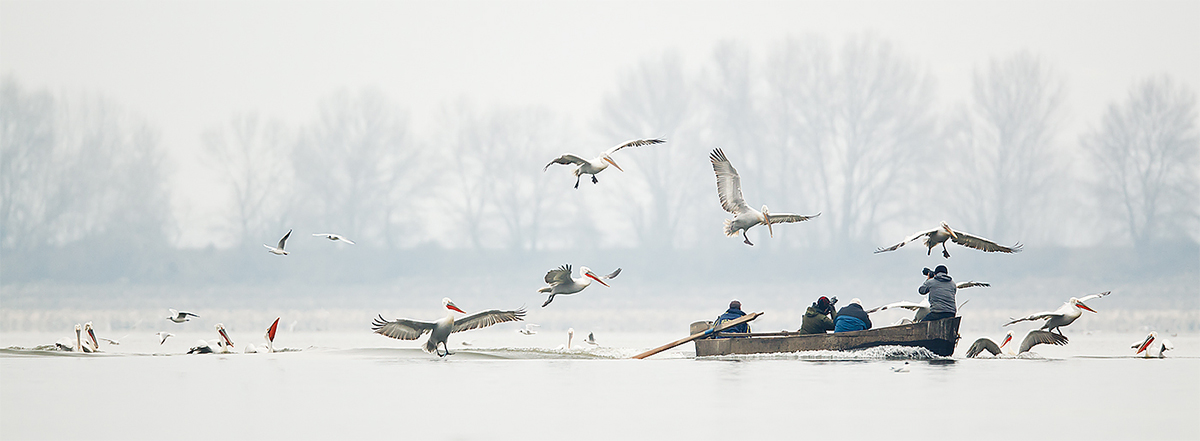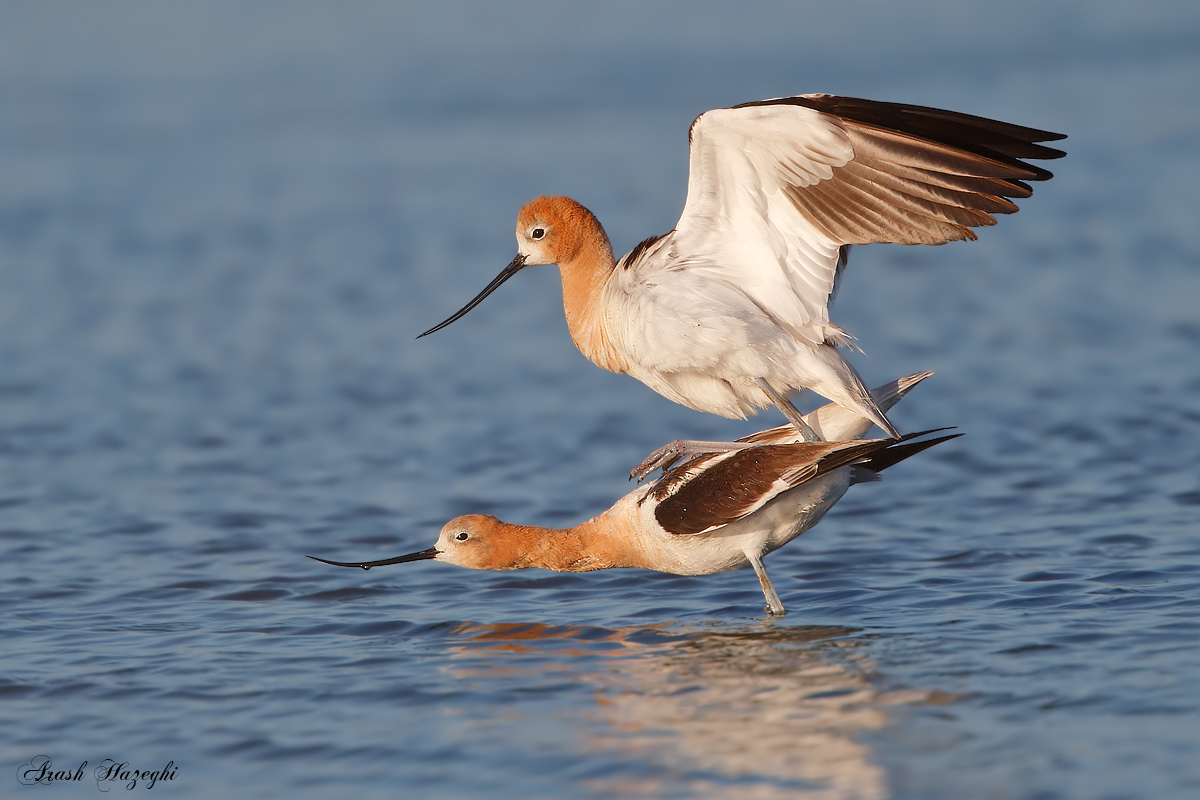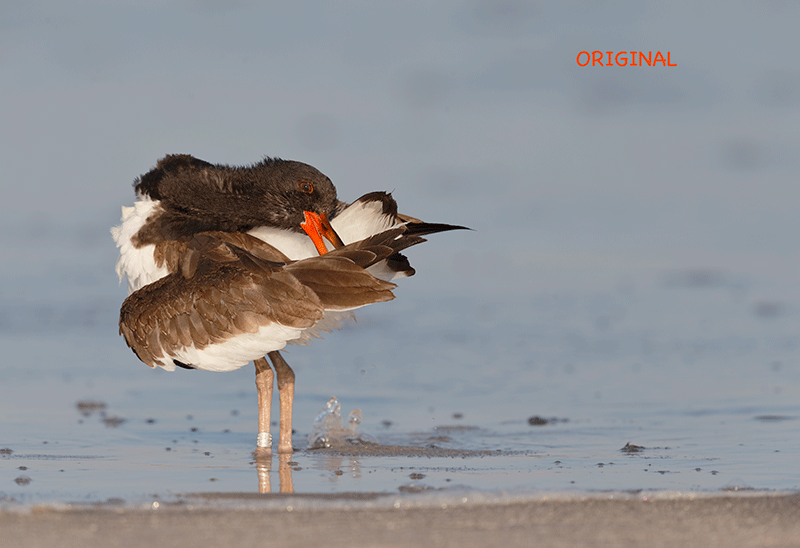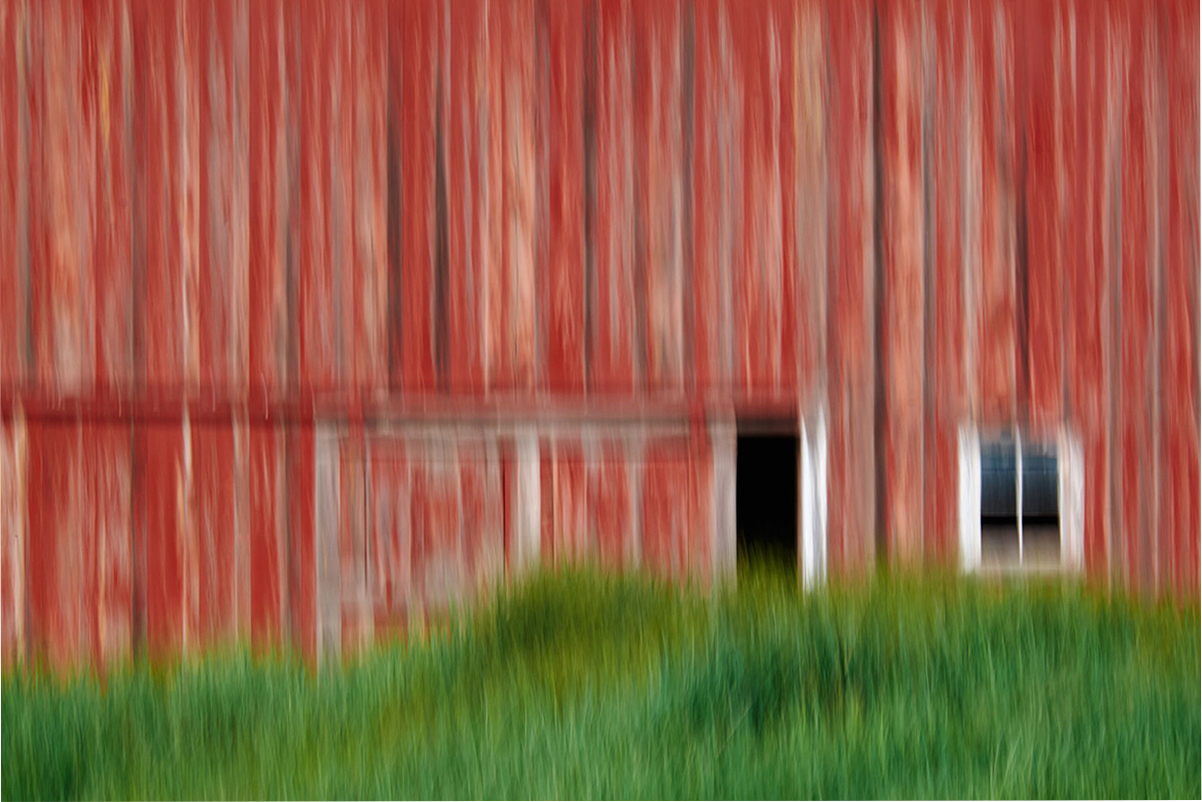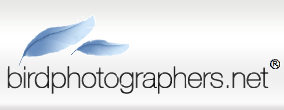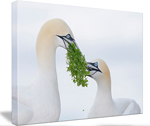July 3rd, 2015 What’s Up?
On Wednesday afternoon a huge thunderstorm hit the puffin island 15 minutes earlier than predicted at 3:45pm. Sideways hail and rain with 40+ mph winds left most folks drenched; the rule in Northumberland is to always have your rain gear along…. Lightning flashed and thunder boomed; our boatman skillfully got us back to port. The storm knocked out internet for about a day and a half. Thus, there was no blog post on Thursday.
Selling Your Used Photo Gear Through BIRDS AS ART
Selling your used (or like-new) photo gear through the BAA Blog or via a BAA Online Bulletin is a great idea. We charge only a 5% commission. One of the more popular used gear for sale sites charges a minimum of 20%. Plus assorted fees! Yikes. The minimum item price here is $500 (or less for a $25 fee). If you are interested please e-mail with the words Items for Sale Info Request cut and pasted into the Subject line :). Stuff that is priced fairly–I offer free pricing advice, usually sells in no time flat. In the past few weeks we have sold nearly everything in sight. Do know that prices on some items like the EOS-1D Mark IV, the old Canon 500mm, the EOS-7D, and the original 400mm IS DO lens have been dropping steadily. You can see the complete listings here.
Recent News
Four more recently-listed lenses sold with the past few days. With the demands of cooking for 12, now 13 folks, and with the internet down for a good bit, I am once again far, far behind in updating the used gear page and answering e-mails. Heck, denise and I have barely had time to breathe…. I may have some time to catch up today. If I missed an important e-mail please re-send it. I will do my best.
|

|
|
This image was created on the UK Puffins and Gannets IPT with the hand held Canon EF 100-400mm f/4.5-5.6L IS II USM lens and the amazing Canon EOS 7D Mark II. ISO 400. Evaluative metering -2/3 stop: 1/5000 sec. at f/5.6. AWB.
Center AF point/AI Servo Expand/Shutter button AF as framed was active at the moment of exposure (as is always best when hand holding). The selected AF point was on the bird’s upper breast just below the black neck band. Click on the image to see a larger version.
Atlantic Puffin flapping
|
600 II vs 100-400II
Though I have lugged the 600II on every landing, I used it only briefly until Thursday afternoon, and even then the 100-400II proved very valuable. The 100-400 II is lightweight, easily hand holdable, and super-sharp. With the 7D II it offers lots of reach, especially with the 1.4X III TC in place. As shown in today’s image, it is extremely versatile; without being able to zoom out I’d have seriously clipped the puffin’s wings. Lastly it’s ridiculously short minimum focusing distance of less than a meter, or about 3 feet, two inches, allows the creative photographer to envision and create images that simply were not possible before the release of this lens.
Canon EF 100-400mm f/4.5-5.6L IS II USM Lens In Stock
For the very first time since its release, B&H has the 100-400 II in stock, ready to be shipped to you. Simply click on the logo link immediately above or use the product-specific text links in any blog post to purchase yours while supporting my efforts here on the blog .
The 100-400 II vs the 200-400 with Internal TC
As expected, I have received several e-mails asking for a comparison of these two great lenses, the Canon EF 100-400mm II and the Canon EF 200-400mm f/4L IS USM Lens with Internal 1.4x Extender. You should find find my detailed analysis here within a week.
The Single Negative?
What do you think is the biggest negative in this image?
Facebook
Be sure to like and follow BAA on Facebook by clicking on the logo link upper right. Tanks a stack!
Support the BAA Blog. Support the BAA Bulletins: Shop B&H here!
We want and need to keep providing you with the latest free information, photography and Photoshop lessons, and all manner of related information. Show your appreciation by making your purchases immediately after clicking on any of our B&H or Amazon Affiliate links in this blog post. Remember, B&H ain’t just photography!
…..
Amazon.com
Those who prefer to support BAA by shopping with Amazon may use this link:
Amazon Canada
Many kind folks from north of the border, eh, have e-mailed stating that they would love to help us out by using one of our affiliate links but that living in Canada and doing so presents numerous problems. Now, they can help us out by using our Amazon Canada affiliate link by starting their searches by clicking here. Many thanks to those who have written.
Typos
In all blog posts and Bulletins, feel free to e-mail or to leave a comment regarding any typos or errors. Just be right :).
July 1st, 2015 Stuff
I have slept great the first two nights with not a trace of jet lag. I always do great flying to places; not so good flying back home regardless of the direction. Tired as we were after the first day of puffins, most of us made it out after dinner to photograph a nearby castle (with the bonus of a rising full moon). After another great dinner of haddock two ways with steamed broccoli/cauliflower/kale prepared by yours truly the group continues to rave enthusiastically about the chef: me. This blog post, the 173rd in a row–what is wrong with me?, is scheduled to be published automatically at 9:00am eastern time on Wednesday, July 1.
|
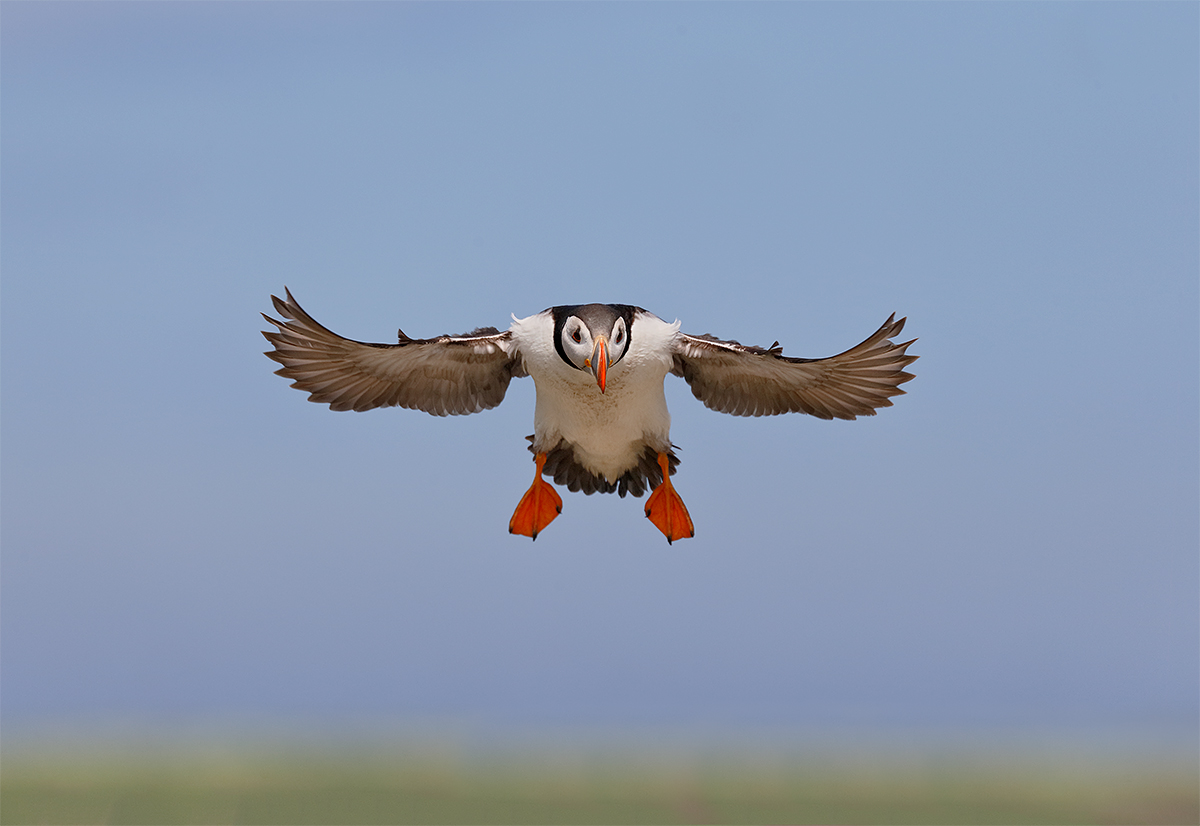
|
|
This image was created on Day 1 of the UK Puffins and Gannets IPT with the hand held Canon EF 100-400mm f/4.5-5.6L IS II USM lens (at 400mm) and the Canon EOS-1D X. ISO 400. Evaluative metering +1 stop: 1/1600 sec. at f/6.3.
Center AF point (Manual selection)/AI Servo Expand/Shutter button AF as originally framed was active at the moment of exposure (as is always best when hand holding). The selected and active AF point was on the base of the bird’s right wing, just past the plane of the eye, yet the eye was sharp. Click on the image to see a larger version.
Atlantic Puffin incoming flight
|
Day 1
We have a super-nice group, a mix of IPT veterans and first timers, all happy campers. We need to get out for day two on the puffin boats so I will be brief here. I brought the 600 II to the islands and barely used it….
With a year under our belt Denise and I knew that with the given sky and wind conditions that there were only two good locations on our morning landing, and that is right where we put the group. I used the 100-400 II with both the 1D X and with the 7D II, with and without the 1.4X TC.
The Image Optimization
As you can see by the animated GIF, I need to level and crop the image. I used content aware fill to fill in the two small triangles of added canvas. A healthy dose of Detail Extractor was applied to the brightest WHITEs on the sides of the head after selecting those with a Quick Mask and refined with the addition of a Layer Mask. That was followed by a 30% layer of my NIK 50-50 recipe and a Contrast Mask on the dark parts of the bird’s face only (after selecting those with the Quick Selection Tool.) Dust spotting and cleaning up the strip of vegetation along the lower frame edge pretty much finished the job.
Digital Basics
Everything that I did to optimize today’s image is covered in detail in my Digital Basics File–written in my easy-to-follow, easy-to-understand style. Are you tired of making your images look worse in Photoshop? Digital Basics File is an instructional PDF that is sent via e-mail. It includes my complete digital workflow, dozens of great Photoshop tips, details on using all of my image clean-up tools, the use of Contrast Masks, several different ways of expanding and filling in canvas, all of my time-saving Keyboard Shortcuts, Quick Masking, Layer Masking, and NIK Color Efex Pro basics, Contrast Masks, Digital Eye Doctor techniques, using Gaussian Blurs, Tim Grey Dodge and Burn, a variety of ways to make selections, how to create time-saving actions, the Surface Blur (background noise reduction) settings as taught to me by Denise Ippolito, and tons more.
APTATS I & II
Learn the details of advanced Quick Masking techniques in APTATS I. Learn Advanced Layer Masking Techniques in APTATS I. Mention this blog post and apply a $5 discount to either with phone orders only. Buy both APTATS I and APTATS II and we will be glad to apply at $15 discount with phone orders only. Please call Jim or Jennifer weekdays at 863-221-2372 to take advantage of this special offer. I am pretty sure that we have extended that offer to the BAA Online Store as well… No time to check right now. 🙂
|
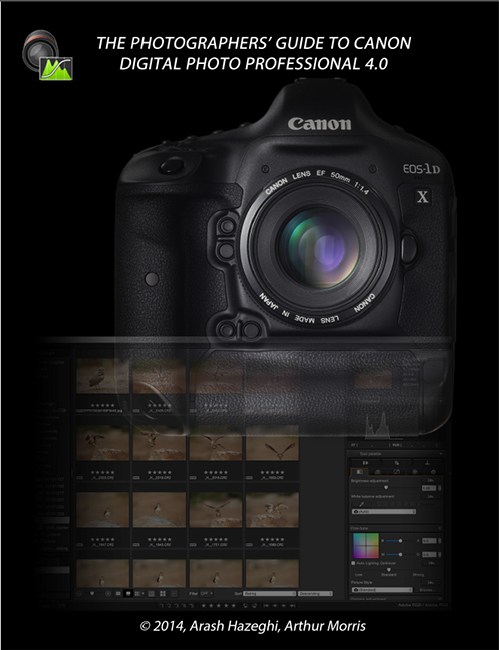
|
|
You can order your copy of “The Photographers’ Guide to Canon Digital Photo Professional 4.0” (aka the DPP 4 Raw Conversion eGuide) by Arash Hazeghi and Arthur Morris by clicking here.
|
The DPP 4 eGuide (PDF)
Learn how and why I and many other discerning photographers choose and use only DPP 4 to convert their Canon RAW files in the DPP 4 RAW Conversion Guide by Arash Hazeghi and yours truly. The latest version supports all of the newer Canon camera bodies and several older models including the EOS-7D and the EOS-1D Mark IV. The DPP IV Guide is the ideal companion to the 7D Mark II User’s Guide, a runaway best seller.
|
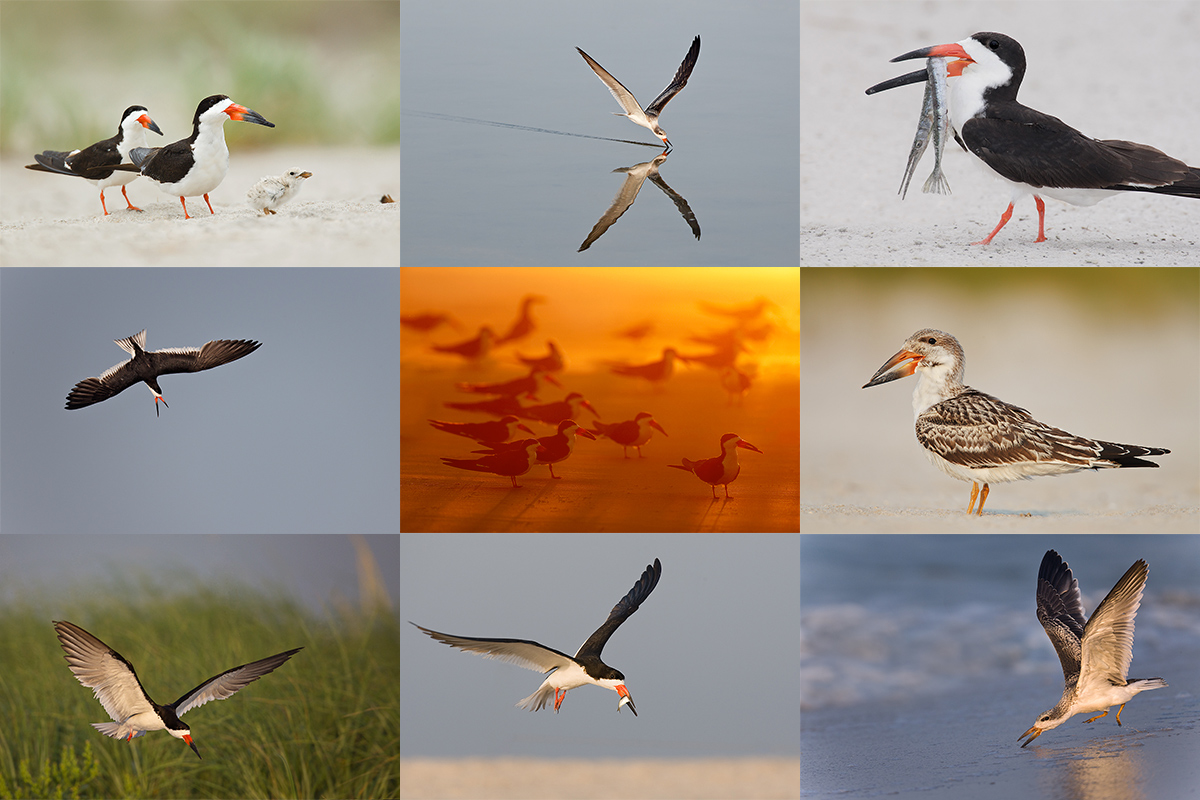
|
|
The strange thing is that when I lived in New York, I never knew about this amazing and consistently productive location.
|
Nickerson Beach/JBWR (possibly…)/Black Skimmer/Oystercatcher/migrant shorebird IPT: August 13-16, 2015. 3 1/2 DAYS: $1399.
Meet and greet on the evening of WED August 12. Limit 10/Openings 3.
Most of our seven photo sessions will be spent at Nickerson beach photographing the nesting Black Skimmers. In flight, sometimes battling. Carrying fish. Chicks of varying sizes from a very few just-hatched to lots of fledglings. It is likely that we will get to see some Great Black-backed Gulls preying on the juvenile skimmers. They swallow them whole. There will be lots of gulls to photograph as well as some Common Terns. Locally breeding shorebird species include American Oystercatcher–pretty much guaranteed, Willet, which is likely, and Piping Plover, which is probable but we need to get lucky with those to get close….
Save a space by calling Jim or Jen at the office and arranging to leave your deposit of $499. I hope to see you there.
JBWR?
If local conditions are ideal we may visit Jamaica Bay Wildlife Refuge to photograph southbound migrant shorebirds on one or possibly two mornings. Even if we do not visit JBWR we should get some good chances with the migrant shorebirds at the beach, especially Sanderling and Semipalmated Plover. Red Knot and others are possible.
|
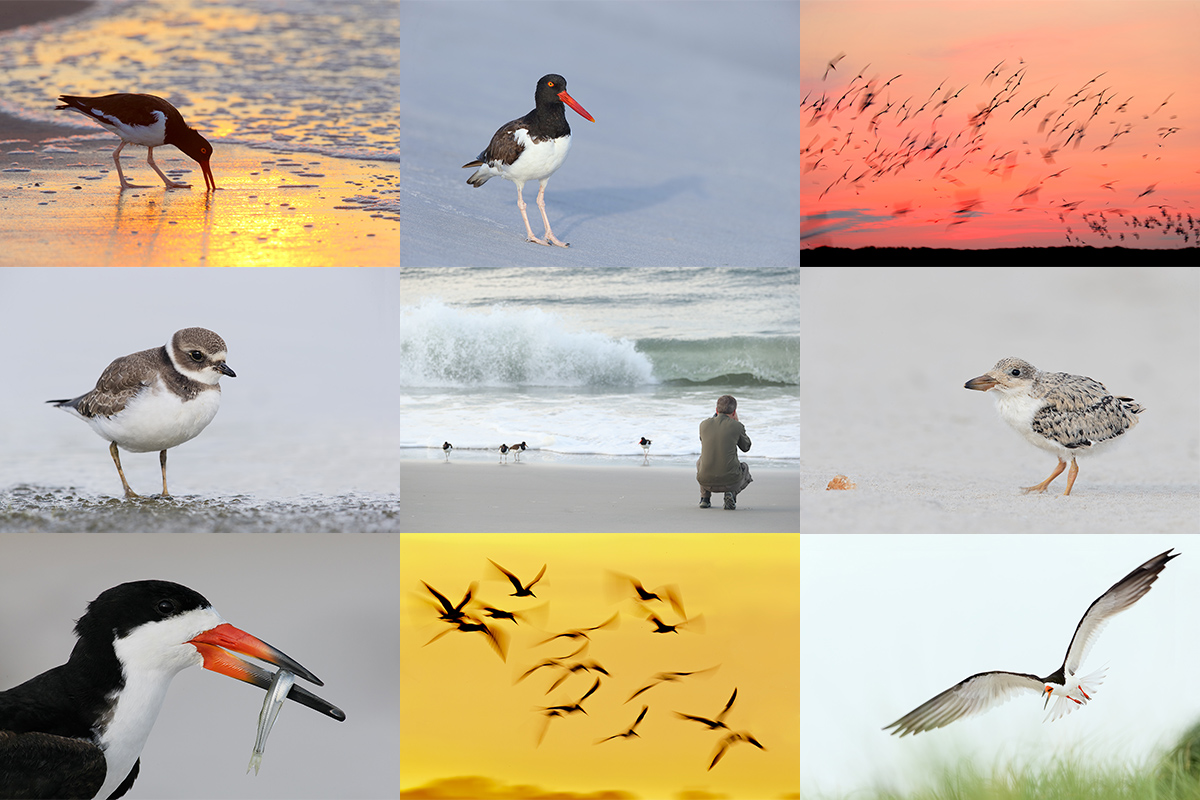
|
|
As you can see, the oystercatchers are quite tame at Nickerson. And we will get you up early and we will stay out late.
|
Jamaica Bay Wildlife Refuge In-the-field Instructional Photo Workshop/Scouting Session. August 12, 2015. Morning only: $250. Cheap!
The tide will be pretty good at the East Pond…. If I learn that conditions there are un-photographable we will do Nickerson Beach as a back-up. This will work either as an add-on for out of town folks coming for the IPT above or as a stand alone session. Either way, you will, as always, learn a ton. And we might even get some good images.
Facebook
Be sure to like and follow BAA on Facebook by clicking on the logo link upper right. Tanks a stack!
Support the BAA Blog. Support the BAA Bulletins: Shop B&H here!
We want and need to keep providing you with the latest free information, photography and Photoshop lessons, and all manner of related information. Show your appreciation by making your purchases immediately after clicking on any of our B&H or Amazon Affiliate links in this blog post. Remember, B&H ain’t just photography!
…..
Amazon.com
Those who prefer to support BAA by shopping with Amazon may use this link:
Amazon Canada
Many kind folks from north of the border, eh, have e-mailed stating that they would love to help us out by using one of our affiliate links but that living in Canada and doing so presents numerous problems. Now, they can help us out by using our Amazon Canada affiliate link by starting their searches by clicking here. Many thanks to those who have written.
Typos
In all blog posts and Bulletins, feel free to e-mail or to leave a comment regarding any typos or errors. Just be right :).
June 30th, 2015 Stuff
Our red eye flight to EDI was a piece of cake. I actually slept pretty well. Denise did not. We met the group at about 10:15 am, met met our transfer truck right on time, picked up our rental vehicles, stopped for a great lunch, and arrived at our lodgings just after 3:00pm. Then it was off to the local market for a group shopping trip. It was really great fun. Then your truly prepared a sumptuous dinner of baked chicken thighs, steamed cauliflower, and steamed kale. It was the first time for me and several others. It is super healthy, really tasty, and went great with the cauliflower. With lots of butter.
It is scheduled to be published automatically at 9:00am eastern time on Tuesday, June 30. Tomorrow is our first puffin boat trip; everyone on the sold out UK Puffins and Gannets IPT is thrilled (and that includes the two leaders!) This blog post is the 172nd in a row.
|
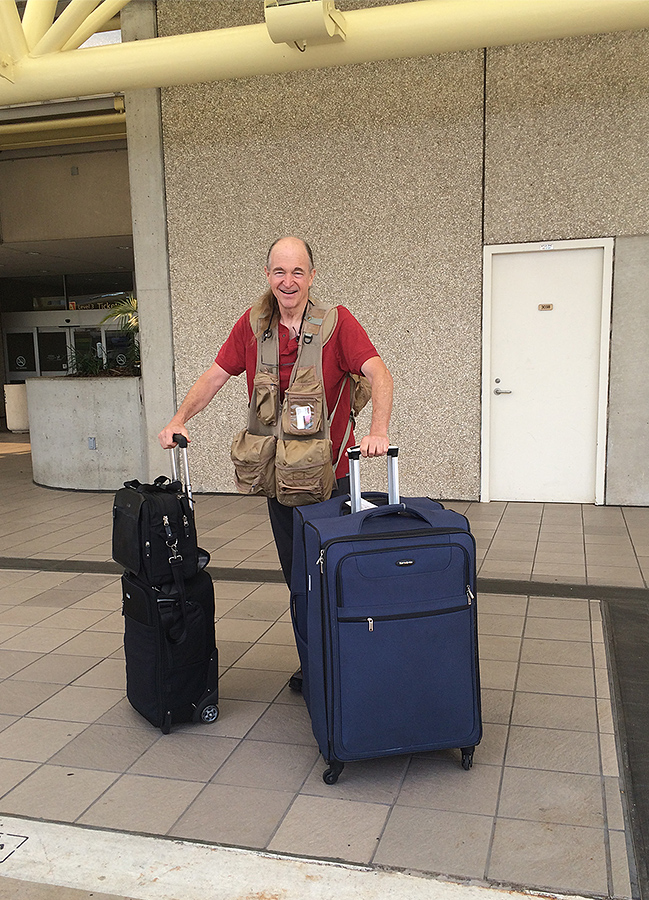
|
|
Yours truly at Orlando International Airport with 2 checked bags, my big Think Tank rolling bag, my Urban Disguise Laptop Bag, and my Xrtrahand vest by Vested Interest.
Image courtesy of and copyright 2015: Jennifer Morris
|
Par For the Course…
I’ve done this a few times. Yet each time for me is more exciting than the last. With all of my diabetic needs and supps it is not possible for me to travel with one checked bag so two it is, here are 47 and 45 pounds respectively.
The 29 inch Samsonite Four-wheel Spinners
About two years denise introduced me to these great bags. They allow me to get around airports without having to rent a luggage cart; heck, as much as I travel they have already paid for themselves.
Recently, after having one of her soft-sided spinners wrecked during a flight, she switched to one of the Samsonite Hard-sided 4-wheel Spinners You will need to scroll down. In the meantime, mine have held up quite well, even the zippers. You will need to scroll down. In the meantime, mine have held up quite well, even the zippers.
Laptop Security Tip
If you are not lucky enough to get TSA-Pre-Check, the tendency is, when you are going through security, to grab one of the large plastic trays, put your laptop in it, and place it on the belt first. Bad idea. I did that twice today and twice the tray with my Macbook Pro Retina was nearly toppled off the end of the belt by the stuff behind it. From now on it is everything else first, laptop last.
Think Tank Airport Security™ V 2.0 Rolling Camera Bag
It is very simple, without my Think Tank Airport Security™ V 2.0 Rolling Camera Bag, I am not going anywhere with my 600 II. Above it comes in at a svelte 44.25 pounds, 4 1/4 pounds heavier than the legal US limit. I have only twice been hassled for roll aboard weight, once flying out of Nairobi, and once in London. Be sure to have a big smile for the gate agent. Pull your rolling bag with the laptop bag atop it on the side opposite the gate agent. In other words, if you are handing over your boarding pass with your right hand, be sure to be pulling your roll-aboard with your left hand with the bag somewhat hidden behind you. And that goes triple if you are wearing a photo vest. Again, I have been hassled about the vest only a very few times in three decades of flying around the world. And I have always talked my way past the agents. Being a diabetic carrying insulin in the vest has saved me on occasion.
Think Tank Urban Disguise Laptop Shoulder Bag
Both denise and I use and love this amazing bag as it has tons of room and enables us to bring tons of extra stuff. A nine inch band of fabric allows you to easily slide the laptop bag safely and securely onto the extended handle of your Think Tank roller. If you take a close look at Jen’s image you should be able to note that feature. Combined with the two Samsonite spinners this allows me to make it through airports easily on my own without a cart. Carpeted areas can be a challenge with the spinners….
Please click on my Think Tank affiliate link here to earn a free gift when you purchase either a Think Tank Rolling Bag or an Urban Disguise laptop bag.
Delkin Flash Cards
As always, both denise and I will have a 64gb Delkin e-Film Pro Flash Card in each camera body so that we never have to change cards in the field thus reducing the risk of losing a card…. Please note the new lower prices here. I do have a few extra 32 and 64gb cards in a Delkin CF Memory Card Tote, mostly to protect against operator error….
|
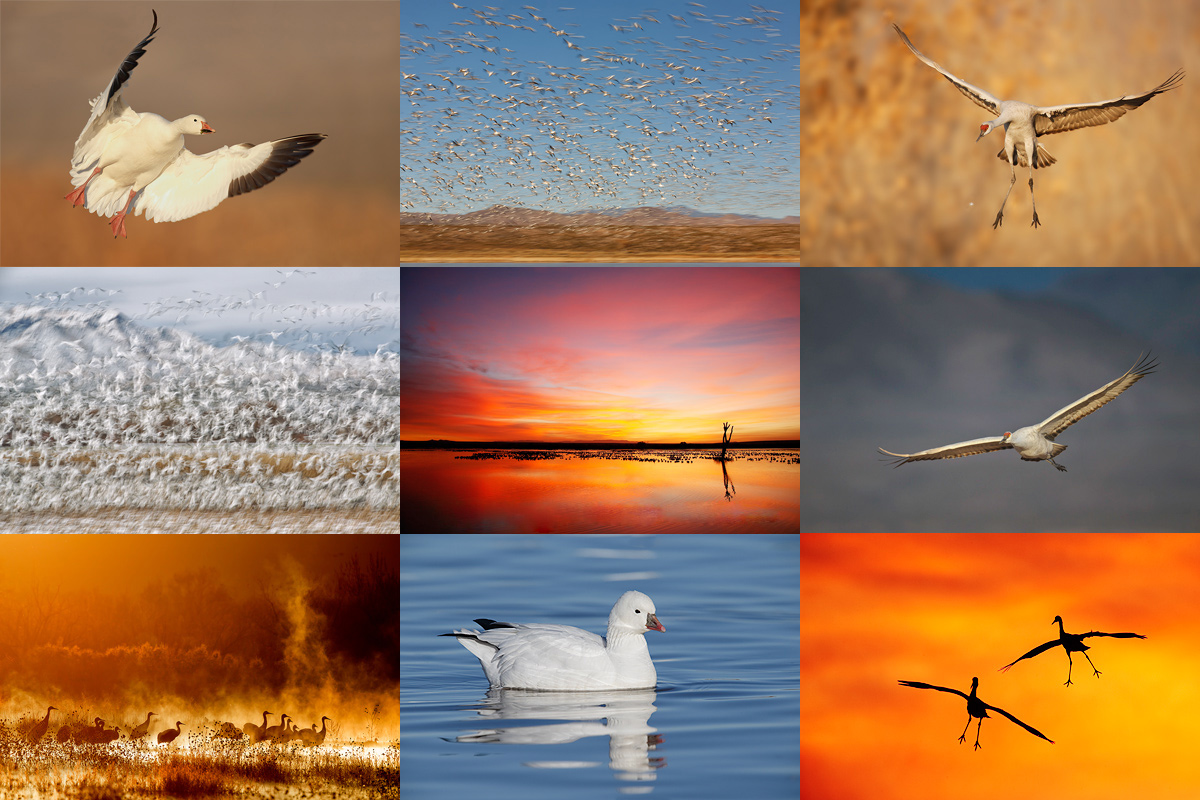
|
|
In 2015, we are offering a 3-DAY IPT before Thanksgiving and a 4-DAY IPT after the holiday. You can attend either and spend Thanksgiving Day with your family. Sign up for both and we will be glad to apply a $100 discount to your balance. We know that there are lots of less costly workshops being offered these days. Many of them are downright cheap. Please remember that you get exactly what you pay for. With us you will have two full time pros there for you every minute we are in the field. Together they have more than 28 seasons of experience at the refuge. If you want the finest in photographic instruction and want to be assured of being in the right spot at exactly the right time every day, do join us.
|
Bosque del Apache 2015 BIRDS AS ART/A Creative Adventure Instructional Photo-Tour (IPT). 3-FULL DAY IPT: NOV 22-24, 2015. $1149. Two great leaders: Denise Ippolito and Arthur Morris. Meet and greet and introductory slide program after dinner on your own at 7:00pm on SAT NOV 21.
Tens of thousands of Snow Geese, 10,000 Sandhill Cranes, ducks, amazing sunrises, sunsets, and blast-offs. Live, eat, and breathe photography with two of the world’s premier photographic educators at one of their very favorite photography locations on the planet. Top-notch in-the-field and Photoshop instruction. This will make 21 consecutive Novembers at Bosque for artie. This will be denise’s 7th workshop at the refuge. Nobody knows the place better than artie does. Join us to learn to think like a pro, to recognize situations and to anticipate them based on the weather, especially the sky conditions, the light, and the wind direction. Every time we make a move we will let you know why. When you head home being able to apply what you’ve learned on your home turf will prove to be invaluable.
This workshop includes 3 morning and 3 afternoon photography sessions, an inspirational introductory slide program after dinner on your own on Saturday, 11/21, all lunches, and after-lunch digital workflow, Photoshop, and image critiquing sessions.
There is never a strict itinerary on a Bosque IPT as each day is tailored to the local conditions at the time and to the weather. We are totally flexible in order to maximize both the photographic and learning opportunities. We are up early each day leaving the hotel by 5:30 am to be in position for sunrise. We usually photograph until about 10:30am. Then it is back to Socorro for lunch and then a classroom session with the group most days. We head back to the refuge at about 3:30pm each day and photograph until sunset. We will be photographing lots of Snow Geese and lots of Sandhill Cranes with the emphasis on expanding both your technical skills and your creativity.
A $449 non-refundable deposit is required to hold your slot for this IPT. Your balance, payable only by check, will be due on 7/25/2015. If you cancel and the trip fills, we will be glad to apply a credit applicable to a future IPT for the full amount less a $100 processing fee. If we do not receive your check for the balance on or before the due date we will try to fill your spot from the waiting list. Whether or not your spot is filled, you will lose your deposit. If not, you can secure your spot by paying your balance.
Please print, complete, and sign the form that is linked to here and shoot it to us along with your deposit check (made out to “Arthur Morris.”) You can also leave your deposit with a credit card by calling the office at 863-692-0906. If you register by phone, please print, complete and sign the form as noted above and either mail it to us or e-mail the scan. If you have any questions, please feel free to contact me via e-mail.
|
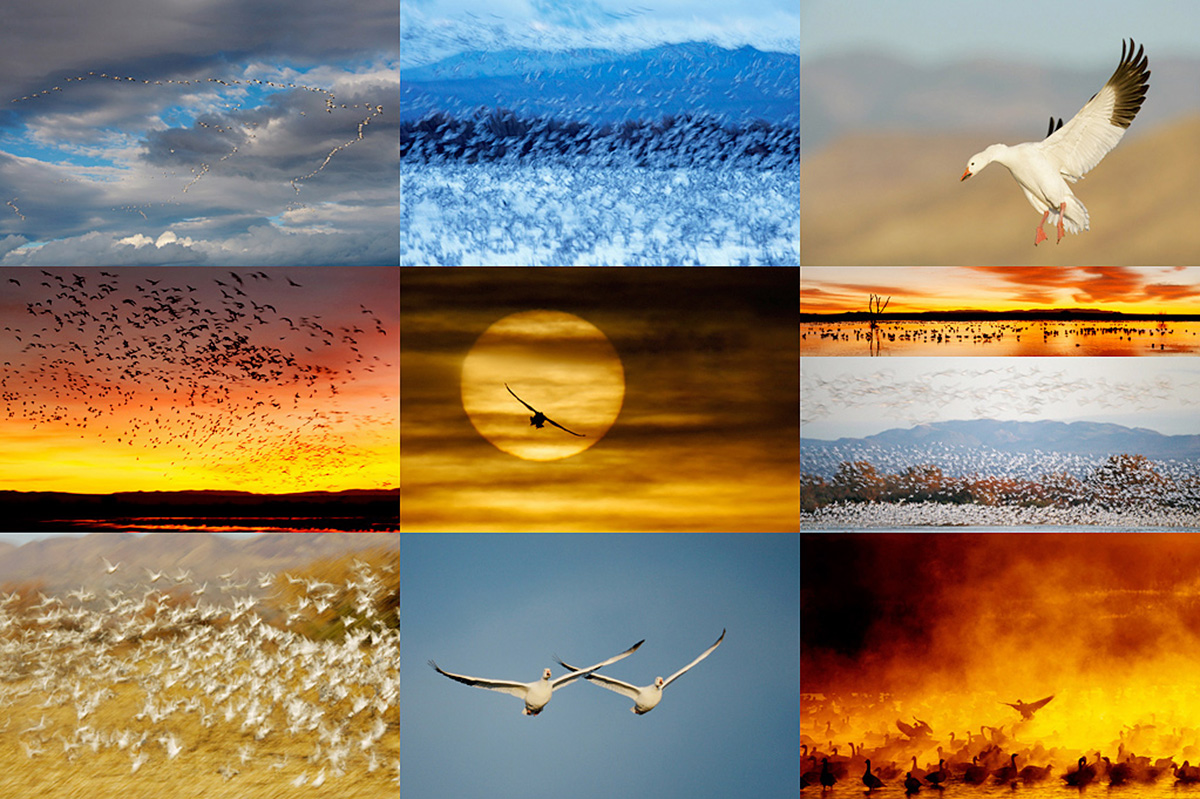
|
|
In 2015, we are offering a 3-DAY IPT before Thanksgiving and a 4-DAY IPT after the holiday. You can attend either and spend Thanksgiving Day with your family. Sign up for both and we will be glad to apply a $100 discount to your balance.
We know that there are lots of less costly workshops being offered these days. Please remember that you get exactly what you pay for. If you want the finest in photographic instruction and want to be assured of being in the right spot at exactly the right time, do join us.
|
Bosque del Apache 2015 BIRDS AS ART/A Creative Adventure Instructional Photo-Tour (IPT). 4-DAY IPT: (three full and two 1/2 DAYS) NOV 28-DEC 2, 2015. $1499. Two great leaders: Denise Ippolito and Arthur Morris. Meet and greet at 3pm on SAT NOV 28 followed by an afternoon photo session at the crane pools and the introductory slide program after dinner on your own.
Tens of thousands of Snow Geese, 10,000 Sandhill Cranes, ducks, amazing sunrises, sunsets, and blast-offs. Live, eat, and breathe photography with two of the world’s premier photographic educators at one of their very favorite photography locations on the planet. Top-notch in-the-field and Photoshop instruction. This will make 21 consecutive Novembers at Bosque for artie. This will be denise’s 7th workshop at the refuge. Nobody knows the place better than artie does. Join us to learn to think like a pro, to recognize situations and to anticipate them based on the weather, especially the sky conditions, the light, and the wind direction. Every time we make a move we will let you know why. When you head home being able to apply what you’ve learned on your home turf will prove to be invaluable.
This workshop includes 4 afternoon (11/28through 12/1), 4 morning (11/29 to 12/2) photography sessions, an inspirational introductory slide program after dinner on your own on Saturday, 11/28, all lunches, and after-lunch digital workflow, Photoshop, and image critiquing sessions.
There is never a strict itinerary on a Bosque IPT as each day is tailored to the local conditions at the time and to the weather. We are totally flexible in order to maximize both the photographic and learning opportunities. We are up early each day leaving the hotel by 5:30 am to be in position for sunrise. We usually photograph until about 10:30am. Then it is back to Socorro for lunch and then a classroom session with the group most days. We head back to the refuge at about 3:30pm each day and photograph until sunset. We will be photographing lots of Snow Geese and lots of Sandhill Cranes with the emphasis on expanding both your technical skills and your creativity.
A $599 non-refundable deposit is required to hold your slot for this IPT. Your balance, payable only by check, will be due on 7/25/2015. If you cancel and the trip fills, we will be glad to apply a credit applicable to a future IPT for the full amount less a $100 processing fee. If we do not receive your check for the balance on or before the due date we will try to fill your spot from the waiting list. Whether or not your spot is filled, you will lose your deposit. If not, you can secure your spot by paying your balance.
Please print, complete, and sign the form that is linked to here and shoot it to us along with your deposit check (made out to “Arthur Morris.”) You can also leave your deposit with a credit card by calling the office at 863-692-0906. If you register by phone, please print, complete and sign the form as noted above and either mail it to us or e-mail the scan. If you have any questions, please feel free to contact me via e-mail.
Facebook
Be sure to like and follow BAA on Facebook by clicking on the logo link upper right. Tanks a stack!
Support the BAA Blog. Support the BAA Bulletins: Shop B&H here!
We want and need to keep providing you with the latest free information, photography and Photoshop lessons, and all manner of related information. Show your appreciation by making your purchases immediately after clicking on any of our B&H or Amazon Affiliate links in this blog post. Remember, B&H ain’t just photography!
…..
Amazon.com
Those who prefer to support BAA by shopping with Amazon may use this link:
Amazon Canada
Many kind folks from north of the border, eh, have e-mailed stating that they would love to help us out by using one of our affiliate links but that living in Canada and doing so presents numerous problems. Now, they can help us out by using our Amazon Canada affiliate link by starting their searches by clicking here. Many thanks to those who have written.
Typos
In all blog posts and Bulletins, feel free to e-mail or to leave a comment regarding any typos or errors. Just be right :).
June 29th, 2015 Stuff
On Saturday I enjoyed an easy one mile swim and did most of my core exercises. Sunday was get-away and get to Newark Day. I actually slept until the alarm went off at 6am on Sunday morning. Most days at home I never set an alarm yet am almost always up and at ’em no later than 5:00am. While traveling and teaching I always set an alarm but rarely get to hear it go off as I am an early riser. I’d say that I sleep to the alarm less than 10 days each year…. I am putting the finishing touches on this blog post while online at Orlando Airport. Older daughter Jen dropped me off at MCO at 11:15am. This blog post, which took me about 1 1/2 hours in all to assemble, is the 171st in a row. It is scheduled to be published automatically at 5:00am eastern time just after we land in Edinburgh, Scotland to meet the boys and girls on the sold out UK Puffins and Gannets IPT.
However, I screwed that up big time. It is now being published at 2:55pm ET on Monday, June 29 from Seahouses, the UK….
Please Help Support My Work on the BAA Blog
Thanks a Stack! June has been a Great Month.
The last two weeks have been quite rewarding. Thanks a stack to the many who used our B&H links for purchases large and small. Right now I am working closely with my B&H rep to have four 400 DO and two 100-400 II BAA Affiliate orders expedited. It has been nearly impossible to come by a 400 DO II. I am hoping that my efforts pay dividends fairly soon…. The supply of 100-400IIs has been much more steady with availability every week to ten days.
To show your appreciation for my efforts here, we ask, as always, that you use our the B&H and Amazon affiliate links on the right side of the blog for all of your purchases. B&H Is recommended for you major photography gear purchases, Amazon for your household, entertainment, and general purpose stuff. Please check the availability of all photographic accessories in the BIRDS AS ART Online Store, especially Gitzo tripods, Wimberley tripod heads, and the like. We sell only what I have used, have tested, and can depend on. We will not sell you junk. We know what you need to make creating great images easy and fun. And we are always glad to answer your gear questions via e-mail.
I would of course appreciate your using our B&H affiliate links for all of your major gear, video, and electronic purchases. For the photographic stuff mentioned in the paragraph above we, meaning BAA, would of course greatly appreciate your business. Here is a huge thank you to the many who have been using our links on a regular basis and visiting the BAA Online store as well.
Selling Your Used Photo Gear Through BIRDS AS ART
Selling your used (or like-new) photo gear through the BAA Blog or via a BAA Online Bulletin is a great idea. We charge only a 5% commission. One of the more popular used gear for sale sites charges a minimum of 20%. Plus assorted fees! Yikes. The minimum item price here is $500 (or less for a $25 fee). If you are interested please e-mail with the words Items for Sale Info Request cut and pasted into the Subject line :). Stuff that is priced fairly–I offer free pricing advice, usually sells in no time flat. In the past few weeks we have sold nearly everything in sight. Do know that prices on some items like the EOS-1D Mark IV, the old Canon 500mm, the EOS-7D, and the original 400mm IS DO lens have been dropping steadily. You can see the complete listings here. Do know that the sale of Steve Leimberg’s 400 DO was finalized today and that Jean Thomas’s original version 70-200mm f/2.8L IS lens sold within two hours as predicted.
Todays items should sell quickly as well.
Two New Listings
Canon 300mm EF300mm f/2.8L IS USM Lens
IPT veteran Tom Blackman is offering a used Canon EF300mm f/2.8L IS USM lens (s/n 29811) in mint condition for $3,175. The sale includes all of the original items such as the lens trunk (hard case), the front and rear lens caps, the documentation, and insured shipping via Fed-Ex Ground. Your item will not ship until your check clears unless other arrangements are made.
Please contact Tom via e-mail or by phone at 619.807.5615 PDT.
Though I never owned this lens I borrowed it often and was quite impressed with the sharpness with and without TCs and with the relatively light weight. It was long the favorite lens of the world’s top raptor photographers.
Canon EF 500mm f/4L IS USM Lens
IPT veteran Tom Blackman is also offering a used Canon EF 500mm f/4L IS USM lens, the “old five,” (s/n 27104) in excellent condition for $4,275. The sale includes all of the original stuff such as the leather front hood, the lens trunk (hard case) with keys, the front leather hood and the rear lens cap, the documentation, a RRS foot as well as the original foot, a LensCoat, and insured shipping via either UPS or Fed-Ex Ground. Your item will not ship until your check clears unless other arrangements are made.
Please contact Tom via e-mail or by phone at 619.807.5615 PDT.
I owned and depended on the “old five” for well more than a decade. At one time it was clearly the world’s most popular super-telephoto lens. Purchasing this lens will leave you with a lot more cash for travel as compared to purchasing a 500 II….
|
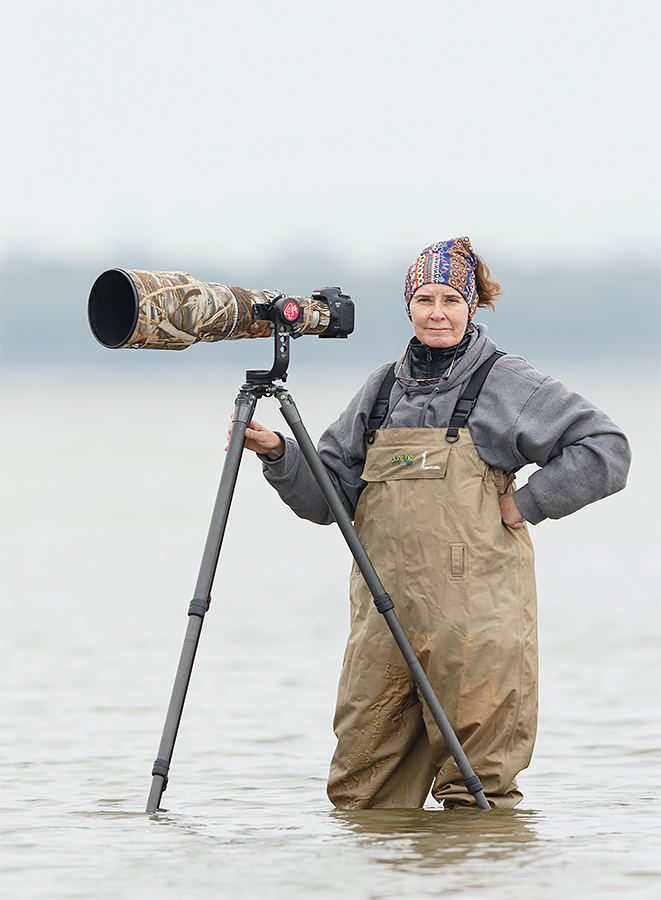
|
|
This image was created at Alafia Banks with the tripod-mounted Canon EF 600mm f/4L IS II USM lens and the Canon EOS-1D X. ISO 800. Evaluative metering +2 1/3 stops as framed: 1/640 sec. at f/5.6. WB: Cloudy.
Center AF point/AI Servo Expand/Rear Focus AF on Donna’s face and re-compose. Click here to see the latest version of the Rear Focus Tutorial. Click on the image to see a larger version.
IPT veteran Donna Bourdon with the 600 II, a 7D II, and the Mongoose M3.6. Lots more on tripods coming here soon….
|
Not Pissed Off Woman Thrilled When Lost Images Materialize
Donna Bourdon has been on more than a few IPTs over the past two years. Her work has improved continuously and she now does very well in club competitions. I created a series of images of her that we both loved on a cloudy morning on an Alafia Banks Hooptie Deux IPT this spring. When I went to send them to her they had simply vanished. I sent her several apologies via e-mail….
Yesterday while working on old image files the lost images appeared. I was thrilled. In the one posted here Donna looks pissed off, or at least as if she has an attitude problem. She is in fact a sweet and easy going happy camper. She is joining me on the Bear Boat IPT and then joining Denise and me in Japan, both with her friend and fellow bird enthusiast Bev.
|
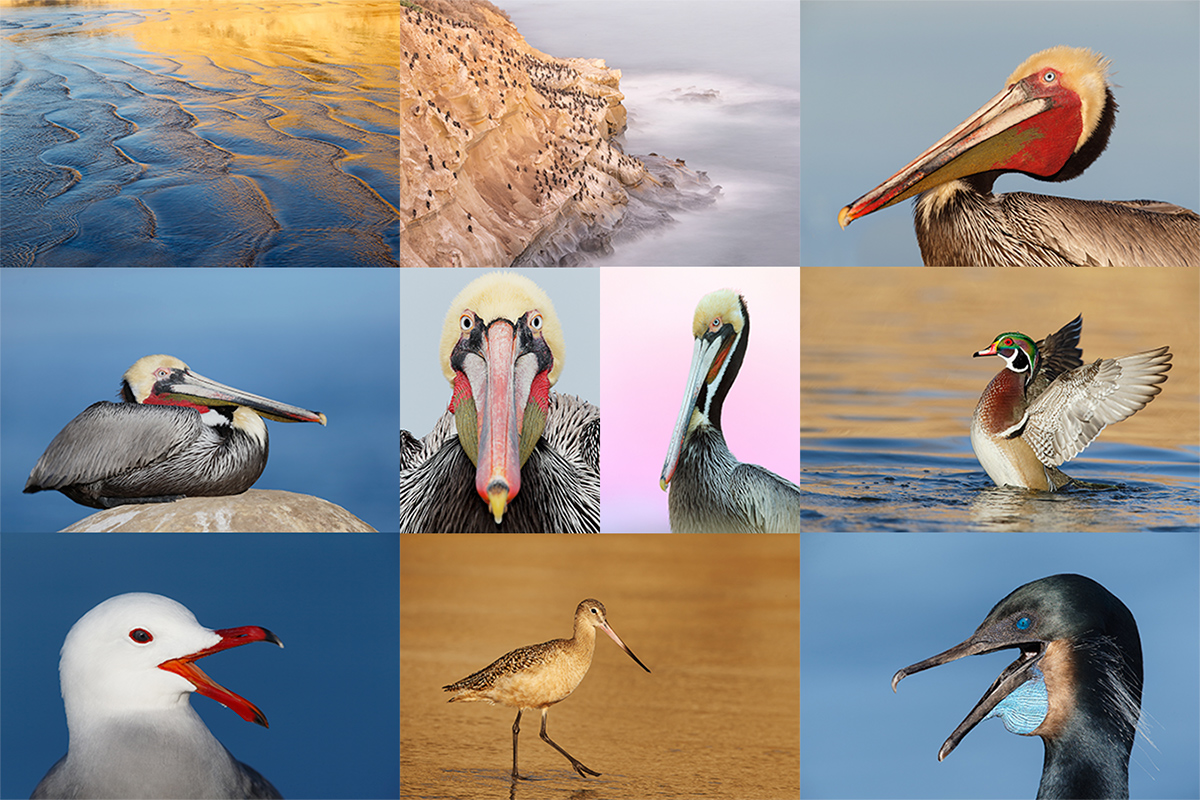
|
|
San Diego offers a wealth of very attractive natural history subjects. With annual visits spanning more than three decades I have lot of experience there….
|
2015 San Diego 4 1/2-DAY BIRDS AS ART Instructional Photo-Tour (IPT) JAN 8 thru the morning of JAN 12, 2016: $1899 (Limit: 10)
Meet and Greet at 7:00pm on the day before the IPT begins
Two great leaders: Arthur Morris and Denise Ippolito
Join us in San Diego to photograph the spectacular breeding plumage Brown Pelicans with their fire-engine red and olive green bill pouches; Brandt’s and Double-crested Cormorants in breeding plumage with their amazing crests; breeding plumage Wood and Ring-necked Duck; other species possible including Lesser Scaup, Redhead, and Surf Scoter; a variety of gulls including Western, California, and the gorgeous Heerman’s, all in full breeding plumage; shorebirds including Marbled Godwit, Willet, Sanderling and Black-bellied Plover; many others possible including Least, Western, and Spotted Sandpiper, Whimbrel, Black and Ruddy Turnstone, Semipalmated Plover, and Surfbird; Harbor Seals (depending on the current regulations) and California Sea Lions likely; and Bird of Paradise flowers. And as you can see by studying the two IPT cards there are some nice landscape opportunities as well.
Did I mention that there are wealth of great birds and natural history subjects in San Diego in winter?
This IPT will include five 3 1/2 hour morning photo sessions, four 2 1/2 hour afternoon photo sessions, five lunches, after-lunch image review and Photoshop sessions, and a thank you dinner. To ensure early starts, breakfasts will be your responsibility.
A $499 non-refundable deposit is required to hold your slot for this IPT. You can send a check (made out to “Arthur Morris) to us at BIRDS AS ART, PO Box 7245, Indian Lake Estates, FL, 33855. Or call Jim or Jennifer at the office with a credit card at 863-692-0906. Your balance, payable only by check, will be due on 11/1//2015. If we do not receive your check for the balance on or before the due date we will try to fill your spot from the waiting list. Please print, complete, and sign the form that is linked to here and shoot it to us along with your deposit check. If you register by phone, please print, complete and sign the form as noted above and either mail it to us or e-mail the scan. If you have any questions, please feel free to contact me via e-mail.
|
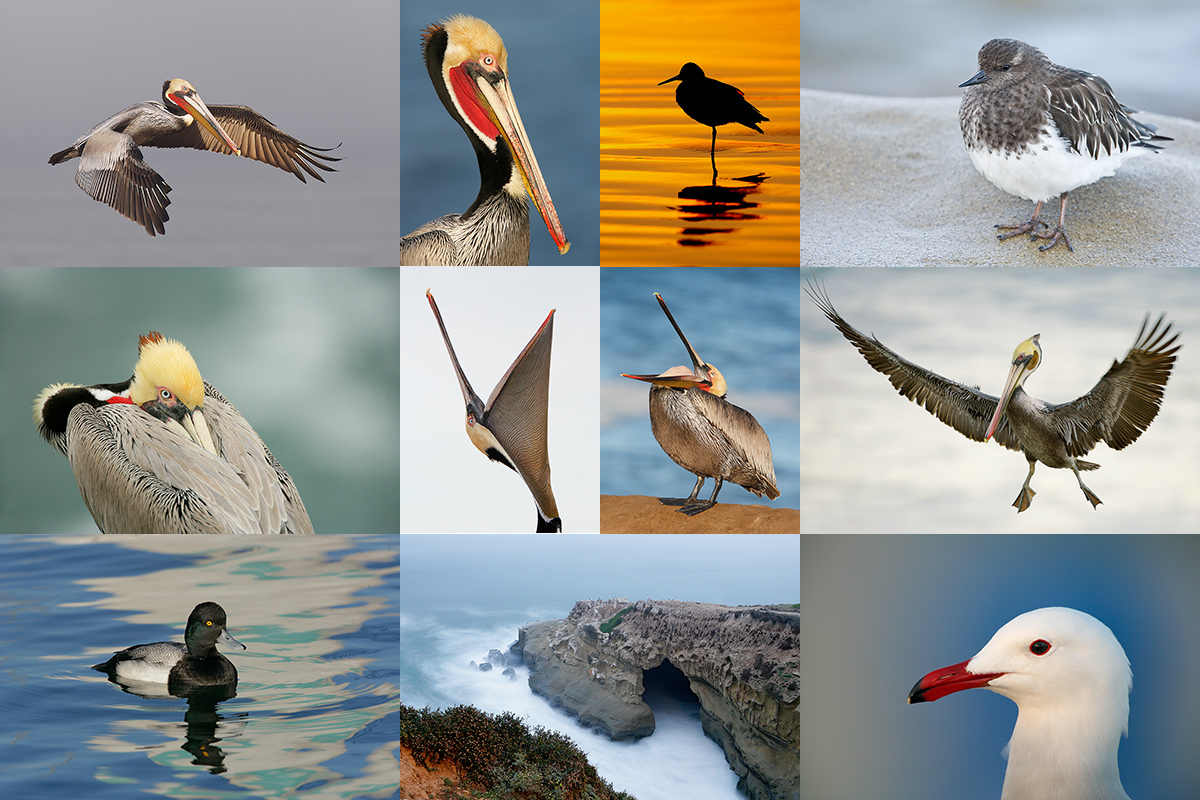
|
|
Though the pelicans will be the stars of the show on this IPT there will be many other handsome and captivating subjects in wonderful settings.
|
Facebook
Be sure to like and follow BAA on Facebook by clicking on the logo link upper right. Tanks a stack!
Support the BAA Blog. Support the BAA Bulletins: Shop B&H here!
We want and need to keep providing you with the latest free information, photography and Photoshop lessons, and all manner of related information. Show your appreciation by making your purchases immediately after clicking on any of our B&H or Amazon Affiliate links in this blog post. Remember, B&H ain’t just photography!
…..
Amazon.com
Those who prefer to support BAA by shopping with Amazon may use this link:
Amazon Canada
Many kind folks from north of the border, eh, have e-mailed stating that they would love to help us out by using one of our affiliate links but that living in Canada and doing so presents numerous problems. Now, they can help us out by using our Amazon Canada affiliate link by starting their searches by clicking here. Many thanks to those who have written.
Typos
In all blog posts and Bulletins, feel free to e-mail or to leave a comment regarding any typos or errors. Just be right :).
June 28th, 2015 Stuff
Again I spent a good part of Saturday working on old image files…. And I started packing my checked bags. This blog post, which took me about 1 1/4 hours to assemble, is the 170th in a row. It was published just before 5:30am on Saturday, June 28, 2015. I fly to Newark today to meet up with denise for our red-eye flight to Edinburgh, Scotland.
Please Help Support My Work on the BAA Blog
Thanks a Stack! June has been a Great Month.
The last two weeks have been quite rewarding. Thanks a stack to the many who used our B&H links for purchases large and small. Right now I am working closely with my B&H rep to have four 400 DO and two 100-400 II BAA Affiliate orders expedited. It has been nearly impossible to come by a 400 DO II. I am hoping that my efforts pay dividends fairly soon…. The supply of 100-400IIs has been much more steady with availability every week to ten days.
To show your appreciation for my efforts here, we ask, as always, that you use our the B&H and Amazon affiliate links on the right side of the blog for all of your purchases. B&H Is recommended for you major photography gear purchases, Amazon for your household, entertainment, and general purpose stuff. Please check the availability of all photographic accessories in the BIRDS AS ART Online Store, especially Gitzo tripods, Wimberley tripod heads, and the like. We sell only what I have used, have tested, and can depend on. We will not sell you junk. We know what you need to make creating great images easy and fun. And we are always glad to answer your gear questions via e-mail.
I would of course appreciate your using our B&H affiliate links for all of your major gear, video, and electronic purchases. For the photographic stuff mentioned in the paragraph above we, meaning BAA, would of course greatly appreciate your business. Here is a huge thank you to the many who have been using our links on a regular basis and visiting the BAA Online store as well.
Big Glass Advice Request…
An e-mail from SB:
Artie, Hope your summer is going well. I just watched your B&H video with Denise on Pleasing Blurs; lovely stuff. You guys have inspired me to try some! Thanks.
We spoke late in April. I am almost ready to spend some money and yes, I will of course use your B&H affiliate link. First I have an important additional question (on top of what you and I have already spoken about before). Here goes:
I am going to find myself with a $30k budget instead of the $20k that we had spoken about earlier. Keeping in mind that I own an EOS 7D Mark II and and an EOS 5D Mark III, which option below would you go with? Or would you recommend a different option?
Be mindful that my biggest two lenses at the moment are 300mm F/4L IS and the 70-200mm f/2.8L IS II. I also own the 24-105mm zoom and both the 1.4X III and the 2X III TCs.
Option 1:
Canon 600mm f/4L IS II
Canon 500mm f/4L IS II
Canon 300mm f/2.8L IS II
Option 2:
Canon 600mm f/4L IS II
Canon 400mm f/2.8L IS II
Canon 300mm f/2.8L IS II
Option 3:
Canon 500mm f/4L IS II
Canon 400mm f/2.8L IS II
Canon 300mm f/2.8L IS II
Option 4:
Canon 600mm f/4L IS II
Canon 500mm f/4L IS II
Canon 400mm f/2.8L IS II
Here is the e-mail conversation that followed:
AM: Where do you photograph?
SB: Mostly in Ohio where I live.
AM: What do you like to photograph?
SB: All types of birds. And I love to do flight photography.
AM: Do you travel to Africa, Antarctica, the Galapagos or similar places with either large animals or very tame birds?
SB: Nope.
AM: Do you go out west to photograph large mammals in low light?
SB: Nope.
AM: How old are you?
SB: 50.
AM: Are you fairly fit?
SB: Yes, fairly.
AM: Give me a call at the office and we can do a phone consult. BTW, if you’d like to learn more about creating pleasing blurs, check out A Guide to Pleasing Blurs by Denise Ippolito and Arthur Morris.
Your Call
#1: Which of the options above would you recommend for SB? Why? (Try not to let the fact that you will be earning a 3.5% commission on the total influence your answer.)
#2: If none of the above, what combination of lenses would you recommend for him? Why?
#3: Which intermediate telephoto lens would you recommend? Why?
#4: Would you recommend that he consider the 200-400II f/4L IS II with Internal TC? Why?
#5: Which of the super-telephotos on his list would you suggest that he definitely not buy? Why?
#6: Would you recommend an additional camera body? Why?
7: What other advice would you give SB?
I will share my answers to the above with y’all here soon. artie
|

|
|
In 2015, we are offering a 3-DAY IPT before Thanksgiving and a 4-DAY IPT after the holiday. You can attend either and spend Thanksgiving Day with your family. Sign up for both and we will be glad to apply a $100 discount to your balance. We know that there are lots of less costly workshops being offered these days. Many of them are downright cheap. Please remember that you get exactly what you pay for. With us you will have two full time pros there for you every minute we are in the field. Together they have more than 28 seasons of experience at the refuge. If you want the finest in photographic instruction and want to be assured of being in the right spot at exactly the right time every day, do join us.
|
Bosque del Apache 2015 BIRDS AS ART/A Creative Adventure Instructional Photo-Tour (IPT). 3-FULL DAY IPT: NOV 22-24, 2015. $1149. Two great leaders: Denise Ippolito and Arthur Morris. Meet and greet and introductory slide program after dinner on your own at 7:00pm on SAT NOV 21.
Tens of thousands of Snow Geese, 10,000 Sandhill Cranes, ducks, amazing sunrises, sunsets, and blast-offs. Live, eat, and breathe photography with two of the world’s premier photographic educators at one of their very favorite photography locations on the planet. Top-notch in-the-field and Photoshop instruction. This will make 21 consecutive Novembers at Bosque for artie. This will be denise’s 7th workshop at the refuge. Nobody knows the place better than artie does. Join us to learn to think like a pro, to recognize situations and to anticipate them based on the weather, especially the sky conditions, the light, and the wind direction. Every time we make a move we will let you know why. When you head home being able to apply what you’ve learned on your home turf will prove to be invaluable.
This workshop includes 3 morning and 3 afternoon photography sessions, an inspirational introductory slide program after dinner on your own on Saturday, 11/21, all lunches, and after-lunch digital workflow, Photoshop, and image critiquing sessions.
There is never a strict itinerary on a Bosque IPT as each day is tailored to the local conditions at the time and to the weather. We are totally flexible in order to maximize both the photographic and learning opportunities. We are up early each day leaving the hotel by 5:30 am to be in position for sunrise. We usually photograph until about 10:30am. Then it is back to Socorro for lunch and then a classroom session with the group most days. We head back to the refuge at about 3:30pm each day and photograph until sunset. We will be photographing lots of Snow Geese and lots of Sandhill Cranes with the emphasis on expanding both your technical skills and your creativity.
A $449 non-refundable deposit is required to hold your slot for this IPT. Your balance, payable only by check, will be due on 7/25/2015. If you cancel and the trip fills, we will be glad to apply a credit applicable to a future IPT for the full amount less a $100 processing fee. If we do not receive your check for the balance on or before the due date we will try to fill your spot from the waiting list. Whether or not your spot is filled, you will lose your deposit. If not, you can secure your spot by paying your balance.
Please print, complete, and sign the form that is linked to here and shoot it to us along with your deposit check (made out to “Arthur Morris.”) You can also leave your deposit with a credit card by calling the office at 863-692-0906. If you register by phone, please print, complete and sign the form as noted above and either mail it to us or e-mail the scan. If you have any questions, please feel free to contact me via e-mail.
|

|
|
In 2015, we are offering a 3-DAY IPT before Thanksgiving and a 4-DAY IPT after the holiday. You can attend either and spend Thanksgiving Day with your family. Sign up for both and we will be glad to apply a $100 discount to your balance.
We know that there are lots of less costly workshops being offered these days. Please remember that you get exactly what you pay for. If you want the finest in photographic instruction and want to be assured of being in the right spot at exactly the right time, do join us.
|
Bosque del Apache 2015 BIRDS AS ART/A Creative Adventure Instructional Photo-Tour (IPT). 4-DAY IPT: (three full and two 1/2 DAYS) NOV 28-DEC 2, 2015. $1499. Two great leaders: Denise Ippolito and Arthur Morris. Meet and greet at 3pm on SAT NOV 28 followed by an afternoon photo session at the crane pools and the introductory slide program after dinner on your own.
Tens of thousands of Snow Geese, 10,000 Sandhill Cranes, ducks, amazing sunrises, sunsets, and blast-offs. Live, eat, and breathe photography with two of the world’s premier photographic educators at one of their very favorite photography locations on the planet. Top-notch in-the-field and Photoshop instruction. This will make 21 consecutive Novembers at Bosque for artie. This will be denise’s 7th workshop at the refuge. Nobody knows the place better than artie does. Join us to learn to think like a pro, to recognize situations and to anticipate them based on the weather, especially the sky conditions, the light, and the wind direction. Every time we make a move we will let you know why. When you head home being able to apply what you’ve learned on your home turf will prove to be invaluable.
This workshop includes 4 afternoon (11/28through 12/1), 4 morning (11/29 to 12/2) photography sessions, an inspirational introductory slide program after dinner on your own on Saturday, 11/28, all lunches, and after-lunch digital workflow, Photoshop, and image critiquing sessions.
There is never a strict itinerary on a Bosque IPT as each day is tailored to the local conditions at the time and to the weather. We are totally flexible in order to maximize both the photographic and learning opportunities. We are up early each day leaving the hotel by 5:30 am to be in position for sunrise. We usually photograph until about 10:30am. Then it is back to Socorro for lunch and then a classroom session with the group most days. We head back to the refuge at about 3:30pm each day and photograph until sunset. We will be photographing lots of Snow Geese and lots of Sandhill Cranes with the emphasis on expanding both your technical skills and your creativity.
A $599 non-refundable deposit is required to hold your slot for this IPT. Your balance, payable only by check, will be due on 7/25/2015. If you cancel and the trip fills, we will be glad to apply a credit applicable to a future IPT for the full amount less a $100 processing fee. If we do not receive your check for the balance on or before the due date we will try to fill your spot from the waiting list. Whether or not your spot is filled, you will lose your deposit. If not, you can secure your spot by paying your balance.
Please print, complete, and sign the form that is linked to here and shoot it to us along with your deposit check (made out to “Arthur Morris.”) You can also leave your deposit with a credit card by calling the office at 863-692-0906. If you register by phone, please print, complete and sign the form as noted above and either mail it to us or e-mail the scan. If you have any questions, please feel free to contact me via e-mail.
Facebook
Be sure to like and follow BAA on Facebook by clicking on the logo link upper right. Tanks a stack!
Support the BAA Blog. Support the BAA Bulletins: Shop B&H here!
We want and need to keep providing you with the latest free information, photography and Photoshop lessons, and all manner of related information. Show your appreciation by making your purchases immediately after clicking on any of our B&H or Amazon Affiliate links in this blog post. Remember, B&H ain’t just photography!
…..
Amazon.com
Those who prefer to support BAA by shopping with Amazon may use this link:
Amazon Canada
Many kind folks from north of the border, eh, have e-mailed stating that they would love to help us out by using one of our affiliate links but that living in Canada and doing so presents numerous problems. Now, they can help us out by using our Amazon Canada affiliate link by starting their searches by clicking here. Many thanks to those who have written.
Typos
In all blog posts and Bulletins, feel free to e-mail or to leave a comment regarding any typos or errors. Just be right :).
June 27th, 2015 Stuff
Again I spent a good part of Friday re-arranging and doing third edits on trip image folders with lots more of the same in store for Saturday. I made a lot of progress–deleting many thousands of images kept on the first round of editing (picking keepers) but still have a ton of work left. This blog post, which took me about 1 1/2 hours to assemble, is the 169th in a row. It was published just before 5:30am on Saturday, June 27, 2015. I fly to Newark tomorrow to meet up with denise for our red-eye flight to Edinburgh, Scotland. I start packing seriously today.
Please Help Support My Work on the BAA Blog
Thanks a Stack! June has been a Great Month.
The last two weeks have been quite rewarding. Thanks a stack to the many who used our B&H links for purchases large and small. Right now I am working closely with my B&H rep to have four 400 DO and two 100-400 II BAA Affiliate orders expedited. It has been nearly impossible to come by a 400 DO II. I am hoping that my efforts pay dividends fairly soon…. The supply of 100-400IIs has been much more steady with availability every week to ten days.
To show your appreciation for my efforts here, we ask, as always, that you use our the B&H and Amazon affiliate links on the right side of the blog for all of your purchases. B&H Is recommended for you major photography gear purchases, Amazon for your household, entertainment, and general purpose stuff. Please check the availability of all photographic accessories in the BIRDS AS ART Online Store, especially Gitzo tripods, Wimberley tripod heads, and the like. We sell only what I have used, have tested, and can depend on. We will not sell you junk. We know what you need to make creating great images easy and fun. And we are always glad to answer your gear questions via e-mail.
I would of course appreciate your using our B&H affiliate links for all of your major gear, video, and electronic purchases. For the photographic stuff mentioned in the paragraph above we, meaning BAA, would of course greatly appreciate your business. Here is a huge thank you to the many who have been using our links on a regular basis and visiting the BAA Online store as well.
Selling Your Used Photo Gear Through BIRDS AS ART
Selling your used (or like-new) photo gear through the BAA Blog or via a BAA Online Bulletin is a great idea. We charge only a 5% commission. One of the more popular used gear for sale sites charges a minimum of 20%. Plus assorted fees! Yikes. The minimum item price here is $500 (or less for a $25 fee). If you are interested please e-mail with the words Items for Sale Info Request cut and pasted into the Subject line :). Stuff that is priced fairly–I offer free pricing advice, usually sells in no time flat. In the past few weeks we have sold nearly everything in sight. Do know that prices on some items like the EOS-1D Mark IV, the old Canon 500mm, the EOS-7D, and the original 400mm IS DO lens have been dropping steadily. You can see the complete listings here. Do know that Steve Leimberg’s 400 DO sold instantly as predicted…. Todays items should sell quickly as well.
Two New Listings
Used Canon EF 100-400 f 4.5-5.6 L IS USM Lens
Jean Thomas is offering a used Canon EF 100-400 f 4.5-5.6 L IS in like-new condition for $699 including insured shipping via Fed Ex or UPS Ground to US addresses. The sale also includes the original tough fabric case, the strap, the original box, the front and rear caps, the lens hood, and the tripod ring. Your gear will be shipped only after your check clears.
Please contact Jean via e-mail or by phone at 954-632-5822 (EST). Photos of the lens and accessories are available upon request.
The 100-400 is a versatile intermediate telephoto zoom lens with 1,000+ uses. It makes a great starter lens especially for folks who do general nature and wildlife in addition to birds. I’ve sold 100s of images made with a 1-4 and denise loved hers for many years forsaking it only recently for the Canon EF 70-200mm f/2.8L IS II USM lens. Jean’s 100-400 in like new condition ties the lowest-ever price for this item. artie
Used Canon EF 70-200mm f/2.8L IS USM Lens
Sale Pending within 2 hours!
Jean Thomas is also offering the original version of the Canon EF 70-200mm f/2.8L IS USM lens in excellent condition for the low price of $649. The sale includes insured shipping via Fed Ex or UPS Ground to US addresses, the tough fabric case, the original box, the front and rear caps, the lens hood, and the tripod ring. Your gear will be shipped only after your check clears.
Please contact Jean via e-mail or by phone at 954-632-5822 (EST). Photos of the lens and accessories are available upon request.
Teamed with a 7D II and a 1.4X II or III TC the original 70-200 L IS lens would make a great starter lens for someone who lives near tame birds; think Florida or California. I used this lens for birds for many years, at Fort DeSoto with the old 50D, for Bosque blast-off blurs, and at Maya’s dance recitals. And you cannot beat the low price. artie
|
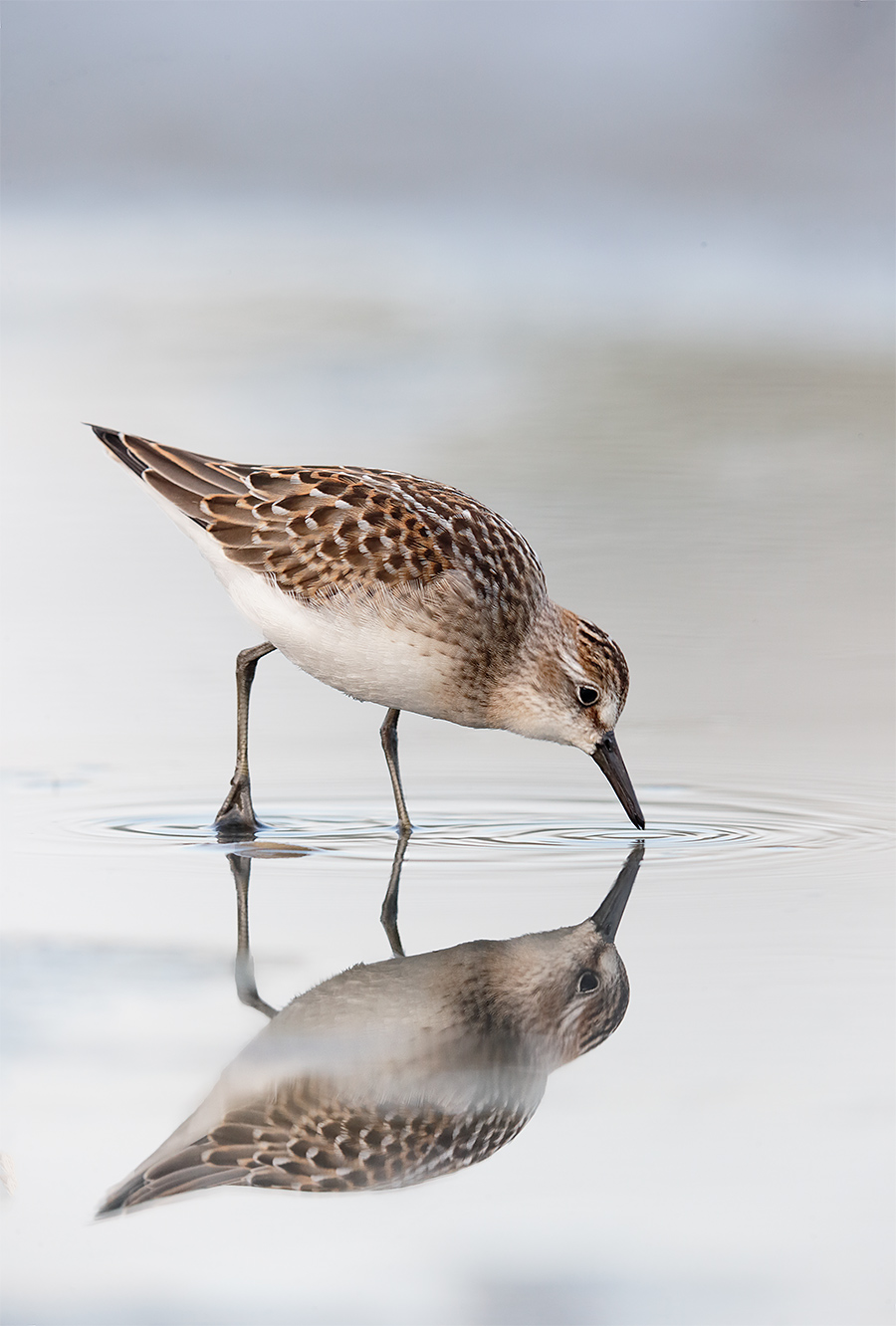
|
|
This image was created last August at Jamaica Bay Wildlife Refuge in Queens, NY with the tripod-mounted Canon EF 600mm f/4L IS II USM lens, the Canon Extender EF 2X III, and the Canon EOS-1D X. ISO 1000. Evaluative metering +1 stop: 1/320 sec. at f/9. AWB.
Center AF point/AI Servo Expand (by necessity)/Rear Focus AF as framed was active at the moment of exposure. Being restricted to the center AF point (ply the four expanded points) can present challenges; here the AF point was on a spot just this side of the bird’s eye… Thus, the eye in the original is a bit softer than I would have liked. Click here to see the latest version of the Rear Focus Tutorial. Click on the image to see a larger version.
Semipalmated Sandpiper in fresh juvenal plumage
|
Shorebird Lessons
North American shorebirds are relatively small birds in one of several families including the sandpipers, oystercatchers, avocets and stilts, and plovers. The sandpiper family includes the small sandpipers collectively known as the “peeps,” phalaropes, godwits, yellowlegs, curlews, snipe, woodcock, and dowitchers. Many of them love running around in the mud or wet sand looking for food. Others prefer grassier habitats. Some love open beaches. Most feed on small invertebrates, small mollusks and snails, and a variety or usually aquatic insects and worms. Some like Ruddy Turnstone may resort to scavenging. I have seen them feeding on French fries at Daytona Beach and picking away at large dead fish.
When I began birding in 1976 they quickly became my favorite bird family. Do understand that many birds of the shore like gulls, terns, skimmers, ducks, pelicans, and others are not correctly noted as being shorebirds.
It is often easier to age a shorebird, that is, to tell if it is a juvenile bird or an adult, than it is to identify it as to species. The bird in today’s featured photograph is a juvenile Semipalmated Sandpiper. Adults in August have splotchy feather patterns that give the birds a worn, uneven look. Juveniles like this bird have a nice edging or fringe on each feather giving the bird a neatly patterned look. Semipalmated Sandpiper is one of the five regularly occurring North American peeps. It has black or very dark greenish legs and a fairly straight, fairly stout medium length bill (on average) with somewhat of a blob at the tip. The wings and tail are approximately the same length. Keep these tips in mind as you try to identify some of the additional shorebird species that I will be posting.
What Bugs Me?
While I love almost everything about this image, there are two things that bug me. They are closely related…. If you think that you know what they are, please do leave a comment.
Shorebirds, Beautiful Beachcombers
This, my first book, is perfect for anyone who wishes to learn about shorebirds (without being overwhelmed by the difficult identification problems). In addition to sharing lots of simple ID tips I cover the basics of shorebird biology and ecology including migration, breeding, and feeding habits. The book is illustrated with 70 of my images and 26 more by some of the world’s best nature photographers. We only have a very few boxes of this classic left; when they are gone it will be used copies only on Amazon or eBay only. Click here to order your copy. In most of North American southbound shorebird migration begins in earnest in a very few days with failed nesters leaving their arctic and sub-arctic nesting grounds and heading south. In July they these birds will always be worn, molting adults.
|

|
|
The strange thing is that when I lived in New York, I never knew about this amazing and consistently productive location.
|
Nickerson Beach/JBWR (possibly…)/Black Skimmer/Oystercatcher/migrant shorebird IPT: August 13-16, 2015. 3 1/2 DAYS: $1399.
Meet and greet on the evening of WED August 12. Limit 10/Openings 3.
Most of our seven photo sessions will be spent at Nickerson beach photographing the nesting Black Skimmers. In flight, sometimes battling. Carrying fish. Chicks of varying sizes from a very few just-hatched to lots of fledglings. It is likely that we will get to see some Great Black-backed Gulls preying on the juvenile skimmers. They swallow them whole. There will be lots of gulls to photograph as well as some Common Terns. Locally breeding shorebird species include American Oystercatcher–pretty much guaranteed, Willet, which is likely, and Piping Plover, which is probable but we need to get lucky with those to get close….
Save a space by calling Jim or Jen at the office and arranging to leave your deposit of $499. I hope to see you there.
JBWR?
If local conditions are ideal we may visit Jamaica Bay Wildlife Refuge to photograph southbound migrant shorebirds on one or possibly two mornings. Even if we do not visit JBWR we should get some good chances with the migrant shorebirds at the beach, especially Sanderling and Semipalmated Plover. Red Knot and others are possible.
|

|
|
As you can see, the oystercatchers are quite tame at Nickerson. And we will get you up early and we will stay out late.
|
Jamaica Bay Wildlife Refuge In-the-field Instructional Photo Workshop/Scouting Session. August 12, 2015. Morning only: $250. Cheap!
The tide will be pretty good at the East Pond…. If I learn that conditions there are un-photographable we will do Nickerson Beach as a back-up. This will work either as an add-on for out of town folks coming for the IPT above or as a stand alone session. Either way, you will, as always, learn a ton. And we might even get some good images.
Facebook
Be sure to like and follow BAA on Facebook by clicking on the logo link upper right. Tanks a stack!
Support the BAA Blog. Support the BAA Bulletins: Shop B&H here!
We want and need to keep providing you with the latest free information, photography and Photoshop lessons, and all manner of related information. Show your appreciation by making your purchases immediately after clicking on any of our B&H or Amazon Affiliate links in this blog post. Remember, B&H ain’t just photography!
…..
Amazon.com
Those who prefer to support BAA by shopping with Amazon may use this link:
Amazon Canada
Many kind folks from north of the border, eh, have e-mailed stating that they would love to help us out by using one of our affiliate links but that living in Canada and doing so presents numerous problems. Now, they can help us out by using our Amazon Canada affiliate link by starting their searches by clicking here. Many thanks to those who have written.
Typos
In all blog posts and Bulletins, feel free to e-mail or to leave a comment regarding any typos or errors. Just be right :).
June 26th, 2015 Stuff
Both denise and I are getting more and more excited about our up-coming trip. Again I spent a good part of the day re-arranging and doing third edits on trip image folders with lots more of the same in store for today. I enjoyed both a swim and an ice bath. This blog post, which took me about 2 hours to assemble, is the 168th in a row. It was published just after 6:30am on Friday, June 26, 2015. I fly to Newark on Sunday to meet up with denise for our red-eye flight to Edinburgh, Scotland. I will start packing seriously on Saturday.
Please Help Support My Work on the BAA Blog
Thanks a Stack! June has been a Great Month.
The last two weeks have been quite rewarding. Thanks a stack to the many who used our B&H links for purchases large and small. Right now I am working closely with my B&H rep to have four 400 DO and two 100-400 II BAA Affiliate orders expedited. It has been nearly impossible to come by a 400 DO II. I am hoping that my efforts pay dividends fairly soon…. The supply of 100-400IIs has been much more steady with availability every week to ten days.
To show your appreciation for my efforts here, we ask, as always, that you use our the B&H and Amazon affiliate links on the right side of the blog for all of your purchases. B&H Is recommended for you major photography gear purchases, Amazon for your household, entertainment, and general purpose stuff. Please check the availability of all photographic accessories in the BIRDS AS ART Online Store, especially Gitzo tripods, Wimberley tripod heads, and the like. We sell only what I have used, have tested, and can depend on. We will not sell you junk. We know what you need to make creating great images easy and fun. And we are always glad to answer your gear questions via e-mail.
I would of course appreciate your using our B&H affiliate links for all of your major gear, video, and electronic purchases. For the photographic stuff mentioned in the paragraph above we, meaning BAA, would of course greatly appreciate your business. Here is a huge thank you to the many who have been using our links on a regular basis and visiting the BAA Online store as well.
|
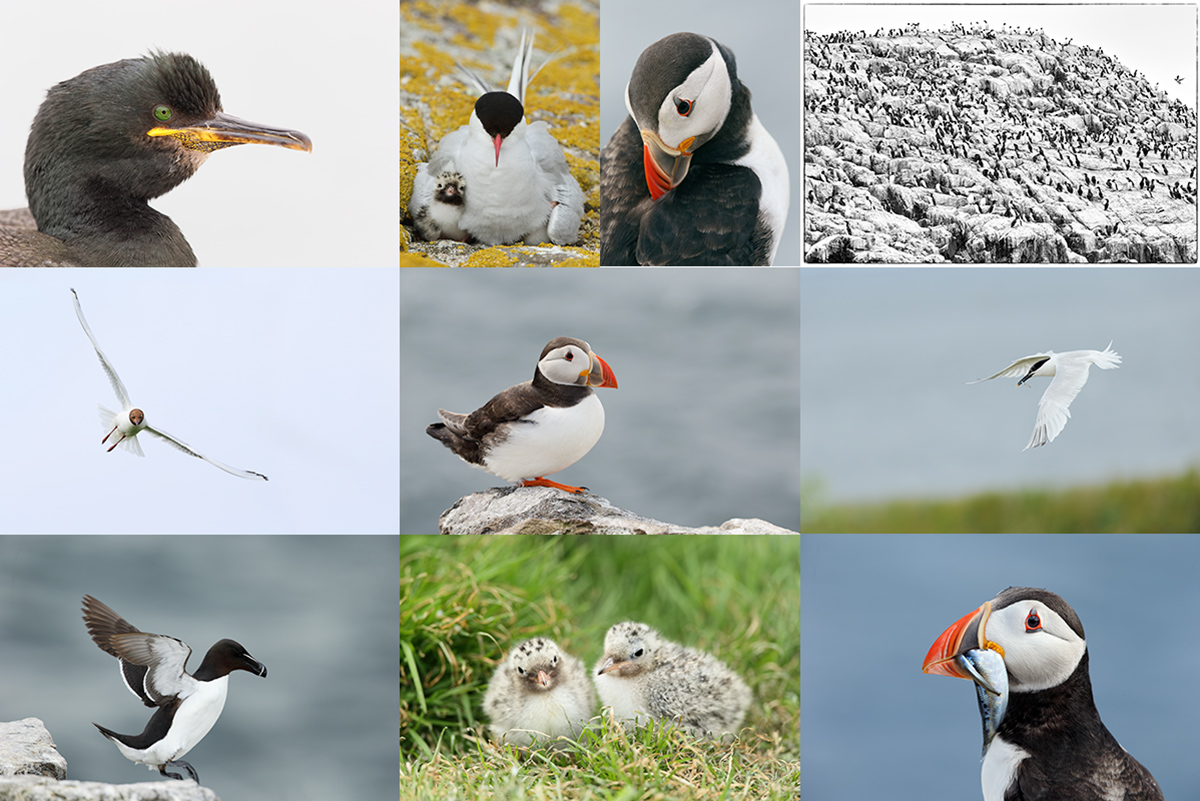
|
|
Having access to a great range of focal lengths on a trip is a huge plus…. Images and card design copyright 2014: Arthur Morris/BIRDS AS ART. Click on the card to enjoy a spectacular larger version.
|
UK Puffins & Gannet IPT Gear Bag
Canon EF 600mm f/4L IS II USM Lens. After traveling on the light side last year, both denise and I are taking our 600 IIs. Many folks who have traveled to the UK for puffins feel that a 600mm lens is overkill. Some state openly, “All you need is a 70-200.” That may be true for them but not for us.
We want our 600s so that we can do the incoming puffins in flight at f/4 (thus yielding some really fast shutter speeds), so that we can easily create tight head portraits, and so that we have the extra reach when needed. Most of the time I will have the big lens with a 1D X mounted in a LensCoat 4X Expandable Long Lens Bag (with harness). Call it shoulder love.
Canon EF 100-400mm f/4.5-5.6L IS II USM lens. I will be using this lens as my on-the-shoulder (with a Black Rapid RS-7 strap) intermediate telephoto lens with either the 5D III or the 7D II. The 100-400 focal length fits almost perfectly with the 600. I envision using it whenever I need to go wider such as when creating images of nests with multiple birds or simply group shots of puffins. It will also be great for hand held flight photography with the 7D II.
Canon EF 24-105mm f/4L IS USM Lens. This all-purpose B-roll lens will be in my Vested Interest Xtrahand vest where it can be grabbed when needed.
|
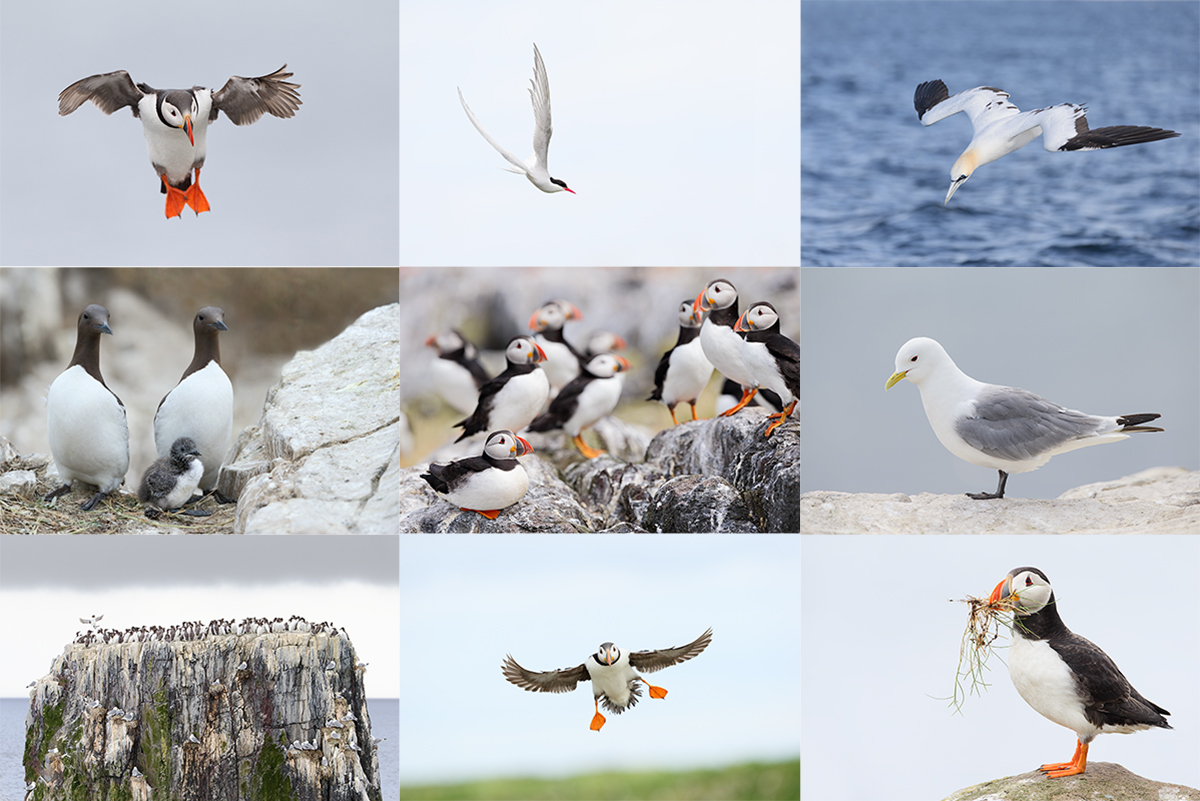
|
|
Several of the images on this card were made with the hand held 70-200mm f/2.8L IS II lens, most with the 1D X and a 1.4X III TC in place. Images and card design copyright 2014: Arthur Morris/BIRDS AS ART. Click on the card to enjoy a spectacular larger version.
|
Focal Length Coverage…
The beauty of the 24-105/100-400 II/600 II combination (as above) is that these three lenses mesh beautifully. The addition of a 1.4X III TC to the 100-400 II and the 2X III TC to the 600 II gives you coverage of focal lengths ranging from 24mm to 1200mm. Substituting her Canon EF 70-200mm f/2.8L IS II USM lens for the 100-400 II will give Denise similar focal length coverage as the 70-200 II works well with either TC.
Canon EF 70-200mm f/4L IS USM Lens. I borrowed this lens from Canon Professional Services just for this trip to use primarily on our gannet boat trips where its light weight weight will be a huge plus. On our previous trip most folks simply could not raise their lenses after the first hour of nonstop flight photography. I will also bring along the optional Canon Tripod Mount Ring A-2 for 70-200mm f/4L (IS & Non-IS versions) so that I can put the lens on a tripod when I need extra depth-of-field or when we are doing castles. The Wimberley P-20 plate is perfect for all intermediate telephoto lenses including this one, the 70-200mm f/2.8L IS, and the 100-400 II.
Canon EF 100mm f/2.8L Macro IS USM Lens with the again optional Canon Tripod Mount Ring D for IS 100mm f/2.8L Macro Lens. And you guessed it, the Wimberley P-20 plate is perfect for this lens also. On our last visit there were some gorgeous purple flowers in bloom on the beaches…. I packed my ThinkTank Airport SecurityTM V2.0 on Thursday afternoon as was glad that I had room for this lens.
Camera Bodies
EOS-1D X. I will use my rugged pro body primarily with the 600 II, going with the 7D II on the big lens only when I need the extra reach. The more powerful 1D X battery makes it better for flight and for driving the AF system when a TC is added.
5D Mark III). Depending on the situation, I will use either the 5D III or the 7D II on the 100-400 II.
EOS-7D Mark II. In addition to part time pairing with the 100-400 II I will go to the 7D II/600II combo (with or without either TC) whenever I need the extra reach.
I will have a 5D II that was converted to infrared by Kolari Vision with me just because infrared is great fun. See here for IR details. I may even do an IR puffin or two even though most folks tell me that IR does not work well with birds….
TCs
Though I almost always travel with three Canon 1.4X III TCs and two 2X III TCs, As this trip is on the short side, I am bringing only two 1.4X TCs and one 2X TC to save weight. I will try to be extra cautious.
Why do I bring extras? For my style of photography I cannot afford to be without both TCs in case of accident or malfunction. Most common in the latter category would be that the locking pin might stick occasionally. When that happens, there is a risk of having your camera body hit the ground….
Singh-Ray Filters: In Case of Rainbows
Singh-Ray filters have been used by the world’s top photographers for many decades. As always, I will have my 77mm Singh-Ray Warming Polarizer in my vest in case of rainbows. I will be running a blog post on using both the Singh-Ray 3-stop resin and the Singh-Ray 5-stop glass 52mm drop-in Neutral Density filters with the Canon super-telephoto lenses soon.
No other filter manufacturer comes close to matching the quality of Singh-Ray’s optical glass that is comparable to that used by NASA. And they continue to pioneer the most innovative products on the market like their ColorCombo polarizer, Vari-ND variable and Mor-Slo 15-stop neutral density filters. When you use their filters, you’ll create better, more dramatic images and, unlike other filters, with absolutely no sacrifice in image quality. All Singh-Ray filters are handcrafted in the USA.

Best News: 10% Discount/Code at checkout: artie10
To shop for a Singh-Ray 5-Stop Mor-Slo Fliter (for example), click on the logo link above, click on “Neutral and color
Solid Neutral Density Filters (glass), then click on “Mor-Slo™ 5, 10, 15 and 20-Stop Solid Neutral Density Filters (glass),” choose the size and model, add to cart, and then checkout. At checkout, type artie10 into the “Have a coupon? Click here to enter your code” box, and a healthy 10% discount will be applied to your total. In addition to enjoying the world’s best filter at 10% off you will be supporting my efforts here on the blog.
|
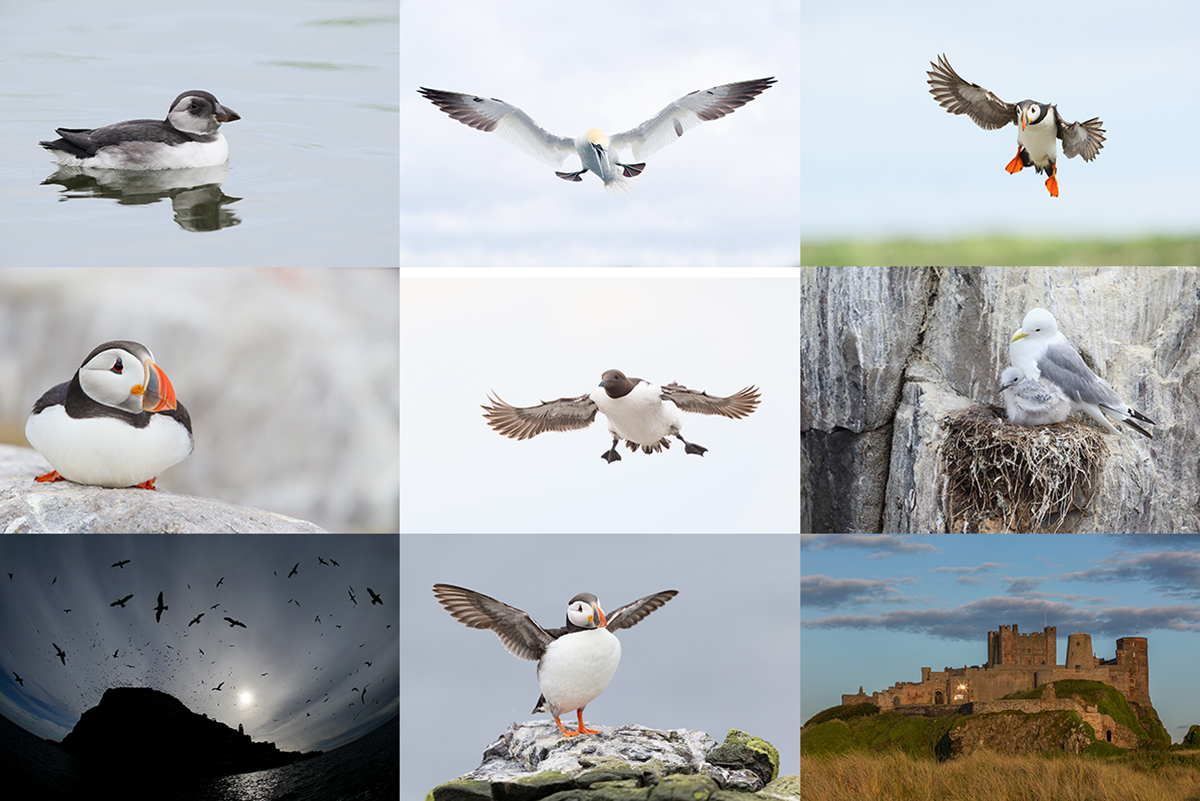
|
|
Images and card design copyright 2014: Arthur Morris/BIRDS AS ART. Click on the card to enjoy a spectacular larger version. We already have two folks signed up for our 2016 trip; dates TBA here in about two weeks. E-mail if you are interested.
|
Think Tank Rolling Bags
I will be using the larger of my two Think Tank rolling bags, the Airport Security™ V 2.0 Rolling Camera Bag. I will use the slightly smaller of the two, the Airport International™ LE Classic for my Southern Ocean trip. Except for the Singh-Ray polarizer, I everything above fit easily into my Airport Security™ V 2.0 Rolling Camera Bag on Thursday afternoon. It tipped the scales at 44 1/4 pounds; the legal limit for US flights is 40 pounds. Nearly all countries in the world give you slack as far as the 40 pounds goes on the way back to the US. As far as the extra 4 1/4 pounds, I have only been hassled for weight once in more than three decades of flying around the world…. I hope that I do not give myself a kine-ahora.
Think Tank Urban Disguise Laptop Shoulder Bag
Both denise and I use and love this amazing bag as it has tons of room and enables us to bring tons of extra stuff.
Please click on my Think Tank affiliate link here to earn a free gift when you purchase a Think Tank Rolling Bag.
Delkin Flash Cards
As always, both denise and I will have a 64gb Delkin e-Film Pro Flash Card in each camera body so that we never have to change cards in the field thus reducing the risk of losing a card…. Please note the new lower prices here. I do have a few extra 32 and 64gb cards in a Delkin CF Memory Card Tote, mostly to protect against operator errors….
Facebook
Be sure to like and follow BAA on Facebook by clicking on the logo link upper right. Tanks a stack!
Support the BAA Blog. Support the BAA Bulletins: Shop B&H here!
We want and need to keep providing you with the latest free information, photography and Photoshop lessons, and all manner of related information. Show your appreciation by making your purchases immediately after clicking on any of our B&H or Amazon Affiliate links in this blog post. Remember, B&H ain’t just photography!
…..
Amazon.com
Those who prefer to support BAA by shopping with Amazon may use this link:
Amazon Canada
Many kind folks from north of the border, eh, have e-mailed stating that they would love to help us out by using one of our affiliate links but that living in Canada and doing so presents numerous problems. Now, they can help us out by using our Amazon Canada affiliate link by starting their searches by clicking here. Many thanks to those who have written.
Typos
In all blog posts and Bulletins, feel free to e-mail or to leave a comment regarding any typos or errors. Just be right :).
June 25th, 2015 Stuff
Both denise and I are a lot more excited than we should be about getting back into the puffins. I spent the morning getting my Palouse image folder down from the original 3,000+ keepers down to 535. I spent the rest of the day answering e-mails and working on a few new images for upcoming blog posts. I did all of my core exercises, enjoyed a nice swim–the motor for the pool machinery was replaced today, and have an ice bath scheduled for 6:30pm (on Wednesday). This blog post, which took me about 1 1/2 hours to assemble, is the 167th in a row. It was published just after 6:00am on Thursday, June 25, 2015. We fly to Edinburgh, Scotland on Sunday so it is getting time to start thinking about packing….
Please Help Support My Work on the BAA Blog
Thanks a Stack! June has been a Great Month.
The last two weeks have been quite rewarding. Thanks a stack to the many who used our B&H links for purchases large and small.
To show your appreciation for my efforts here, we ask, as always, that you use our the B&H and Amazon affiliate links on the right side of the blog for all of your purchases. B&H Is recommended for you major photography gear purchases, Amazon for your household, entertainment, and general purpose stuff. Please check the availability of all photographic accessories in the BIRDS AS ART Online Store, especially Gitzo tripods, Wimberley tripod heads, and the like. We sell only what I have used, have tested, and can depend on. We will not sell you junk. We know what you need to make creating great images easy and fun. And we are always glad to answer your gear questions via e-mail.
I would of course appreciate your using our B&H affiliate links for all of your major gear, video, and electronic purchases. For the photographic stuff mentioned in the paragraph above we, meaning BAA, would of course greatly appreciate your business. Here is a huge thank you to the many who have been using our links on a regular basis and visiting the BAA Online store as well.


If what you’ve learned here on the blog about the Canon EOS-7D Mark II has inspired you to purchase this great new camera body, please consider using the logo link above to support our efforts here in bringing you the latest, greatest educational materials on daily basis.
|
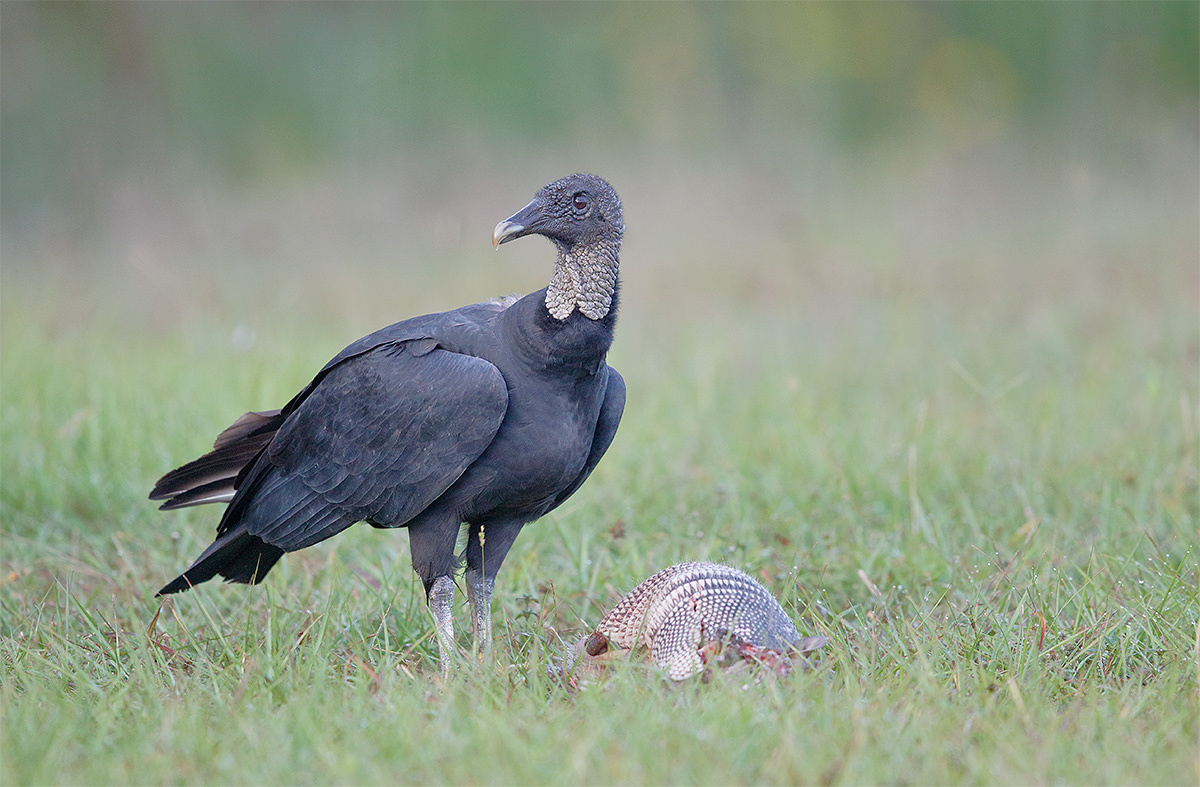
|
|
This image was created at 8:29am in the shade of some woods along the main road on the clear morning of October 31, 2014. I used the Canon EF 600mm f/4L IS II USM lens and a beta version of the Canon EOS 7D Mark II . ISO 800. Evaluative metering +1 stop as framed: 1/640 sec. at f/4 in Manual mode.
One sensor to the left of the central Sensor/AI Servo Surround/Rear Focus AF on the bird’s neck was active at the moment of exposure. Click here to see the latest version of the Rear Focus Tutorial. Click on the image to see a larger version.
From the Sequoia with the lens supported by the BLUBB (my custom-designed, hand made Big Lens Ultimate Bean Bag). When working on a beanbag with a long lens and re-composing be absolutely sure that the focusing ring does not rest on the beanbag lest you throw off accurate focus when re-composing. Otherwise, be sure to be in active AI Servo AF as I was here.
Black Vulture with road-killed armadillo
|
Serendipitous Road Kill
I came across this single Black Vulture on a road killed armadillo on my way home after a short session with the cranes down by the lake. I positioned my vehicle across the center median so that I could best parallel the subject. This drew a few strange looks from the early morning exercise walkers and cyclists. I was having lots of fun when a woman in some type of large four wheel maintenance vehicle driving off the road on the the wrong side of road drove right at the bird, scared it off, and gave me a dirty look as she rode by. You gotta love it. Heck, I had lots of work to do anyway.
Image Design Question
Why did I take the time to raise the window 5 inches?
|
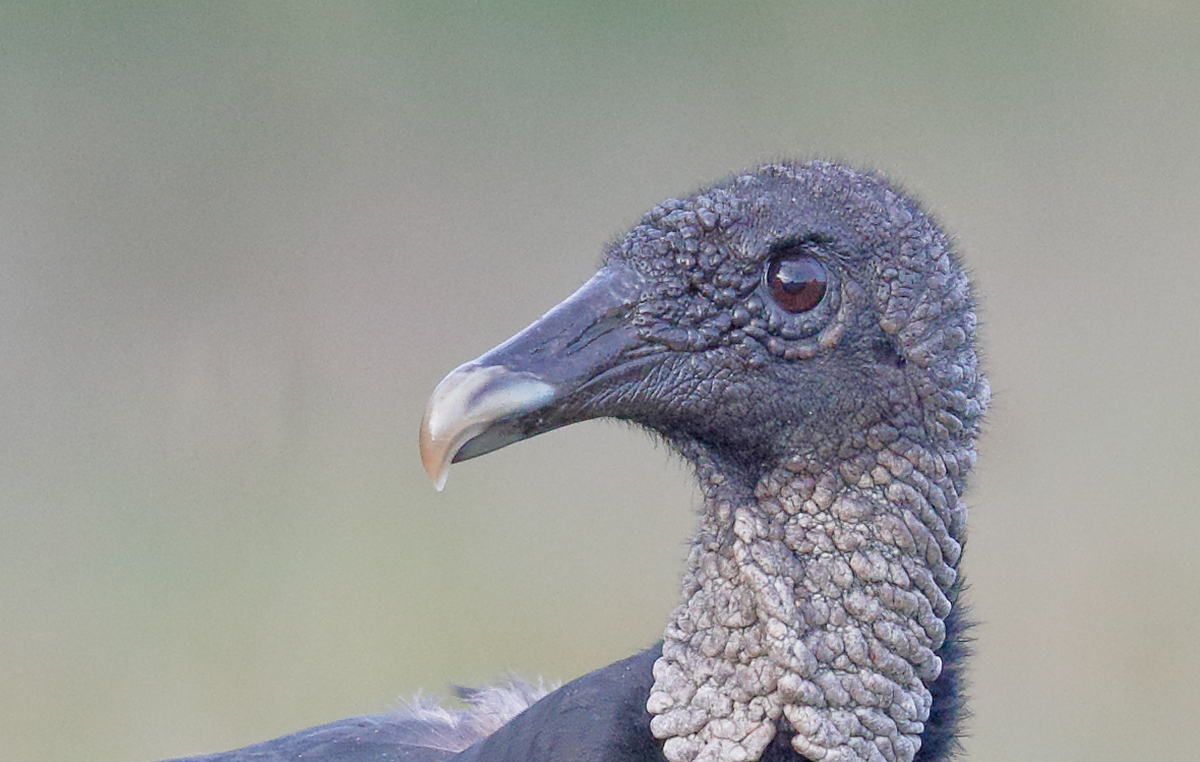
|
|
This JPEG represents an unsharpened 100% view of the optimized image file above. The fine grained noise in the background is easily dealt with using Image > Blur > Surface Blur as taught to me by Denise Ippolito and as detailed in Digital Basics.
|
The 100% View
The JPEG above represents an unsharpened 100% view of the optimized image file that opened this blog post. There was no other Noise Reduction applied other then the NR applied during the RAW conversion in DPP 4. The RAW file was about 1/2 stop underexposed. What do you think of the noise and image quality at ISO 800?
|
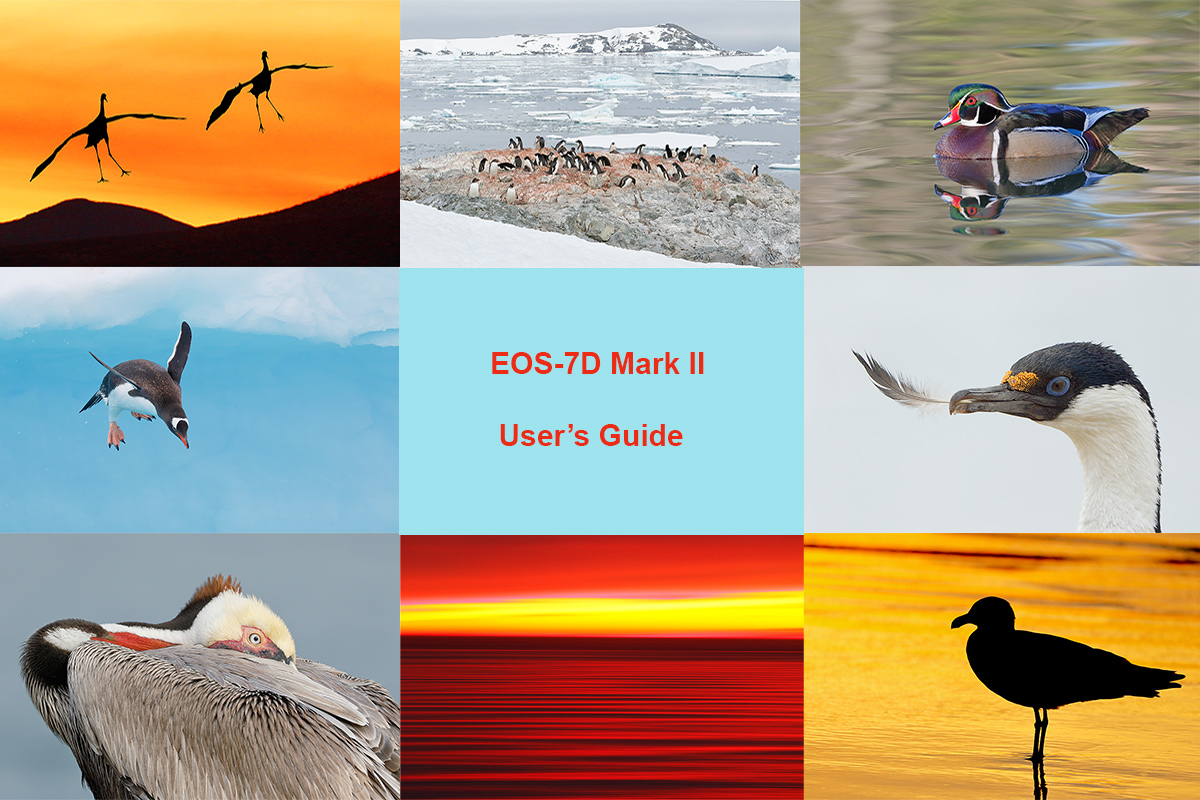
|
|
You can purchase your copy of the 7D Mark II User’s Guide in the BAA Online Store here for $59.
|
7D Mark II User’s Guide/400 Sold; Nothing But Praise
Purchase your in the BAA Online Store here for $59. This is the highest priced user’s guide ever, surpassing the 5D II User’s Guide that is priced at $50. Why? I did twice as much work preparing the 7D II Guide. It required many weeks of writing, many dozens of hours of study and research, not to mention hundreds of hours in the field trying to figure out the best 7D II settings while doing what I love to do best, photographing birds and nature. The camera is quite complex. Many thanks to both Rudy Winston and Chuck Westfall of Canon USA for their help in getting me through the stickiest parts.
The guide contains 23,196 words in 516 paragraphs. There are 24 photos and screen captures interspersed in the main body of the text and a gallery of 23 additional 7D II images that show what the camera is capable of with a variety of lens and lens/TC combinations.
The Great Strength of the 7D Mark II User’s Guide
The very great strength of the 7D Mark II User’s Guide is the coverage of the autofocus system. I review in detail all of the items on the five pink AF Menus. Most important of these is the Custom Case setting (at AF 1) that I have developed over time and currently use for all of my bird photography. On the recently concluded Hooptie Deux Spoonbills and more IPT John Johnson of Naples, FL mentioned that he was having trouble producing sharp flight images. I set up my Custom Case on his camera, and within minutes he was amazed at the sharp results that he was getting…. While skill, strength, fine motor control, and superior hand eye coordination are all factors that will influence your success as a flight photographer, you can have all of the preceding in spades but if your camera is not set up properly much of your effort will be in vain….
What Else is in the Guide?
In the 7D Mark II User’s Guide you will learn everything that I know about the important topics listed below, and better yet, I explain the options for each along with my reasons for choosing a specific setting in a specific situation.
Handling the WHITEs
The top LCD and all camera control buttons
7D Mark II drive modes
How to manually select an AF sensor
Choosing an AF Area Selection Mode; how and why (includes extensive detail)
Moving the AF point or Zone
The creation of in-camera Multiple Exposures and in-camera HDR images (includes extensive detail)
Live View Shooting and AF choices (all new in the 7D II)
Menu Item Access
Coverage of almost all Menu Items and Custom Functions including the following: Image Quality, Auto Lighting Optimizer, Lens aberration corrections settings, Highlight Tone Priority, AF Configuration Tool (as above, this includes details on the custom setting that I use), Acceleration/deceleration tracking, Tracking sensitivity, Lens drive when AF impossible, Orientation linked AF point (I love this feature), Highlight alert, Histogram display–do you know how to access both histograms at once?, Auto rotate, Image Jump, LCD Brightness, Info button display options, Custom Shooting Modes set-up, ISO Safety shift, using the Q button, setting up rear focus, and setting up your My Menu feature (among others).
The guide is–of course–written in my informal, easy-to-follow style.
Please note: Some Menu items are not covered in this guide for one of several reasons:
They deal only with the creation of movies (not covered)
They are irrelevant to nature photography.
After spending hours studying the 7D II Instruction Manual and consulting others I have no clue as to the purpose or the reason for the existence of a given feature.
Though I recommend that the irrelevant and confusing items be left at the default settings, I do, in most cases, I refer you to the relevant page in the 7D II Instruction Manual. If you follow up, it just might turn out that you are a lot smarter than me. In those cases I would love to hear from you via e-mail. So far none of the above have prevented me from creating many spectacular images with my 7D II.
Please note that this guide does not contain a table of contents or an index. To search the document for a given topic simply hit Control F to search. When the Find box pops up, simply type the term that you are looking for into the field and hit Next. This will allow you to find what you are looking for quickly and efficiently.
If you purchase the 7D II UG and it helps you to create better images, please feel free to send no more than two 1200 pixel wide or 900 pixel tall sharpened JPEGs to me via e-mail along with your comments. I will be glad to do a short critique if so requested. Otherwise, feedback via e-mail or blog comment is always appreciated.
Facebook
Be sure to like and follow BAA on Facebook by clicking on the logo link upper right. Tanks a stack!
Support the BAA Blog. Support the BAA Bulletins: Shop B&H here!
We want and need to keep providing you with the latest free information, photography and Photoshop lessons, and all manner of related information. Show your appreciation by making your purchases immediately after clicking on any of our B&H or Amazon Affiliate links in this blog post. Remember, B&H ain’t just photography!
…..
Amazon.com
Those who prefer to support BAA by shopping with Amazon may use this link:
Amazon Canada
Many kind folks from north of the border, eh, have e-mailed stating that they would love to help us out by using one of our affiliate links but that living in Canada and doing so presents numerous problems. Now, they can help us out by using our Amazon Canada affiliate link by starting their searches by clicking here. Many thanks to those who have written.
Typos
In all blog posts and Bulletins, feel free to e-mail or to leave a comment regarding any typos or errors. Just be right :).
June 24th, 2015 Stuff
Pretty much everything is sorted out for the upcoming sold-out UK Puffins and Gannets IPT. Our rental vehicles are all set as is our luggage transport truck. And the folks at the cottages are expecting us. Both denise and I are a lot more excited than we should be about getting back into the puffins.
I spent the rest of the day answering e-mails and working on a few images including the one featured in today’s blog post. I enjoyed a late swim followed fairly closely by an ice bath. This blog post, which took me about 1 1/2 hours to assemble, is the 166th in a row. It was published just after 5:30am on Wednesday, June 24, 2015. We fly to Edinburgh, Scotland on Sunday so it is getting time to start thinking about packing….
Selling Your Used Photo Gear Through BIRDS AS ART
Selling your used (or like-new) photo gear through the BAA Blog or via a BAA Online Bulletin is a great idea. We charge only a 5% commission. One of the more popular used gear for sale sites charges a minimum of 20%. Plus assorted fees! Yikes. The minimum item price here is $500 (or less for a $25 fee). If you are interested please e-mail with the words Items for Sale Info Request cut and pasted into the Subject line :). Stuff that is priced fairly–I offer free pricing advice, usually sells in no time flat. In the past few weeks we have sold nearly everything in sight. Do know that prices on some items like the EOS-1D Mark IV, the old Canon 500mm, the EOS-7D, and the original 400mm IS DO lens have been dropping steadily. You can see the complete listings here. Do know that Steve Leimberg’s 400 DO sold instantly as predicted….
Brand New Listing
Used Canon EF 300mm f/2.8 L IS II Lens
Arash Hazeghi is offering a used Canon EF 300mm f/2.8 L IS II lens in like-new condition for $5400. The sale includes the lens hood, the rear cap, the lens strap, the Canon lens trunk (hard case) with keys, A LensCoat Real Snow camo cover, and a LensCoat front lens cover (a $120 value). All packed in original Canon box and sent to you via Fed Ex insured Ground shipping. Your item will not ship until your check clears unless other arrangements are made.
Please contact Arash by e-mail at e-mail or by phone at 650-353-1866 (Pacific time zone). Photos of the lens and sample RAW files can be provided upon request.
The 300 II is amazingly sharp and deadly. It can easily be hand held by most folks including me. It is sick sharp even with the 2X TC. It is versatile. And with or without the 1.4X III TC is is a superb flight lens. Unlike me, Arash takes very good care of his gear. artie
|
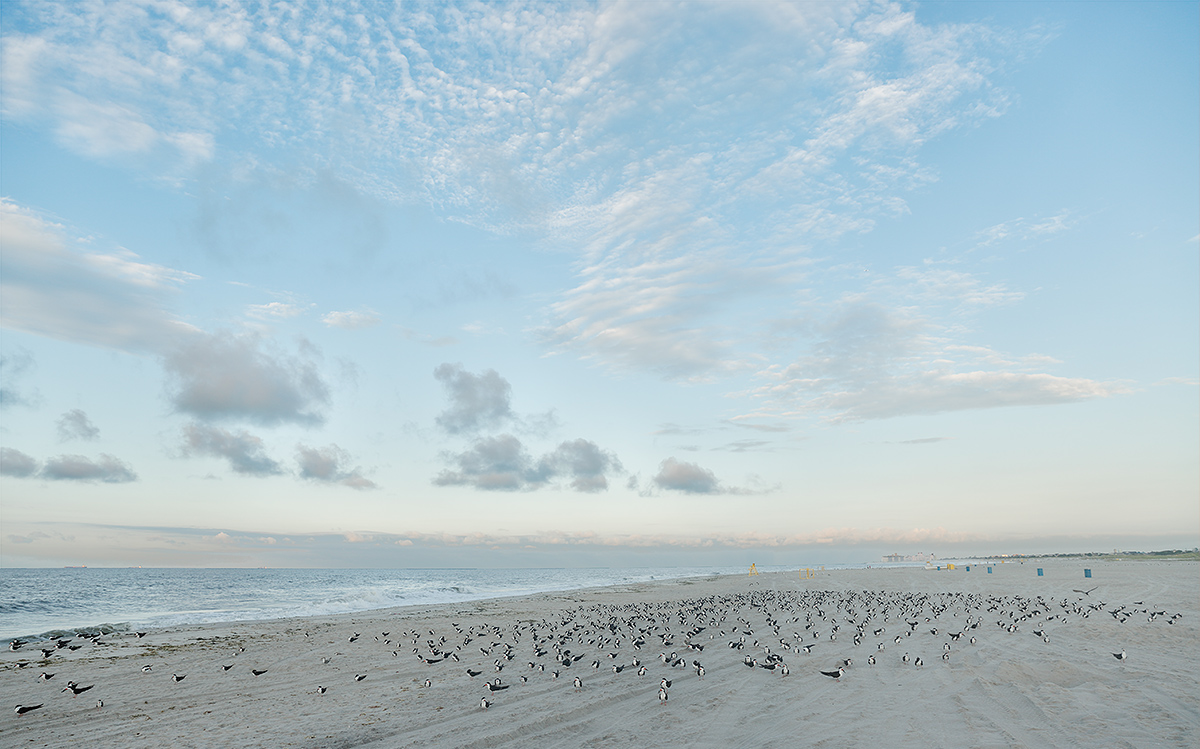
|
|
This image was created on last year’s Nickerson Beach IPT with the hand held Canon EF 24-70mm f/2.8L II USM lens (as 24mm) and the Canon EOS 5D Mark III. ISO 100. Evaluative metering +2 1/3 stops: 1/320 sec. at f/4. WB: 7500 K.
Center AF point/AI Servo Expand/Rear Focus AF on the nearest skimmer and re-compose. Click here to see the latest version of the Rear Focus Tutorial. Click on the image to see a larger version.
Black Skimmer flock in soft light
|
24mm for Birds
At times, I like to take a walk with a lens that I do not use a lot and see what I do. I guess that seeing this big flock of skimmers spread out on the beach with the lovely skies might have prompted me to grab the 24-70 II. In any case, I added lots of light to the exposure making sure to expose well to the right. As we preach here most every day.
Really Neat…
What is really neat about this image is that the foreground to sky ratio is almost perfectly 1 to 3. It’s funny that the standard advice, “Place the horizon either 1/3 or 2/3 of the way into the frame,” works well even when you are not totally conscious of it in the field.
Why a Light-toned Image Created in Soft Light Should Look Like Crap on the Rear LCD
It is always best to expose as far to the right as possible while avoiding significant blinkies to achieve the largest possible file with the most data while reducing noise. Then simply bring the image into Photoshop and adjust the tonality until you are pleased with the look.
The Image Optimization
After converting the image in DPP 4 as always, I brought the image into Photoshop. I selected the sky and put it on its own layer. I went into NIK’s Viveza where I increased the structure about 40 points, darkened the selection 20 points, and increased the saturation about 20 points. This left a dark line along parts of the horizon so I added a Regular Layer Mask, worked large, and painted away the dark line. Then I did a bit of clean-up on the left side of the image right near the surf line by removing parts of two skimmers that were clipped by the frame edge. Lastly I selected only the beach and pulled the curve up a bit to lighten it. I tried some of my NIK 50-50 on the sand but it brought up too much unwanted detail even when I reduced the opacity to 10% so I simply trashed that layer.
Digital Basics
Everything that I did to optimize today’s image is covered in detail in my Digital Basics File–written in my easy-to-follow, easy-to-understand style. Are you tired of making your images look worse in Photoshop? Digital Basics File is an instructional PDF that is sent via e-mail. It includes my complete digital workflow, dozens of great Photoshop tips, details on using all of my image clean-up tools, the use of Contrast Masks, several different ways of expanding and filling in canvas, all of my time-saving Keyboard Shortcuts, Quick Masking, Layer Masking, and NIK Color Efex Pro basics, Contrast Masks, Digital Eye Doctor techniques, using Gaussian Blurs, Tim Grey Dodge and Burn, a variety of ways to make selections, how to create time-saving actions, the Surface Blur (background noise reduction) settings as taught to me by Denise Ippolito, and tons more.
|

|
|
You can order your copy of “The Photographers’ Guide to Canon Digital Photo Professional 4.0” (aka the DPP 4 Raw Conversion eGuide) by Arash Hazeghi and Arthur Morris by clicking here.
|
The DPP 4 eGuide (PDF)
Learn how and why I and many other discerning photographers choose and use only DPP 4 to convert their Canon RAW files in the DPP 4 RAW Conversion Guide by Arash Hazeghi and yours truly. The latest version supports all of the newer Canon camera bodies and several older models including the EOS-7D and the EOS-1D Mark IV. The DPP IV Guide is the ideal companion to the 7D Mark II User’s Guide, a runaway best seller.
|

|
|
The strange thing is that when I lived in New York, I never knew about this amazing and consistently productive location.
|
Nickerson Beach/JBWR (possibly…)/Black Skimmer/Oystercatcher/migrant shorebird IPT: August 13-16, 2015. 3 1/2 DAYS: $1399.
Meet and greet on the evening of WED August 12. Limit 10/Openings 3.
Most of our seven photo sessions will be spent at Nickerson beach photographing the nesting Black Skimmers. In flight, sometimes battling. Carrying fish. Chicks of varying sizes from a very few just-hatched to lots of fledglings. It is likely that we will get to see some Great Black-backed Gulls preying on the juvenile skimmers. They swallow them whole. There will be lots of gulls to photograph as well as some Common Terns. Locally breeding shorebird species include American Oystercatcher–pretty much guaranteed, Willet, which is likely, and Piping Plover, which is probable but we need to get lucky with those to get close….
Save a space by calling Jim or Jen at the office and arranging to leave your deposit of $499. I hope to see you there.
JBWR?
If local conditions are ideal we may visit Jamaica Bay Wildlife Refuge to photograph southbound migrant shorebirds on one or possibly two mornings. Even if we do not visit JBWR we should get some good chances with the migrant shorebirds at the beach, especially Sanderling and Semipalmated Plover. Red Knot and others are possible.
|

|
|
As you can see, the oystercatchers are quite tame at Nickerson. And we will get you up early and we will stay out late.
|
Jamaica Bay Wildlife Refuge In-the-field Instructional Photo Workshop/Scouting Session. August 12, 2015. Morning only: $250. Cheap!
The tide will be pretty good at the East Pond…. If I learn that conditions there are un-photographable we will do Nickerson Beach as a back-up. This will work either as an add-on for out of town folks coming for the IPT above or as a stand alone session. Either way, you will, as always, learn a ton. And we might even get some good images.
Facebook
Be sure to like and follow BAA on Facebook by clicking on the logo link upper right. Tanks a stack!
Support the BAA Blog. Support the BAA Bulletins: Shop B&H here!
We want and need to keep providing you with the latest free information, photography and Photoshop lessons, and all manner of related information. Show your appreciation by making your purchases immediately after clicking on any of our B&H or Amazon Affiliate links in this blog post. Remember, B&H ain’t just photography!
…..
Amazon.com
Those who prefer to support BAA by shopping with Amazon may use this link:
Amazon Canada
Many kind folks from north of the border, eh, have e-mailed stating that they would love to help us out by using one of our affiliate links but that living in Canada and doing so presents numerous problems. Now, they can help us out by using our Amazon Canada affiliate link by starting their searches by clicking here. Many thanks to those who have written.
Typos
In all blog posts and Bulletins, feel free to e-mail or to leave a comment regarding any typos or errors. Just be right :).
June 23rd, 2015 Stuff
Today was mostly an off day but I did take an ice bath in the early afternoon. This blog post, which took me about 2 1/2 hours to assemble, is the 165th in a row. It was published just before 6:30am on Tuesday, June 23, 2015.
Selling Your Used Photo Gear Through BIRDS AS ART
Selling your used (or like-new) photo gear through the BAA Blog or via a BAA Online Bulletin is a great idea. We charge only a 5% commission. One of the more popular used gear for sale sites charges a minimum of 20%. Plus assorted fees! Yikes. The minimum item price here is $500 (or less for a $25 fee). If you are interested please e-mail with the words Items for Sale Info Request cut and pasted into the Subject line :). Stuff that is priced fairly–I offer free pricing advice, usually sells in no time flat. In the past few weeks we have sold nearly everything in sight. Do know that prices on some items like the EOS-1D Mark IV, the old Canon 500mm, the EOS-7D, and the original 400mm IS DO lens have been dropping steadily. You can see the complete listings here. Do know that Steve Leimberg’s 400 DO sold instantly as predicted…. Todays items should sell quickly as well.
Price Reduction
Used Canon EF 100-400 f 4.5-5.6 L IS Lens
Price reduced a total of $300 on 6/22/2015!
Multiple IPT veteran Jack Panzeca is offering a used Canon EF 100-400 f 4.5-5.6 L IS lens in very good + condition for $699 including insured shipping via UPS Ground to US addresses only. The tripod collar has one small scratch. The sale includes the original tough fabric case, the original box, the front and rear caps, the lens hood, and the strap. Your gear will be shipped only after your check clears.
Please contact Jack via e-mail or by phone at 817 819 1756. Central Time Zone.
The 100-400 is a versatile intermediate telephoto zoom lens with 1,000+ uses. It makes a great starter lens especially for folks who do general nature and wildlife in addition to birds. I’ve sold 100s of images made with a 1-4 and denise loved hers for many years forsaking it only recently for the Canon EF 70-200mm f/2.8L IS II USM lens. Jack’s 100-400 is priced to sell. artie
Please Remember to shop the BAA Online Store, and to use our Affiliate Links 🙂
To show your appreciation for my continuing efforts here, we ask, as always, that you use our the B&H and Amazon affiliate links on the right side of the blog for all of your purchases. B&H is recommended for you major photography gear purchases, Amazon for your household, entertainment, and general purpose stuff. Please check the availability of all photographic accessories in the BIRDS AS ART Online Store, especially the Mongoose M3.6 tripod heads, Gitzo tripods, Wimberley heads and plates, LensCoats and accessories, and the like. We sell only what I have used, have tested, and can depend on. We will not sell you junk. We know what you need to make creating great images easy and fun. And we are always glad to answer your gear questions via e-mail. I just learned that my account was suspended during my absence; it should be up and running by Monday at the latest.
I would of course appreciate your using our B&H affiliate links for all of your major gear, video, and electronic purchases. For the photographic stuff mentioned in the paragraph above we, meaning BAA, would of course greatly appreciate your business. Here is a huge thank you to the many who have been using our links on a regular basis and visiting the BAA Online store as well.
|
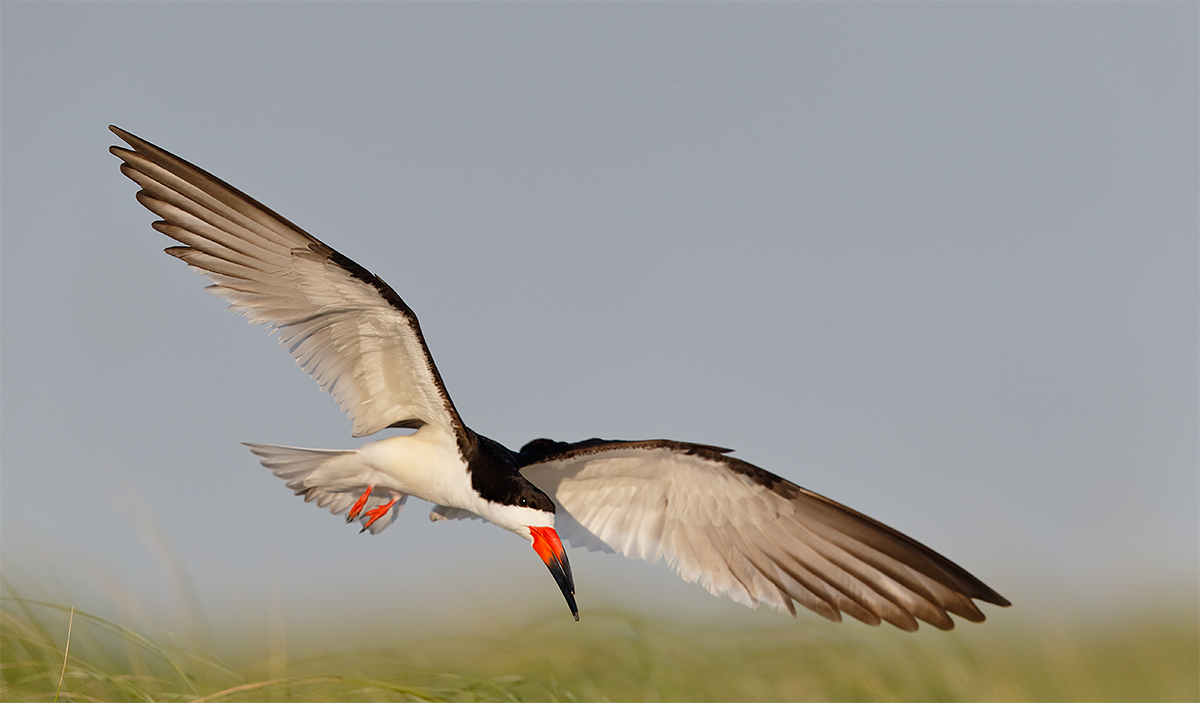
|
|
This image was created on last August’s Nickerson Beach IPT with the tripod-mounted Canon EF 600mm f/4L IS II USM lens, the Canon Extender EF 1.4X III, and the Canon EOS-1D X. ISO 500. Evaluative metering +1 1/3 stops off the sky: 1/2000 sec. at f/5.6. AWB.
61-Point Automatic Selection/AI Servo/Rear Focus AF as framed was active at the moment of exposure and as you can see in the first screen capture below, failed miserably at getting an active AF point on the subject but yielded a sharp image anyway…. Click here to see the latest version of the Rear Focus Tutorial. Click on the image to see a larger version.
Black Skimmer: adult returning to nest in beach grass
|
Black Skimmer Flight
With winds from the south or the west in the afternoons there are almost always lots of opportunities to photograph the skimmers in flight. Here I was sitting behind my lowered tripod in an effort to frame the birds just above the beach grass. Standing at full height for this image would have yielded a less intimate photo with a complete green background that would have been much more in focus (and much less pleasing) than the BKGR in today’s image. Do consider learning a ton about photographing beach nesting birds by joining me on the Nickerson Beach/JBWR(?) IPT this August. Scroll down for details.
|
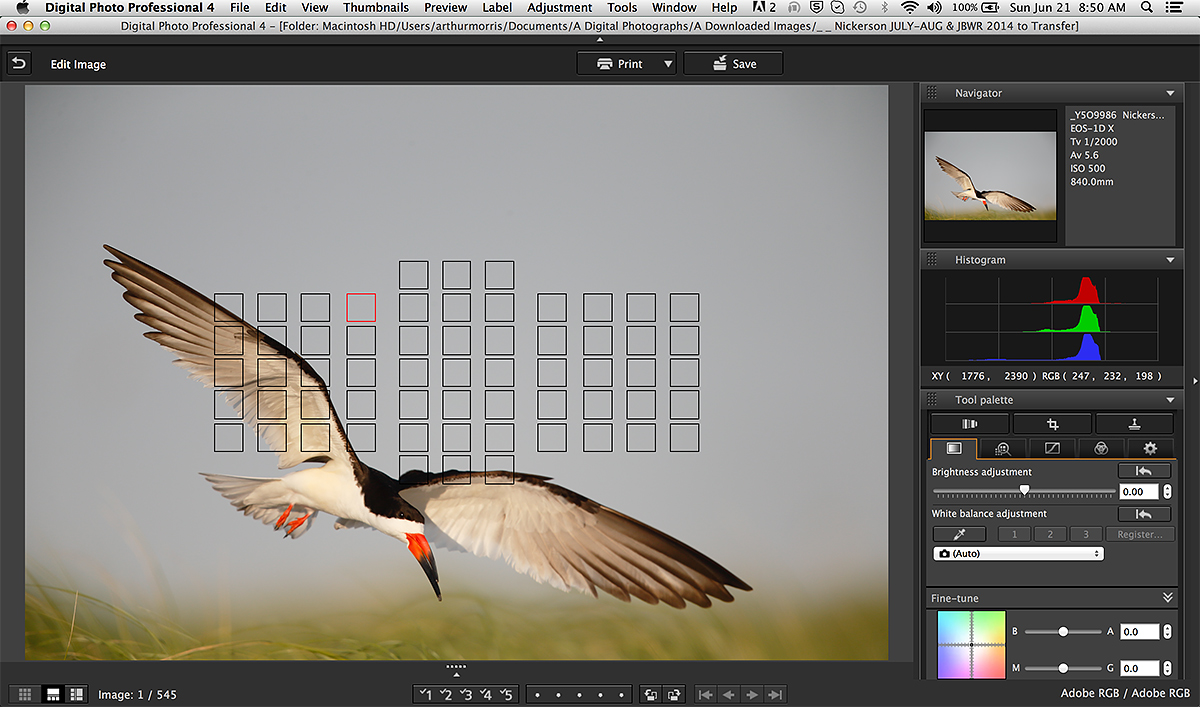
|
DPP 4 Screen Capture #1
|
61-Point Automatic Selection AF
Note that although 61-Point Automatic Selection AF seems to have failed miserably here–the active AF sensor (illuminated in red above) was nowhere near the bird, the resulting image was fairly sharp on the eye. I credit that in part to the great AF system of the 1D X and to my personalized Custom Case 3 settings that are designed to keep AF tracking accurately even when the active sensor (whether caused by AF system error as here, or by human error and frailties, as is often the case). To learn my Custom Case 3 settings and everything else that you need to know about AF with the 1d X, you are directed to our EOS-1D X Autofocus Guide.
Our User’s Guides for both the 7D II and the 5D III contain the same information. You can check them both out by scrolling down here.
DPP 4 Screen Capture #1
Note here that before any adjustments were made, with the cursor on what I accurately perceived as the brightest WHITEs,that the RGB values read 247, 232, 198. As this image was made late in the afternoon the RED value was too high for my tastes and the WHITEs were somewhat lacking in fine feather detail.
DPP 4 Adjustments
First I chose the RAW conversion recipe for “1D X ISO 400 “by going Edit > Read and paste recipe from file (as first suggested in a comment by someone here; many thanks!) Then I dragged the Fine Tune slider to the left away from the warm RED and YELLOW tones; though this is something that I do only rarely it worked like a charm here. Then I moved the Brightness slider to the left to -1.7, moved the Highlight slider one to the left to -1, and moved the Shadow slider one to the right to +1. Then Command D to convert.
|
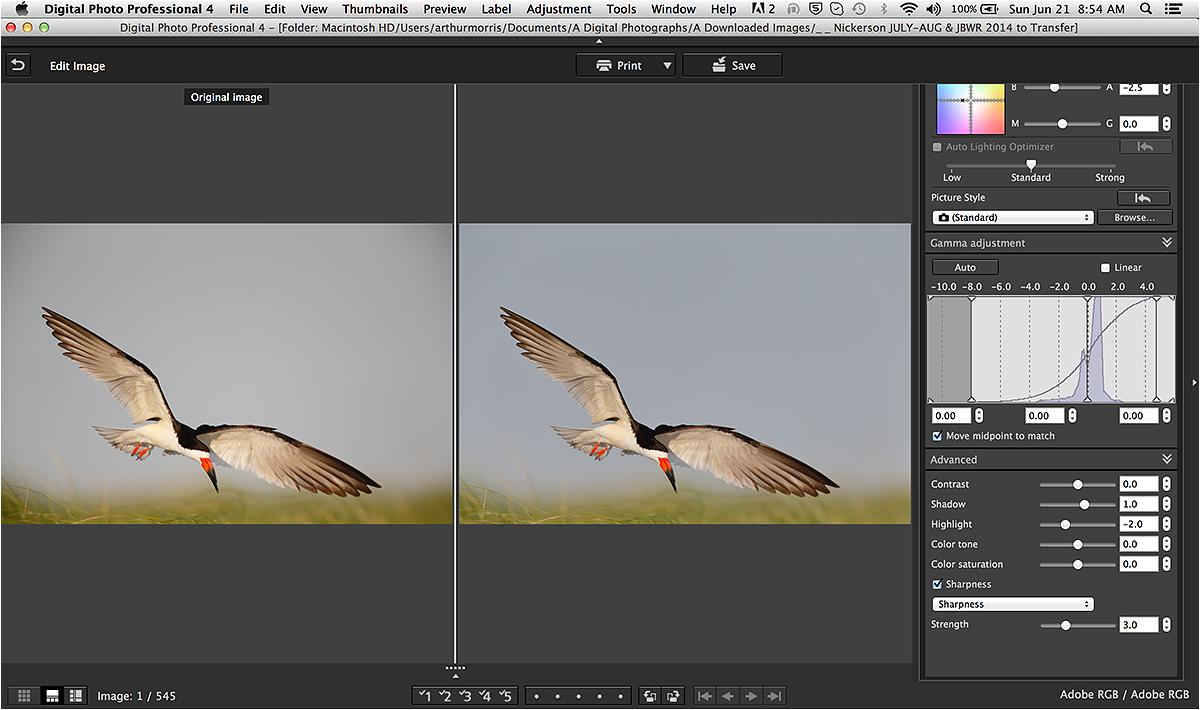
|
DPP 4 Screen Capture #2
|
DPP 4 Screen Capture #2
Here we see the Before and After Preview windows in DPP 4. Note that DPP 4 easily eliminated all the vignetting, the darkened corners of the frame caused by using a super-telephoto lens at the wide open aperture. In addition, you can clearly see that my work on color balance was quite effective: though the light still looks sweet the RED and YELLOW color casts have been removed and the color looks much more natural. Note also the truer, bluer sky.
|

|
|
You can order your copy of “The Photographers’ Guide to Canon Digital Photo Professional 4.0” (aka the DPP 4 Raw Conversion eGuide) by Arash Hazeghi and Arthur Morris by clicking here.
|
The DPP 4 eGuide (PDF)
Learn how and why I and many other discerning photographers choose and use only DPP 4 to convert their Canon RAW files in the DPP 4 RAW Conversion Guide by Arash Hazeghi and yours truly. The latest version supports all of the newer Canon camera bodies and several older models including the EOS-7D and the EOS-1D Mark IV. The DPP IV Guide is the ideal companion to the 7D Mark II User’s Guide, a runaway best seller.
|

|
|
The strange thing is that when I lived in New York, I never knew about this amazing and consistently productive location.
|
Nickerson Beach/JBWR (possibly…)/Black Skimmer/Oystercatcher/migrant shorebird IPT: August 13-16, 2015. 3 1/2 DAYS: $1399.
Meet and greet on the evening of WED August 12. Limit 10/Openings 5.
Most of our seven photo sessions will be spent at Nickerson beach photographing the nesting Black Skimmers. In flight, sometimes battling. Carrying fish. Chicks of varying sizes from a very few just-hatched to lots of fledglings. It is likely that we will get to see some Great Black-backed Gulls preying on the juvenile skimmers. They swallow them whole. There will be lots of gulls to photograph as well as some Common Terns. Locally breeding shorebird species include American Oystercatcher–pretty much guaranteed, Willet, which is likely, and Piping Plover, which is probable but we need to get lucky with those to get close….
Save a space by calling Jim or Jen at the office and arranging to leave your deposit of $499. I hope to see you there.
JBWR?
If local conditions are ideal we may visit Jamaica Bay Wildlife Refuge to photograph southbound migrant shorebirds on one or possibly two mornings. Even if we do not visit JBWR we should get some good chances with the migrant shorebirds at the beach, especially Sanderling and Semipalmated Plover. Red Knot and others are possible.
|

|
|
As you can see, the oystercatchers are quite tame at Nickerson. And we will get you up early and we will stay out late.
|
Jamaica Bay Wildlife Refuge In-the-field Instructional Photo Workshop/Scouting Session. August 12, 2015. Morning only: $250. Cheap!
The tide will be pretty good at the East Pond…. If I learn that conditions there are un-photographable we will do Nickerson Beach as a back-up. This will work either as an add-on for out of town folks coming for the IPT above or as a stand alone session. Either way, you will, as always, learn a ton. And we might even get some good images.
Facebook
Be sure to like and follow BAA on Facebook by clicking on the logo link upper right. Tanks a stack!
Support the BAA Blog. Support the BAA Bulletins: Shop B&H here!
We want and need to keep providing you with the latest free information, photography and Photoshop lessons, and all manner of related information. Show your appreciation by making your purchases immediately after clicking on any of our B&H or Amazon Affiliate links in this blog post. Remember, B&H ain’t just photography!
…..
Amazon.com
Those who prefer to support BAA by shopping with Amazon may use this link:
Amazon Canada
Many kind folks from north of the border, eh, have e-mailed stating that they would love to help us out by using one of our affiliate links but that living in Canada and doing so presents numerous problems. Now, they can help us out by using our Amazon Canada affiliate link by starting their searches by clicking here. Many thanks to those who have written.
Typos
In all blog posts and Bulletins, feel free to e-mail or to leave a comment regarding any typos or errors. Just be right :).
June 22nd, 2015 Stuff
On Saturday I began working on a huge backload of image files from various trips; I have never been so far behind as I am now…. It is a huge job but somebody has to do it. As soon as I finish this blog post I will be on the phone to the UK double checking our vehicle rentals and our luggage transport arrangements for the Puffins and Gannets IPT. Those who would like to join us in the early summer of 2016 on the next puffin trip are invited to shoot me an e-mail.
I spent a good part of the day watching the US Open golf; at 5:15am on Monday morning it is down to the last three holes and–after he holed a big-breaking 19 foot putt on 16, it is looking very much like another Jordan Spieth victory….
So much for easy: with a 3-shot lead and two holes to play, Spieth just double-bogeyed 17 while Oosthuizen birdied 18 to tie after a backnine birdie barrage and a 29 on the incoming nine…. Young Jordan needs to birdie 18 to avoid a playoff…. Yikes!
This Just In!
Congrats to Jordan Spieth on winning the first two legs of the 2015 Grand Slam. He birdied 18, just missing his eagle putt. But it looked like a sure playoff as Dustin Johnson birdied 17 and had a chance to win outright with a 12 foot, four inch eagle putt on 18. He missed that and then missed the short come-backer to give Spieth the win. He celebrated with his Dad and family on Father’s Day. Whew and wow! The ending left pretty much everyone in shock.
I had time for my core exercises and another long swim. This blog post, which took me about two hours to asssemble, is the 165th in a row. It was published just before 5:30am on Monday, June 22, 2015.
Check it out!
BIRDS AS ART on the B&H Explora blog here.
Please Remember to shop the BAA Online Store, and to use our Affiliate Links 🙂
To show your appreciation for my continuing efforts here, we ask, as always, that you use our the B&H and Amazon affiliate links on the right side of the blog for all of your purchases. B&H is recommended for you major photography gear purchases, Amazon for your household, entertainment, and general purpose stuff. Please check the availability of all photographic accessories in the BIRDS AS ART Online Store, especially the Mongoose M3.6 tripod heads, Gitzo tripods, Wimberley heads and plates, LensCoats and accessories, and the like. We sell only what I have used, have tested, and can depend on. We will not sell you junk. We know what you need to make creating great images easy and fun. And we are always glad to answer your gear questions via e-mail. I just learned that my account was suspended during my absence; it should be up and running by Monday at the latest.
I would of course appreciate your using our B&H affiliate links for all of your major gear, video, and electronic purchases. For the photographic stuff mentioned in the paragraph above we, meaning BAA, would of course greatly appreciate your business. Here is a huge thank you to the many who have been using our links on a regular basis and visiting the BAA Online store as well.
|
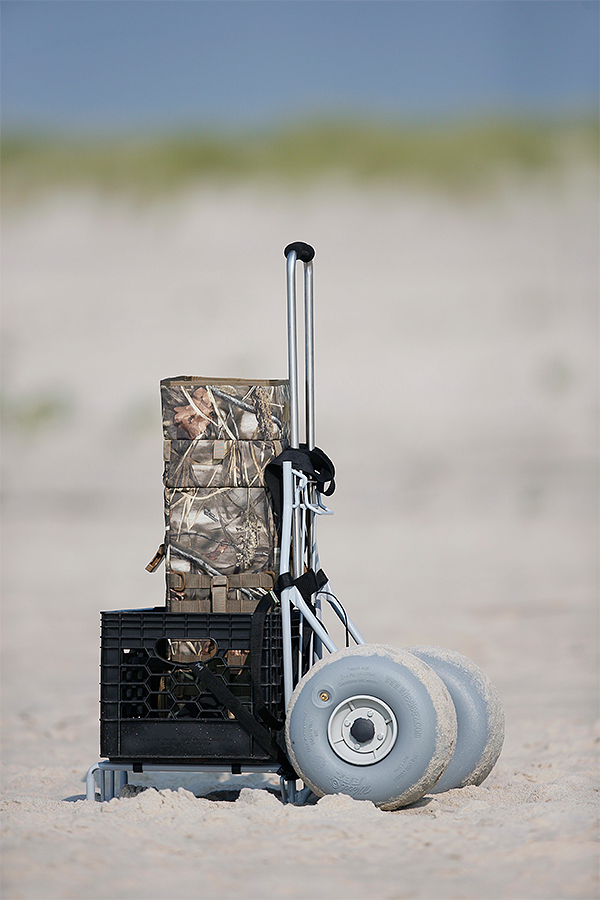
|
|
Wheeleez has extended my long lens beach photography career by at least two decades….
|
Wheeleez
While I love my Eckla Beach Rolly (and accessories) for the boardwalks at places like the St. Augustine Alligator Farm and Gatorland, the thin tires/wheels are not very good on the beach. The always generous Dr. Greg Gulbransen introduced me to Wheeleez last summer. I considered stocking them in the BAA Online Store but the box that they come is in huge. After months of searching, I finally found them on Amazon. Folks kind enough to order theirs using the logo link below can help support my efforts here on the blog and the work that I do virtually every day of the year answering your e-mail questions.
In Practice
As most regular readers here know, I have been rehabbing my right shoulder for about ten years, the result of incorrectly carrying a big telephoto lens, with the full weight of the rig resting–you guessed it–on my right shoulder. I am sure that I will be rehabbing the shoulder until they nail the box shut. In any case there was a point about 18 months ago when I thought that long lens photography at the beach–one of my great pleasures–was a thing of the past. Then I received the gift of a Wheeleez. It quickly became a Godsend for me. I love to bring a ton of stuff to the beach. Though the opening image here shows a light load, actually only the fabulous Lens Coat 4Xpandable Long Lens Bag, I routinely carry a ton of stuff easily in my Wheeleez.
I actually own two Wheeleez-es (please do not ask me what is the correct spelling of the plural of Wheeleez), one is at my Mom’s on Long Island, the other here in Florida. I often head out to the beach with the 600 II, the Canon EF 300mm f/2.8L IS II, the 100-400mm IS L II or the Canon EF 70-200mm f/2.8L IS,, my tripod with a Mongoose M3.6 on top, a wide angle lens or two, and often the 100mm f/2.8L Macro lens. All of the smaller items are protected either by LensCoat Hoodies, LensBags, etc. or by my woolen watch caps. The stretchy strap that the include with the Wheeleez is great for keeping everything in place. Greg uses heavy duty rubberized wire ties to do the same. Be sure to place the smaller items in the bottom of the crate or inside the Lens Coat 4Xpandable Long Lens Bag so that they do not bounce out. You will also have room for a bottle of spring water and a bit of extra clothing that can serve as padding. If I need to carry an even larger load I go to my X-trahand Vest from Vested Interest. Please e-mail for info on that.
Plastic Milk Crate
You need a sturdy plastic lattice-type milk crate to make the whole thing work. Why lattice type? They include two straps. I use only one. I thread it through the open spaces near the bottom of the crate to secure it. If you do not have one in the garage or the attic the one linked to above is perfect.
Negative Reviews
There are many negative reviews of the Wheeleez on Amazon, along with many positive ones. I own two and have never had any type of problem. A friend on Long Island has owned one for more than two years and has never had a problem. It is rather large and I am lucky to have an SUV. Even with my Mom’s Honda, though, I am able to fold it down and get it in the back seat without having to undo the strap…. That is a blessing.
Perhaps the boys and girls are simply loading too, too many kegs of beer on their beach carts….
Facebook
Be sure to like and follow BAA on Facebook by clicking on the logo link upper right. Tanks a stack!
Support the BAA Blog. Support the BAA Bulletins: Shop B&H here!
We want and need to keep providing you with the latest free information, photography and Photoshop lessons, and all manner of related information. Show your appreciation by making your purchases immediately after clicking on any of our B&H or Amazon Affiliate links in this blog post. Remember, B&H ain’t just photography!
…..
Amazon.com
Those who prefer to support BAA by shopping with Amazon may use this link:
Amazon Canada
Many kind folks from north of the border, eh, have e-mailed stating that they would love to help us out by using one of our affiliate links but that living in Canada and doing so presents numerous problems. Now, they can help us out by using our Amazon Canada affiliate link by starting their searches by clicking here. Many thanks to those who have written.
Typos
In all blog posts and Bulletins, feel free to e-mail or to leave a comment regarding any typos or errors. Just be right :).
June 21st, 2015 Stuff
On Saturday I answered more than 100 e-mails. I sent an e-mail to the UK Puffins and Gannets IPT group catching up on last minute travel details and admitting a mistake as to our meeting time at the airport on Monday, June 30th. For some reason I thought that Denise and I landed at 7:00am rather than the actual 9:45am. Thanks to Denise who spotted my mind-set error.
Those who would like to join us in the early summer of 2016 on the next puffin trip are invited to shoot me an e-mail. Those who would like details on the Bears Catching Salmon IPT (late August into early September) are invited to do the same.
I did my core exercises, enjoyed a long but relaxing swim, and plan on an ice bath at about 6:00pm. This blog post, which took me about 90 minutes to prepare, is the 164th in a row. It was published at just before 7:00am on Sunday, June 21, 2015.
Please Remember to shop the BAA Online Store, and to use our Affiliate Links 🙂
To show your appreciation for my continuing efforts here, we ask, as always, that you use our the B&H and Amazon affiliate links on the right side of the blog for all of your purchases. B&H is recommended for you major photography gear purchases, Amazon for your household, entertainment, and general purpose stuff. Please check the availability of all photographic accessories in the BIRDS AS ART Online Store, especially the Mongoose M3.6 tripod heads, Gitzo tripods, Wimberley heads and plates, LensCoats and accessories, and the like. We sell only what I have used, have tested, and can depend on. We will not sell you junk. We know what you need to make creating great images easy and fun. And we are always glad to answer your gear questions via e-mail. I just learned that my account was suspended during my absence; it should be up and running by Monday at the latest.
I would of course appreciate your using our B&H affiliate links for all of your major gear, video, and electronic purchases. For the photographic stuff mentioned in the paragraph above we, meaning BAA, would of course greatly appreciate your business. Here is a huge thank you to the many who have been using our links on a regular basis and visiting the BAA Online store as well.
Selling Your Used Photo Gear Through BIRDS AS ART
Selling your used (or like-new) photo gear through the BAA Blog or via a BAA Online Bulletin is a great idea. We charge only a 5% commission. One of the more popular used gear for sale sites charges a minimum of 20%. Plus assorted fees! Yikes. The minimum item price here is $500 (or less for a $25 fee). If you are interested please e-mail with the words Items for Sale Info Request cut and pasted into the Subject line :). Stuff that is priced fairly–I offer free pricing advice, usually sells in no time flat. In the past few weeks we have sold nearly everything in sight. Do know that prices on some items like the EOS-1D Mark IV, the old Canon 500mm, the EOS-7D, and the original 400mm IS DO lens have been dropping steadily. You can see the complete listings here. Do know that Steve Leimberg’s 400 DO sold instantly as predicted…. Todays items should sell quickly as well.
Brand New Listings
Used Canon EF 100-400 f 4.5-5.6 L IS Lens
Mike Lawie is offering a used Canon EF 100-400 f 4.5-5.6 L IS lens in excellent condition for $699 including insured shipping via UPS Ground to US addresses only. The sale includes the original tough fabric case, the original box, the front and rear caps, the lens hood, and the strap. Your gear will be shipped only after your check clears unless other arrangements (such as payment via PayPal) are made.
Please contact Mike via e-mail or by phone at 1-231-798-2474 Eastern time.)
The 100-400 is a versatile intermediate telephoto zoom lens with 1,000+ uses. It makes a great starter lens especially for folks who do general nature and wildlife in addition to birds. I’ve sold 100s of images made with my old 1-4 and denise loved hers for many years and as I did forsaking it only recently for the Canon EF 100-400mm f/4.5-5.6L IS II USM lens. I still own my Canon EF 70-200mm f/2.8L IS II USM lens; I am trying to talk denise into keeping hers for low light situations….
Used Sigma 105mm f2.8 EX DG OS HSM Macro Lens
Mike Lawie is also offering a used Sigma 105mm f2.8 EX DG OS HSM Macro in mint condition for $425. The sale includes the original box, the front & rear lens caps, the lens hood, the hood adapter, and insured shipping via UPS Ground to US addresses only.
Please contact Mike via e-mail or by phone at 1-231-798-2474 Eastern time.) Your item will not ship until your check clears unless other arrangements (such as payment via PayPal) are made.
Though I have never used this lens I have heard only good things about it, especially with regards to image sharpness. I love the Canon version of this lens but this one is less than half the price.
Used Canon EF 100-400 f 4.5-5.6 L IS Lens
Dale Lorenzen is offering a used Canon EF 100-400mm f 4.5-5.6 L IS lens in excellent condition for $699–another record low BAA price. The black plastic lens hood has a few smudge marks on it. The sale includes the original tough fabric case, the original box, the instruction manual, the front and rear caps, the lens hood, the lens strap, and insured shipping via UPS or Fed-Ex Ground to US addresses only. Your gear will be shipped only after your check clears.
Please contact Dale via e-mail or by phone at 630-742-3309. Eastern Time Zone.
The 100-400 is a versatile intermediate telephoto zoom lens with 1,000+ uses. It makes a great starter lens especially for folks who do general nature and wildlife in addition to birds. I’ve sold 100s of images made with a 1-4 and denise loved hers for many years forsaking it only recently. Dale’s 100-400 is priced to sell. artie
|
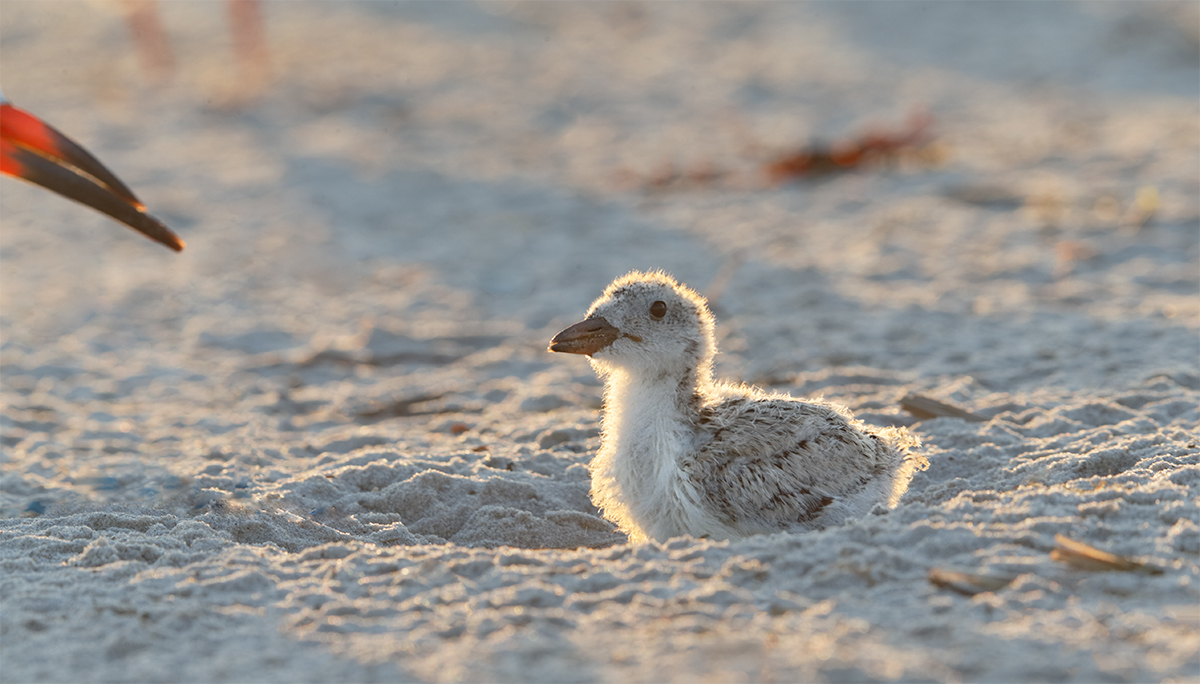
|
|
This image was created last August on the Nickerson Beach IPT with the tripod-mounted Canon EF 600mm f/4L IS II USM lens, the Canon Extender EF 2X III, and the Canon EOS-1D X. ISO 400. Evaluative metering +1 stop: 1/125 sec. at f/10.
Center AF point/AI Servo Expand (by necessity)/Rear Focus AF as framed and release. Click here to see the latest version of the Rear Focus Tutorial. Click on the image to see a larger version.
Black Skimmer/backlit chick, Nickerson Beach, Long Island, NY
|
Skimmer Chicks and Backlight
In a typical years, there will be lots of Black Skimmer chicks of all ages from tiny to fledged in mid-August. Do consider joining me on this summer’s IPT; see below for details. If you cannot make my August trip, do know that Denise has a few openings on her second July Nickerson Beach workshop; check it out by scrolling down here. Her first workshop is sold out.
Though I love to point my shadow at the bird, there are times when doing the exact opposite can pay big dividends. If you know exactly where to be when at Nickerson Beach in the early morning, you can take advantage of some great opportunities. The funny thing is that the sun, my subject, and I, am almost always on the same line. Only the order differs…. In front lit situations, it’s the sun behind me, me, and then the subject, all on a straight line. For the strongest backlight, me, the subject, and then the sun should all be on the same line. Because of background considerations with the image above, I was working about 30 degrees off of direct backlight; note the angle of the shadow of the bird whose legs appear in the top left of the frame.
The Image Clean-up
After converting the RAW image in DPP 4, my main concern was with the degree of beach clean-up. Pristine beaches in beach nesting bird colonies are pretty much non-existent so deciding how much to clean and how much to leave was indeed a fine line in the sand….
I used my usual triumvirate of clean-up tools for the bulk of the work: the Patch Tool, the Clone Stamp Tool, and the Spot Healing Brush. Plus a few small Quick Masks refined by Regular Layer Masks on a few difficult areas. Then I selected the bird only (including the rim light) with the Quick Selection Tool and applied my NIK Color EFEX Pro 50-50 recipe, 50% Tonal Contrast and 50% Detail Extractor. That layer was also refined with the addition of a Regular Layer Mask; I painted away 50% of the effect on the shaded plumage areas but left at 100% to tame the rim light.
Too Much, Not Enough, or Just Right?
All are invited to leave a comment regarding the degree of clean-up. Would you have done more or less? Or no clean-up at all? Do let us know why you feel the way that you do.
Would you have left the bill of the adult on the left frame edge? Why or why not?
Digital Basics
Everything that I did to optimize today’s image is covered in detail in my Digital Basics File–written in my easy-to-follow, easy-to-understand style. Are you tired of making your images look worse in Photoshop? Digital Basics File is an instructional PDF that is sent via e-mail. It includes my complete digital workflow, dozens of great Photoshop tips, details on using all of my image clean-up tools, the use of Contrast Masks, several different ways of expanding and filling in canvas, all of my time-saving Keyboard Shortcuts, Quick Masking, Layer Masking, and NIK Color Efex Pro basics, Contrast Masks, Digital Eye Doctor techniques, using Gaussian Blurs, Tim Grey Dodge and Burn, a variety of ways to make selections, how to create time-saving actions, the Surface Blur (background noise reduction) settings as taught to me by Denise Ippolito, and tons more.
APTATS I & II
Learn the details of advanced Quick Masking techniques in APTATS I. Learn Advanced Layer Masking Techniques in APTATS II. Mention this blog post and apply a $5 discount to either with phone orders only. Buy both APTATS I and APTATS II and we will be glad to apply at $15 discount with phone orders only. Please call Jim or Jennifer at 863-692-0906 weekdays to order.
|

|
|
You can order your copy of “The Photographers’ Guide to Canon Digital Photo Professional 4.0” (aka the DPP 4 Raw Conversion eGuide) by Arash Hazeghi and Arthur Morris by clicking here.
|
The DPP 4 eGuide (PDF)
Learn how and why I and many other discerning photographers choose and use only DPP 4 to convert their Canon RAW files in the DPP 4 RAW Conversion Guide by Arash Hazeghi and yours truly. The latest version supports all of the newer Canon camera bodies and several older models including the EOS-7D and the EOS-1D Mark IV. The DPP IV Guide is the ideal companion to the 7D Mark II User’s Guide, a runaway best seller.
|

|
|
The strange thing is that when I lived in New York, I never knew about this amazing and consistently productive location.
|
Nickerson Beach/JBWR (possibly…)/Black Skimmer/Oystercatcher/migrant shorebird IPT: August 13-16, 2015. 3 1/2 DAYS: $1399.
Meet and greet on the evening of WED August 12. Limit 10/Openings 5.
Most of our seven photo sessions will be spent at Nickerson beach photographing the nesting Black Skimmers. In flight, sometimes battling. Carrying fish. Chicks of varying sizes from a very few just-hatched to lots of fledglings. It is likely that we will get to see some Great Black-backed Gulls preying on the juvenile skimmers. They swallow them whole. There will be lots of gulls to photograph as well as some Common Terns. Locally breeding shorebird species include American Oystercatcher–pretty much guaranteed, Willet, which is likely, and Piping Plover, which is probable but we need to get lucky with those to get close….
Save a space by calling Jim or Jen at the office and arranging to leave your deposit of $499. I hope to see you there.
JBWR?
If local conditions are ideal we may visit Jamaica Bay Wildlife Refuge to photograph southbound migrant shorebirds on one or possibly two mornings. Even if we do not visit JBWR we should get some good chances with the migrant shorebirds at the beach, especially Sanderling and Semipalmated Plover. Red Knot and others are possible.
|

|
|
As you can see, the oystercatchers are quite tame at Nickerson. And we will get you up early and we will stay out late.
|
Jamaica Bay Wildlife Refuge In-the-field Instructional Photo Workshop/Scouting Session. August 12, 2015. Morning only: $250. Cheap!
The tide will be pretty good at the East Pond…. If I learn that conditions there are un-photographable we will do Nickerson Beach as a back-up. This will work either as an add-on for out of town folks coming for the IPT above or as a stand alone session. Either way, you will, as always, learn a ton. And we might even get some good images.
Facebook
Be sure to like and follow BAA on Facebook by clicking on the logo link upper right. Tanks a stack!
Support the BAA Blog. Support the BAA Bulletins: Shop B&H here!
We want and need to keep providing you with the latest free information, photography and Photoshop lessons, and all manner of related information. Show your appreciation by making your purchases immediately after clicking on any of our B&H or Amazon Affiliate links in this blog post. Remember, B&H ain’t just photography!
…..
Amazon.com
Those who prefer to support BAA by shopping with Amazon may use this link:
Amazon Canada
Many kind folks from north of the border, eh, have e-mailed stating that they would love to help us out by using one of our affiliate links but that living in Canada and doing so presents numerous problems. Now, they can help us out by using our Amazon Canada affiliate link by starting their searches by clicking here. Many thanks to those who have written.
Typos
In all blog posts and Bulletins, feel free to e-mail or to leave a comment regarding any typos or errors. Just be right :).
June 20th, 2015 Stuff
Friday was a relaxing day. I switched around some of my Alaska flights due to a change in travel plans. I finally, finally, finally, after a few Catch 22 nightmare scenarios, got things squared away with the National Trust memberships for the UK Puffins and Gannets IPT. Whew. Those who would like to join us in the early summer of 2016 are invited to shoot me an e-mail. Those who would like details on the Bears Catching Salmon IPT (late August into early September) are invited to do the same.
I enjoyed my core exercises, a long but relaxing swim, and an ice bath. This blog post, which took me about an hour and 15 minutes to prepare, is the 163rd in a row. It was published at just before 8:00am on Saturday, June 20, 2015.
Please Remember to shop the BAA Online Store, and to use our Affiliate Links 🙂
To show your appreciation for my continuing efforts here, we ask, as always, that you use our the B&H and Amazon affiliate links on the right side of the blog for all of your purchases. B&H is recommended for you major photography gear purchases, Amazon for your household, entertainment, and general purpose stuff. Please check the availability of all photographic accessories in the BIRDS AS ART Online Store, especially the Mongoose M3.6 tripod heads, Gitzo tripods, Wimberley heads and plates, LensCoats and accessories, and the like. We sell only what I have used, have tested, and can depend on. We will not sell you junk. We know what you need to make creating great images easy and fun. And we are always glad to answer your gear questions via e-mail. I just learned that my account was suspended during my absence; it should be up and running by Monday at the latest.
I would of course appreciate your using our B&H affiliate links for all of your major gear, video, and electronic purchases. For the photographic stuff mentioned in the paragraph above we, meaning BAA, would of course greatly appreciate your business. Here is a huge thank you to the many who have been using our links on a regular basis and visiting the BAA Online store as well.
Used Photography Gear for Sale
There has been lots of action on the Used Photography Gear page here lately. Stuff has been flying off the virtual shelves here almost every day; the following items have sold within the past month including four series II Canon super-telephotos in the past month:
Canon EF 400mm f/5.6L USM Lens and EF Extender 1.4X II (Teleconverter) sold by Steve Torna in one day on June 17, 2015.
Canon EF 24-70 f2.8L II USM Lens was sold by Dave Bourgaize for $1699 on June 15, 2015.
Canon EF 180mm f/3.5L USM Macro Lens sold by Carl Zanoni for $975 on June 14, 2015.
Canon 500 mm f/4L IS Lens (the old five) sold by Greg Asnis for $4999 on June 13, 2015.
Canon 500mm f/4L IS II USM lens sold by Clemens Vanderwerf for $7999 on June 10, 2015.
Two Canon 600mm f/4L IS lenses sold by Pat and Alan Lillich within a week of listing for $9500.
Canon 500mm f/4L IS II USM lens sold by Clemens Vanderwerf for $7999 on June 10, 2015.
Canon 300mm f/2.8L IS lens sold by Kevin Hice within two days are being listed for $4750.
Canon 500mm f/4L IS sold by Richard Rhudy for $4200.
Canon 100-400mm zoom lens sold by Barbara Garmon for
Canon EF 300mm f/2.8L IS II USM lens sold for $4999 by Jacques Bouvier on May 20, 2015.
Canon EF 70-200mm f/2.8L IS II sold by Carl Zanoni for $1649 on May 19, 2015.
Canon EF 100-400mm f/4.5-5.6L IS USM sold by Owen Peller for $799 on 5/19/15.
Canon EOS-1D Mark IV sold by Gerald Barrack for $1599 in May, 2015.
Canon EOS 7D DSLR Digital Camera Body (with battery grip) sold for $579 by Barbara Garmon on May 23, 2015.
You can see all of the current listings here.
Selling Your Used Photo Gear Through BIRDS AS ART
Selling your used (or like-new) photo gear through the BAA Blog or via a BAA Online Bulletin is a great idea. We charge only a 5% commission. One of the more popular used gear for sale sites charges a minimum of 20%. Plus assorted fees! Yikes. The minimum item price here is $500 (or less for a $25 fee). If you are interested please e-mail with the words Items for Sale Info Request cut and pasted into the Subject line :). Stuff that is priced fairly–I offer free pricing advice, usually sells in no time flat. In the past few months, we have sold just about everything in sight. Do know that prices on some items like the EOS-1D Mark IV, the old Canon 500mm, the EOS-7D, and the original 400mm IS DO lens have been dropping steadily.
Featured Listing/Priced Insanely to Sell Instantly
Canon 400mm f/4 IS DO USM Lens
The already lowest-price-ever has been reduced an astounding $700!
Sold almost instantly as predicted/Sale Pending
Multiple IPT veteran Stephan R. Leimberg is offering his used Canon 400mm f/4 IS DO USM Lens in excellent condition for $2999–shattering the lowest-price-ever for this item by miles. And unlike me, Steve takes perfect care of his gear. The sale includes the rear lens cap, the leather front hood, the original case, and insured shipping via UPS Ground. Please contact Steve via e-mail or phone at 904-491-0474 (eastern time). Please e-mail for photos. Your item will not ship until your check clears unless other arrangements are made.
I used this lens for several years with great success, especially for birds in flight and when working from various type of water craft. Gannets in Love was created with the 400 DO. You can see that one and 13 other killer images that I made with my 400 DO here. The title of that blog post is “The Canon 400mm f/4 IS DO Lens: Fourteen Images that Prove that the Internet Experts are Idiots.”
Seriously…
That could be you above. Join Denise Ippolito and me on the Lake Kerkini Dalmatian Pelicans IPT. Most every major contest including the BBC Wildlife Photographer of the Year and the Nature’s Best Windland Smith Rice International Awards photography contest feature one or more Dalmatian Pelicans. If you would like to join us please see item next for the complete details. We have room for you.
|
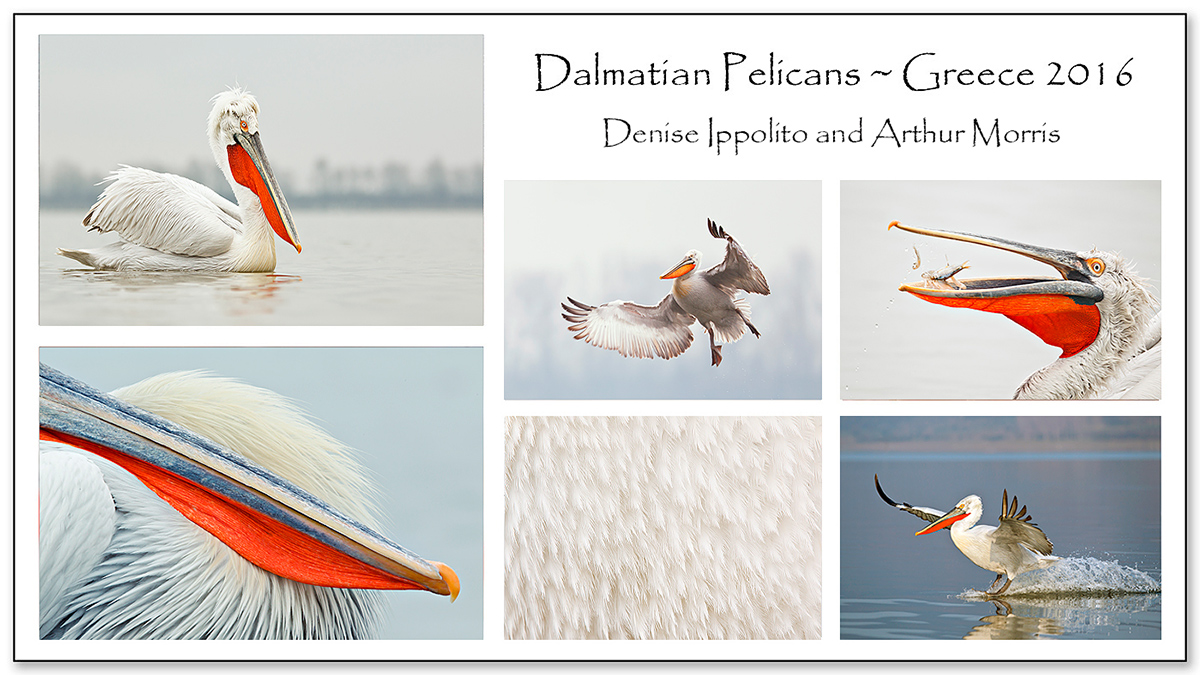
|
|
Images copyright 2011: Arthur Morris/BIRDS AS ART. Card design by Denise Ippolito.
|
Dalmatian Pelicans ~ Northern Greece
: A Creative Adventure/BIRDS AS ART Workshop/denise ippolito & arthur morris
. January 24th – 29th, 2016 ~ 5 Nights/ 4 Full days of photography: $2950. Limit: 6.
Important Note: Do Not Buy Your Flights Yet; this trip needs to fill to run.
Photograph beautiful Dalmatian Pelicans in Greece. Our trip will be from January 24-29th, 2016. Our hotel accommodations are located fifteen minutes from Lake Kerkini. This is a huge plus as we will be able to take advantage of great light at a moment’s notice. This location is well known as the best location on the planet to photograph these beautiful, common, and extremely photogenic birds. And we will enjoy tons of flight photography. Though your 70-200 will be your very best friend, you will be able to use almost every lens in your gear bag. Wide angle shots, close portrait work, flight shots, creative blurs- you name it. Our expert guide knows the area like the back of his hand; he guides some of the most world renowned photographers.
There will be in-the-field instructional photography sessions each morning and afternoon from the shore and we will enjoy extended small boat sessions. Image review and post processing sessions will be informal; we will cover a ton of information during both our in-the-field and indoor session. With two great leaders that only thing that will limit your learning is a lack of stamina.
More than 100 pairs of Dalmatian Pelicans nest on specially constructed platforms on the lake. They remain at the lake during the winter. During our time in Greece the Pelicans will be in their brightest and most impressive breeding plumage. The birds hang around the local fisherman and in addition, we purchase live bait to bring the pelicans close. They are silly tame as they have been begging fish from the locals for many decades.
The groups of Dalmatian Pelicans are often accompanied by single Great White Pelicans, Pygmy Cormorants and Great Cormorants.
The price of this IPT IS $2950.00 per person USD, based on double occupancy; The single supplement is $360. The workshop fee includes hotel accommodations, WiFi, breakfast, lunch and dinner daily, round trip transfers from Thessaloniki Airport, all ground transportation during trip, boat fees and lots of fish.
Not included: Round trip airfare to Thessaloniki Airport, alcoholic beverages, personal items including but not limited to laundry, phone, or fax services.
This workshop is strictly limited to 6 participants. A non-refundable deposit of $1000.00 is required to hold your spot for this workshop. Balances are are due on August 1st, 2015 and are also non-refundable. Payments in full are of course welcome at any time. All payments including the deposit must be made by check made out to “Arthur Morris.” Please be sure to check your calendar carefully. If we do not receive your check for the balance on or before the due date we will try to fill your spot from the waiting list. If your spot is filled, you will lose your deposit. If not, you can secure your spot by paying your balance.
Please note that even though we have secured a top notch guide this is somewhat of a scouting trip (as denise has never been). The price of next year’s trip will be considerably higher. There are only 2 slots open. This is an especially attractive deal for folks from Europe….
Please contact us via e-mail to check on availability or write with questions: artie or denise. All deposits and balances must be paid by personal check or money order made out to “Arthur Morris” and mailed to BIRDS AS ART, PO Box 7245, Indian Lake Estates, FL 33855. Overseas folks can, however, pay their deposits and balances by wire transfer; the registrant is responsible for the fees on both ends.
Travel Insurance Services offers a variety of plans and options. Included with the Elite Option or available as an upgrade to the Basic & Plus Options. You can also purchase Cancel for Any Reason Coverage that expands the list of reasons for your canceling to include things such as sudden work or family obligation and even a simple change of mind. You can learn more here: Travel Insurance Services. Do note that many plans require that you purchase your travel insurance within 14 days of our cashing your deposit check. Whenever purchasing travel insurance be sure to read the fine print carefully even when dealing with reputable firms like TSI.
We do hope that you can join us. artie and denise
Facebook
Be sure to like and follow BAA on Facebook by clicking on the logo link upper right. Tanks a stack!
Support the BAA Blog. Support the BAA Bulletins: Shop B&H here!
We want and need to keep providing you with the latest free information, photography and Photoshop lessons, and all manner of related information. Show your appreciation by making your purchases immediately after clicking on any of our B&H or Amazon Affiliate links in this blog post. Remember, B&H ain’t just photography!
…..
Amazon.com
Those who prefer to support BAA by shopping with Amazon may use this link:
Amazon Canada
Many kind folks from north of the border, eh, have e-mailed stating that they would love to help us out by using one of our affiliate links but that living in Canada and doing so presents numerous problems. Now, they can help us out by using our Amazon Canada affiliate link by starting their searches by clicking here. Many thanks to those who have written.
Typos
In all blog posts and Bulletins, feel free to e-mail or to leave a comment regarding any typos or errors. Just be right :).
June 19th, 2015 Stuff
I finally got my 2014 tax info off to the accountant. And I am almost done with the National Trust Memberships for the UK Puffins and Gannets IPT. I thought that that ordeal was complete but I got an e-mail on Friday morning that my credit card did not go through so I need to call them back….
This blog post, the 162nd in a row, took nearly three hours to prepare was published a bit after 8:00am on Friday June 19. I was simply too tired last night to finish it.
The Interactive Blog…
There are lots of questions in this blog post. All photographers can learn a ton, even those who will never ever photograph a dance recital. The more folks who leave a comment the more everyone will learn, especially with regards to the exposure questions.
Used Photography Gear
Steve Torna’s Canon EF 400mm f/5.6L USM Lens and his EF Extender 1.4X II (Teleconverter) sold for the full asking price in one day. Though the shelves are nearly bare right now there are still a few great items left at fair prices. See the complete listings here.
|
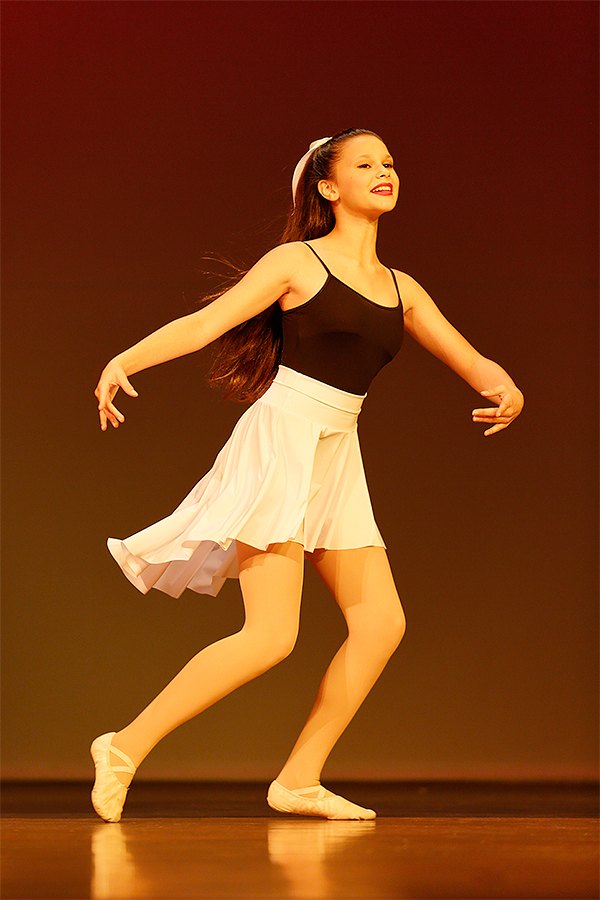
|
|
This image was created at the Hanken School of Dance Recital in Frostproof, FL on June 13 with the hand held Canon EF 70-200mm f/2.8L IS II USM lens (at 125mm) and the Canon EOS 5D Mark III. ISO 800. Evaluative metering -1/3 stop: 1/640 sec. at f/2.8 in Av Mode.
Three AF points up from the center AF point/One Shot/Rear Focus Spot AF as framed was active at the moment of exposure (as is always best when hand holding). The active AF point was on Maya’s right shoulder. Click here to see the latest version of the Rear Focus Tutorial. Click on the image to see a larger version.
Image #1: Maya Dancing in white
|
The Hanken School of Dance Recital
My only granddaughter (I have three grandsons), Maya Egenstener, daughter of Jennifer and Erik, has been taking dance lessons for about seven years. As you can see in the four images of her here, she loves it. And she is quite good. Image #8 reminds me that I started photographing her when she was one of the precious, much-too-cute tiny tots.
Exposure Question
Why -1/3 stop for image #1?
|
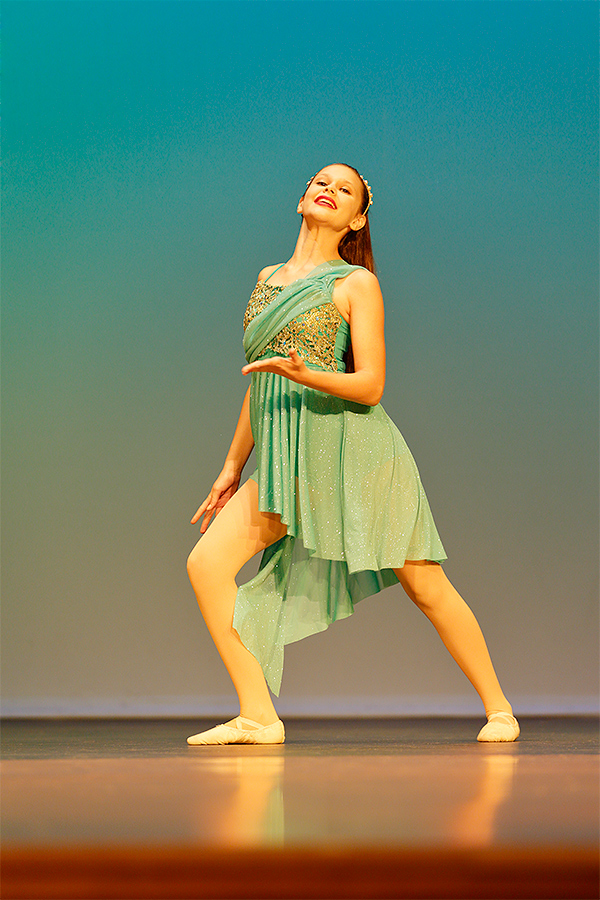
|
|
This image was created at the Hanken School of Dance Recital in Frostproof, FL on June 13 with the hand held Canon EF 70-200mm f/2.8L IS II USM lens (at 130mm) and the Canon EOS 5D Mark III. ISO 800. Evaluative metering +1/3 stop: 1/160 sec. at f/2.8.
65-Point Automatic Selection/AI Servo/Shutter Button AF as framed was active at the moment of exposure (as is always best when hand holding). The AF system selected an array of 5 active points that fell on Maya’s torso. Click on the image to see a larger version.
Image #2: Maya in light green standing pose
|
Why own the 70-200mm f/2.8L IS II if you own the 100-400 II?
Being able to work at f/2.8 in extreme low light conditions saves you 2 stops of ISO and can allow relatively fast shutter speeds as in nearly all of today’s images. Most of today’s images were created at ISO 800; had I been working with a 100-400 I would have had to have been at ISO 3200 to achieve the same shutter speed. No matter how good the high ISOs on a given camera are, you’d need to have your head examined if you chose ISO 3200 over ISO 800. And while today’s example are from an indoor dance recital, there are times in bird and and nature photography when the same principles apply. If you are working with tame birds or large mammals in extremely low light, the 70-200mm f/2.8L IS II is often the clear choice over even the new 100-400 II.
Though I own the 100-400 II, I am not and will not be selling my 70-200 f/2.8….
|
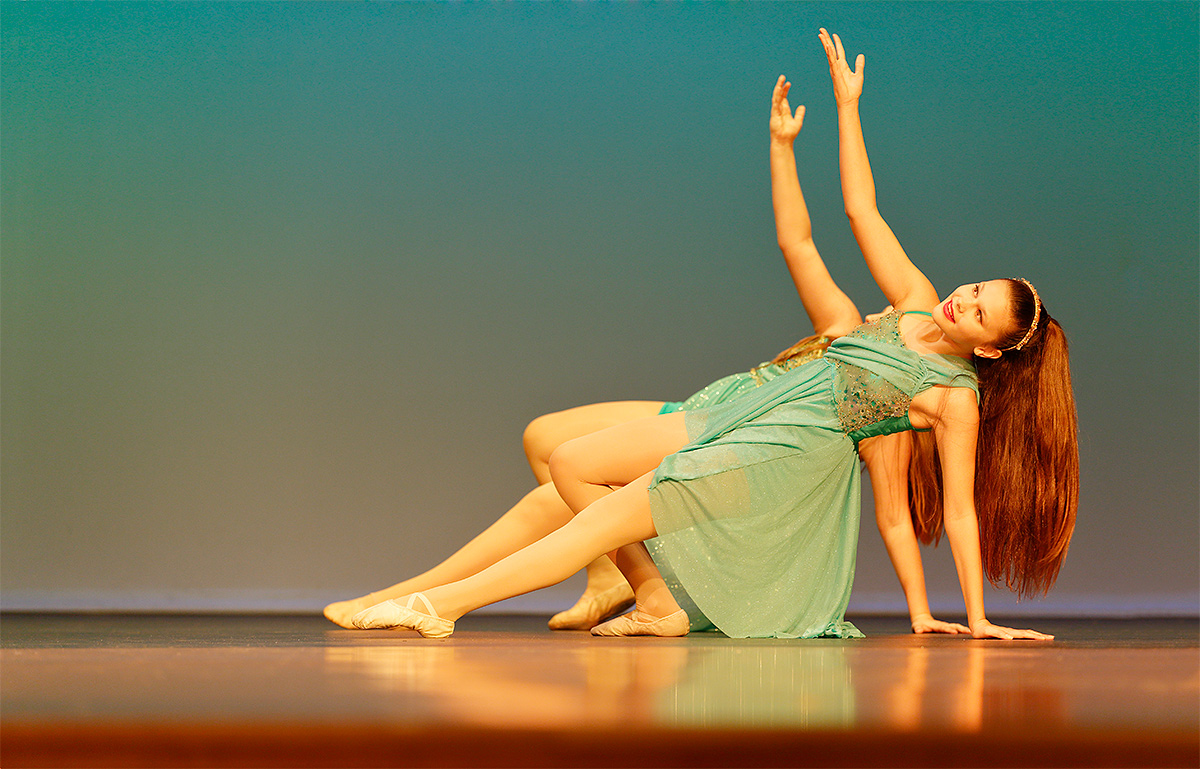
|
|
This image was created at the Hanken School of Dance Recital in Frostproof, FL on June 13 with the hand held Canon EF 70-200mm f/2.8L IS II USM lens (at 125mm) and the Canon EOS 5D Mark III. ISO 800. Evaluative metering +1/3 stop: 1/200 sec. at f/2.8 in Av Mode.
65-Point Automatic Selection/AI Servo/Shutter Button AF as framed was active at the moment of exposure (as is always best when hand holding). The AF system selected an array of 5 active points that fell on Maya’s near thigh. Click on the image to see a larger version.
Image #3: Maya in light green in repose
|
Losing the Red…
Because of the color of the lighting, all of the images were way too warm at AWB. I batch converted all of them in DPP 4 at K3300. In Photoshop, I reduced the RED and YELLOW saturation for each image about 10-15 points. I was happy with the color balance in each image.
Exposure Question
Why was +1/3 stop right for images #2 and #3?
|
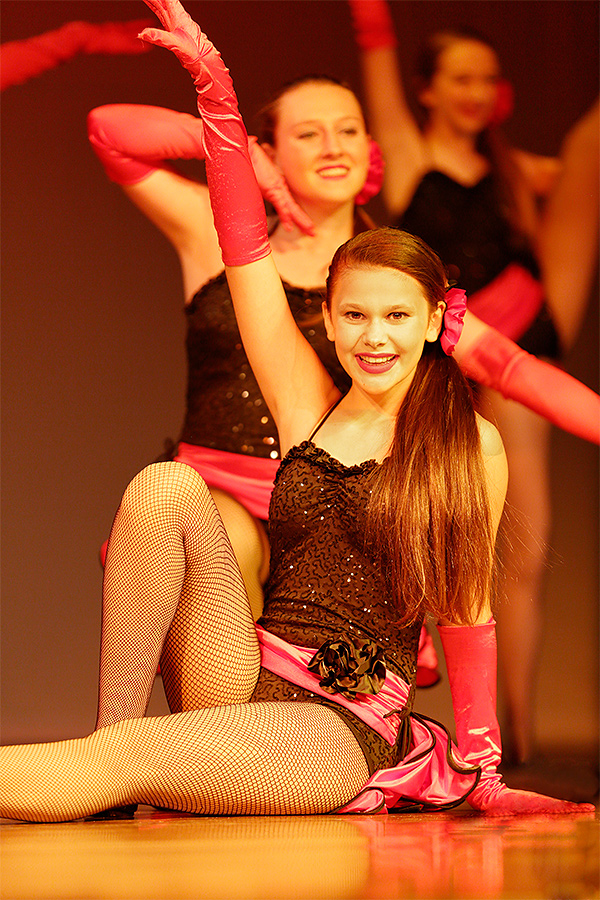
|
|
This image was created at the Hanken School of Dance Recital in Frostproof, FL on June 13 with the hand held Canon EF 70-200mm f/2.8L IS II USM lens (at 200mm) and the Canon EOS 5D Mark III. ISO 800. Evaluative metering at zero: 400 sec. at f/2.8.
65-Point Automatic Selection/AI Servo/Shutter Button AF as framed was active at the moment of exposure (as is always best when hand holding). The AF system selected a single point that fell on Maya’s hairline. Click on the image to see a larger version.
Image #4: Maya as showgirl
|
Your Favorite?
Which of the four images of Maya is your favorite? Please let us know why?
Exposure Question
Why no plus compensation for Image #4?
|
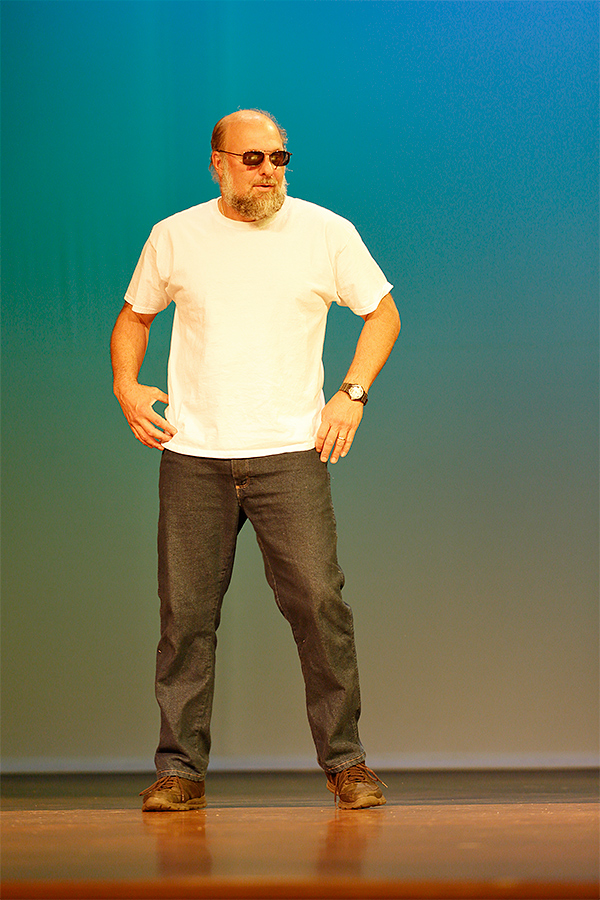
|
|
This image was created at the Hanken School of Dance Recital in Frostproof, FL on June 13 with the hand held Canon EF 70-200mm f/2.8L IS II USM lens (at 110mm) and the Canon EOS 5D Mark III. ISO 800. Evaluative metering +1/3 stop: 1/320 sec. at f/2.8 in Av mode.
65-Point Automatic Selection/AI Servo/Shutter Button AF as framed was active at the moment of exposure (as is always best when hand holding). The AF system selected an array of 2 active points in the top row that fell squarely on Erik’s face and glasses. Click on the image to see a larger version.
Image #5: Maya’s Dad Erik in the Dad’s Dance
|
The Dad’s Dances
For as long as I can remember, Jennifer’s husband Erik has danced a dance with Maya and participated in all the Dad’s Dances as well. Kudos to Erik. Jen and Erik met on Great Gull Island while they were working as volunteer tern researchers; it is hard to believe that that was a bit more than a quarter of a century ago….
|
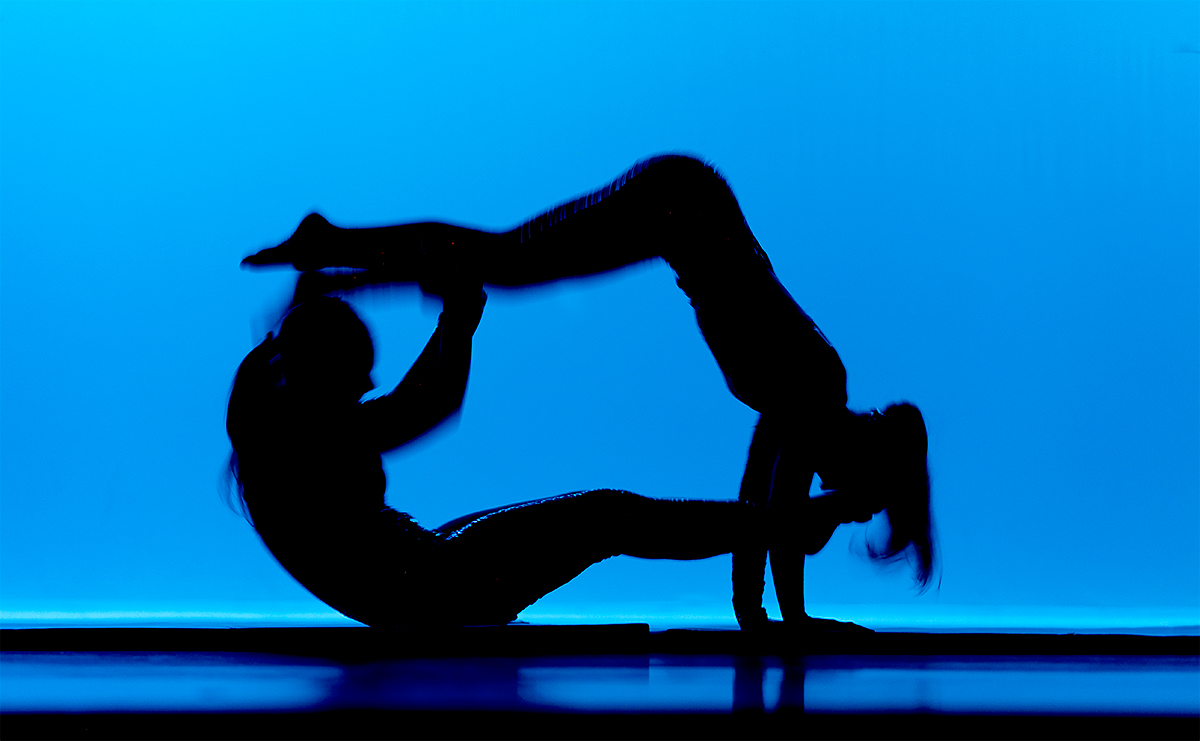
|
|
This image was created at the Hanken School of Dance Recital in Frostproof, FL on June 13 with the hand held Canon EF 70-200mm f/2.8L IS II USM lens (at 115mm) and the Canon EOS 5D Mark III. ISO 800. Evaluative metering +2/3 stop: 1/10 sec. at f/2.8.
65-Point Automatic Selection/AI Servo/Shutter Button AF as framed was active at the moment of exposure (as is always best when hand holding). The AF system selected 2 active points that fell on the near-thigh of the upper dancer. Click on the image to see a larger version.
Image #6: Dancer/Acrobat Silhouette
|
Shoot Now, Ask Question Later
When you see a potentially good image that might be there only for a fleeting second, push the shutter button. If you stop to make changes in your settings you will miss the opportunity nine out of ten times. I followed my own advice to create a lovely, slightly motion-blurred silhouette at a shutter speed of 1/10 sec. Not many would have recommended such a slow shutter speed. With the next frame in the series, the lights had come up. I am glad that I did not hesitate….
|
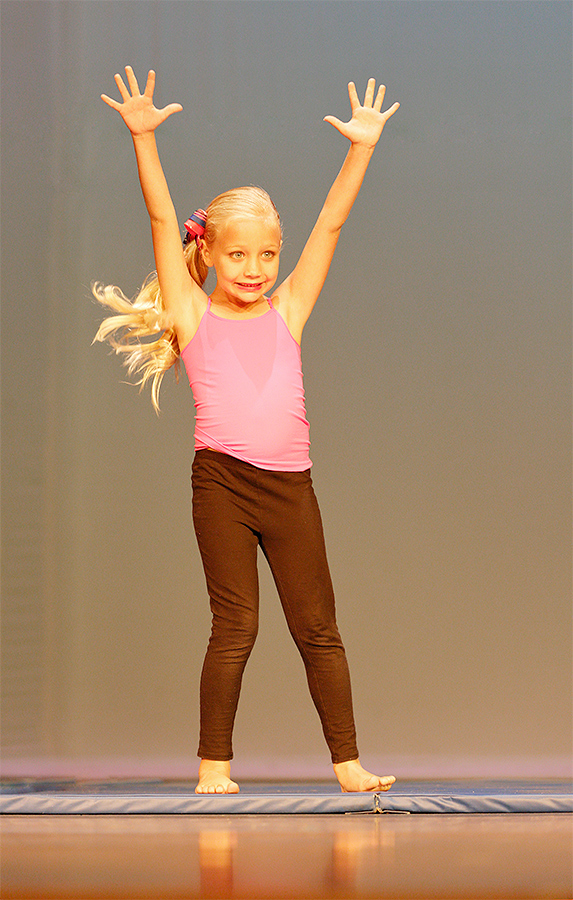
|
|
This image was created at the Hanken School of Dance Recital in Frostproof, FL on June 13 with the hand held Canon EF 70-200mm f/2.8L IS II USM lens, the Canon Extender EF 1.4X III, (at 180mm) and the Canon EOS 5D Mark III. ISO 1600. Evaluative metering +1/3 stop: 1/200 sec. at f/4.
65-Point Automatic Selection/AI Servo/Shutter Button AF as framed was active at the moment of exposure (as is always best when hand holding). The AF system selected a single active points that fell squarely on the dancers’s face. Click on the image to see a larger version.
Image #7: Excited young dancer
|
65-Point Automatic Selection…
Though most of the images presented here were made with 65-Point Automatic Selection and were pretty sharp, I will try to remember next year to go with Expand and will make an effort to get the selected AF point on the dancer’s face. The former approach is faster and more versatile, the latter should yield images that average a bit sharper.
|
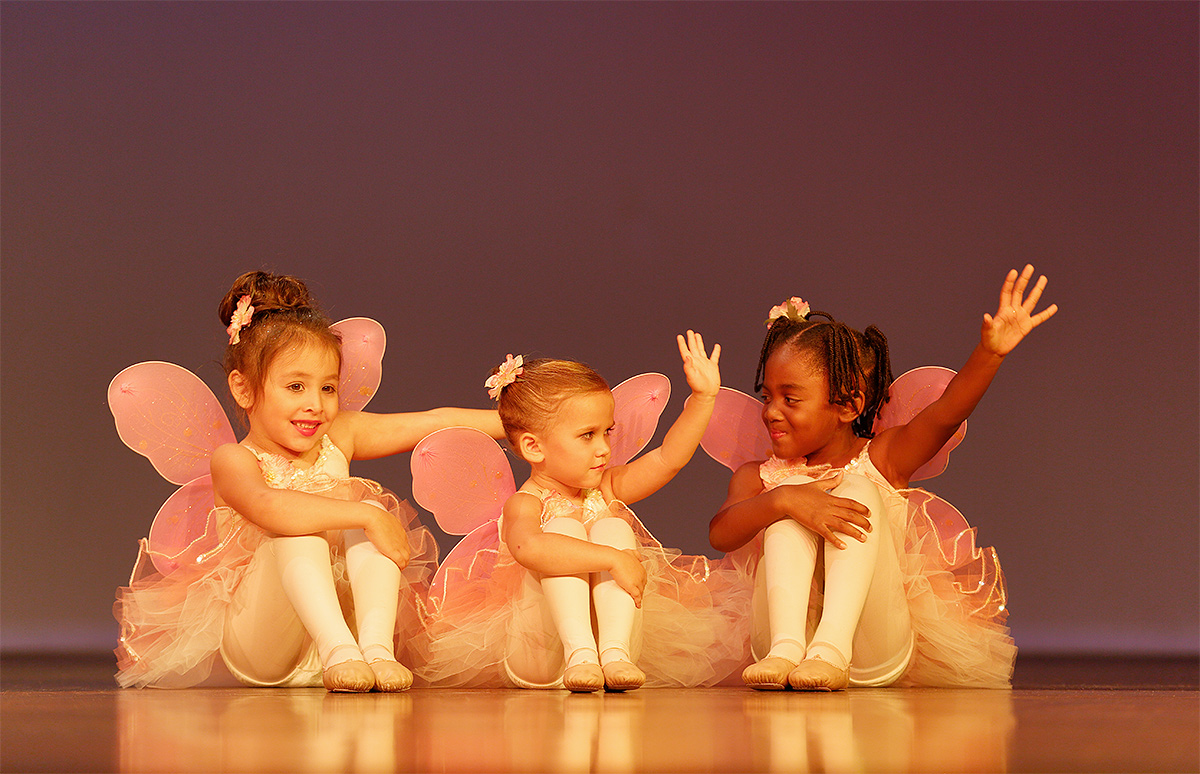
|
|
This image was created at the Hanken School of Dance Recital in Frostproof, FL on June 13 with the hand held Canon EF 70-200mm f/2.8L IS II USM lens (at 150mm) and the Canon EOS 5D Mark III. ISO 800. Evaluative metering at zero: 1/320 sec. at f/2.8 in Av Mode.
65 Point Automatic Selection/AI Servo/Shutter Button AF as framed was active at the moment of exposure (as is always best when hand holding). The AF system selected three AF points scattered around the center AF point. Click on the image to see a larger version.
Image #8: The little ones connecting
|
f/2.8???
Many folks shy away from f/2.8 in fear of not having enough depth of field. They forget the fact that depth of field increases as the camera to subject distance increases. As each of today’s images was made at distances ranging from 30 to 60 feet or so, there was sufficient depth of field to render the subject or subjects reasonably sharp.
Your Favorite?
Which of today’s images is your absolute favorite? Please let us know why you made your choice.
Facebook
Be sure to like and follow BAA on Facebook by clicking on the logo link upper right. Tanks a stack!
Support the BAA Blog. Support the BAA Bulletins: Shop B&H here!
We want and need to keep providing you with the latest free information, photography and Photoshop lessons, and all manner of related information. Show your appreciation by making your purchases immediately after clicking on any of our B&H or Amazon Affiliate links in this blog post. Remember, B&H ain’t just photography!
…..
Amazon.com
Those who prefer to support BAA by shopping with Amazon may use this link:
Amazon Canada
Many kind folks from north of the border, eh, have e-mailed stating that they would love to help us out by using one of our affiliate links but that living in Canada and doing so presents numerous problems. Now, they can help us out by using our Amazon Canada affiliate link by starting their searches by clicking here. Many thanks to those who have written.
Typos
In all blog posts and Bulletins, feel free to e-mail or to leave a comment regarding any typos or errors. Just be right :).
June 18th, 2015 What’s Up?
Almost finished my 2014 taxes; I should have them on the way to the accountant tomorrow. I enjoyed a late swim and then got right into my ice bath. And froze. Even though the pool is a warm 80 degrees it is more than 18 degrees cooler than the human body. The effects of cooling are cumulative….
This blog post took about an hour to prepare and should be published at 5:00am on Thursday, June 18.
Flying off the Virtual Shelves!
Selling your used (or like-new) photo gear through the BAA Blog or via a BAA Online Bulletin is a great idea. We charge only a 5% commission. One of the more popular used gear for sale sites charges a minimum of 20%. Plus assorted fees! Yikes. The minimum item price here is $500 (or less, for a $25 fee). If you are interested please e-mail with the words Items for Sale Info Request cut and pasted into the Subject line :). Stuff that is priced fairly–I offer free pricing advice, usually sells in no time flat. In just the past month, we have sold just about everything in sight. Like these items:
Canon EF 24-70 f2.8L II USM Lens was sold by Dave Bourgaize for $1699 on June 15, 2015.
Canon EF 180mm f/3.5L USM Macro Lens sold by Carl Zanoni for $975 on June 14, 2015.
Canon 500 mm f/4L IS Lens (the old five) sold by Greg Asnis for $4999 on June 13, 2015.
Canon 500mm f/4L IS II USM lens sold by Clemens Vanderwerf for $7999 on June 10, 2015.
Two Canon 600mm f/4L IS lenses sold by Pat and Alan Lillich within a week of listing for $9500 in early June 2015.
Canon 300mm f/2.8L IS lens sold by Kevin Hice within two days are being listed for $4750 in early June 2015.
Canon 500mm f/4L IS sold by Richard Rhudy for $4200 in late May, 2015.
Canon EOS-1D Mark IV Digital Camera Body sold by Marc Lombardi for $1300 in mid-May.
Canon EOS 7D DSLR Digital Camera Body (with battery grip) sold for $579 by Barbara Garmon on May 23, 2015.
Canon EOS-1D Mark IV sold by Gerald Barrack for $1599 in May, 2015.
Canon EF 300mm f/2.8L IS II USM lens sold for $4999 by Jacques Bouvier on May 20, 2015.
Canon EF 100-400mm f/4.5-5.6L IS USM sold by Barbara Garmon for $749 in mid-May.
Canon EF 70-200mm f/2.8L IS II sold by Carl Zanoni for $1649 on May 19, 2015.
Canon EF 100-400mm f/4.5-5.6L IS USM sold by Owen Peller for $799 on 5/19/15.
Two New Listings/June 17, 2015
Canon EF 400mm f/5.6L USM Lens
Steve Torna is offering a used Canon EF 400mm f/5.6L lens in excellent condition for the BAA lowest-ever price of $825. The sale includes the front and rear lenses caps, the tripod collar, a Realtree Max4 LensCoat and insured Ground shipping via Fed-Ex to US addresses. You can call Steve at 406-670-5359 or contact him via e-mail.
I put this one, my then beloved “toy lens” on the map, more than two decades ago. It remains in production, makes a great starter lens, autofocuses with a 1.4X TC (best on a tripod with Wimberley P-20 lens plate and a Mongoose M3.6), and is a great flight lens for those with a steady hand. artie
Canon EF Extender 1.4X II (Teleconverter)
Steve Torna is also offering a used Canon EF Extender 1.4X II (teleconverter) in excellent condition for $175. The sale includes the front and rear lenses caps, the grey fabric carrying pouch, the original box, and insured Ground shipping via Fed-Ex to US addresses. You can call Steve at 406-670-5359 or contact him via e-mail.
The 1.4X II TC is the optical equal of the 1.4X III TC. artie
The Rest of the Show
There are a slew of different 400mm lenses still listed on the Used Photography Gear For Sale Page here.
More Than Hard to Get: the Canon EF 400mm f/4 DO IS II USM Lens
As they are in extremely short supply and the demand is very high, only a few lucky folks have been able to get their hands on one of these great, hand holdable, super sharp telephoto lenses. I have spoken to perhaps a dozen folks who own the lens; all have commented ecstatically with regards to how manageable, versatile, and sharp the lens is whether used alone or with either the 1.4X III or the Canon Extender EF 2X III TC.
I have been able to help three folks who ordered using my B&H affiliate link have their orders expedited. Despite the fact that each waited more than two months, they were thrilled as many folks have been waiting four months to get theirs…. Folks need to remember that they actually need to pre-order this lens to have a chance to receive one in a somewhat timely fashion; wishing and hoping will not help.
If you do place an order using my affiliate link shoot me your B&H receipt via e-mail and I will do my best to have your order expedited.
Thanks to Arash for the use of this great image. I first came upon it in his post here in the Avian Forum on Bird Photographer’s.Net. Arash is one of our top Avian Forum moderators. Many might enjoy reading the post as like me, Arash has strong opinions that he is more than willing to share. Arash has co-authored several guides with me including the DPP 4 RAW Conversion Guide.
My BPN Comment
I posted this to the thread:
Wonderfully sharp image. Exposure and framing perfect. If Arash had been able to get a lot lower how (all else being equal) might his image have been improved?
Blog folks are invited to take a shot at the question….
Facebook
Be sure to like and follow BAA on Facebook by clicking on the logo link upper right. Tanks a stack!
Support the BAA Blog. Support the BAA Bulletins: Shop B&H here!
We want and need to keep providing you with the latest free information, photography and Photoshop lessons, and all manner of related information. Show your appreciation by making your purchases immediately after clicking on any of our B&H or Amazon Affiliate links in this blog post. Remember, B&H ain’t just photography!
…..
Amazon.com
Those who prefer to support BAA by shopping with Amazon may use this link:
Amazon Canada
Many kind folks from north of the border, eh, have e-mailed stating that they would love to help us out by using one of our affiliate links but that living in Canada and doing so presents numerous problems. Now, they can help us out by using our Amazon Canada affiliate link by starting their searches by clicking here. Many thanks to those who have written.
Typos
In all blog posts and Bulletins, feel free to e-mail or to leave a comment regarding any typos or errors. Just be right :).
June 17th, 2015 What’s Up?
On Tuesday I made some prints for a friend, answered more than a few e-mails, and did about eight more critiques of participants’ images from the two Palouse IPTs.
This blog post took about 15 minutes to prepare and was published at 5:00am early on the morning of Wednesday, June 17.
Don’t Hesitate: Save $5000!
Because of two late cancellations I am in position to offer $5000 off of the price of the world’s best Galapagos Photo Cruise. One male roommate, one female roommate. It’s late, but you still have time to arrange your flights to Guayaquil. Interested? See the details below and then call me asap at 863-692-0906 to arrange to leave a deposit.
|
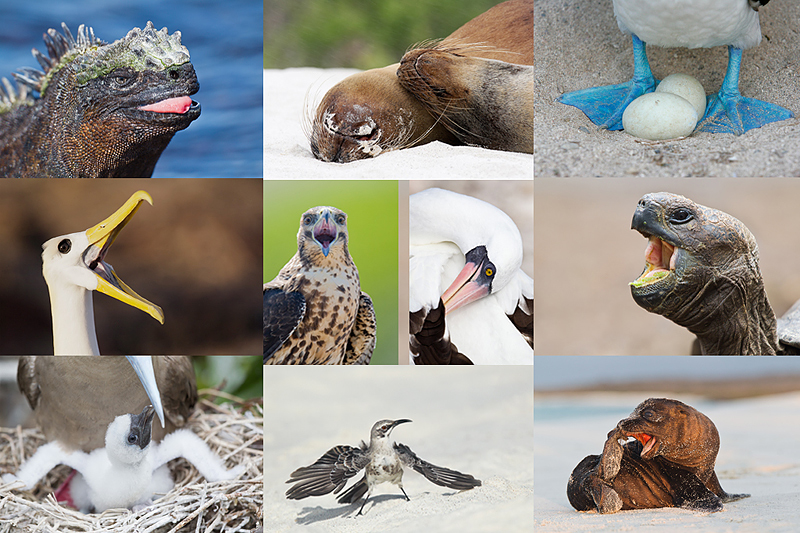
|
|
Do consider joining me for a once in a lifetime trip to the Galapagos archipelago in July, 2015.
|
GALAPAGOS Photo Cruise of a Lifetime IPT/The Complete Galapagos Photographic Experience. July 14-28, 2015 on the boat. 13 FULL and two half-days of photography: $12,499. Limit 14 including the leader.
My two-week Galapagos Photo-Cruises are without equal. The world’s best guide, a killer itinerary, a great boat (the Samba), and the best leader with eight Galapagos cruises under his belt. Pre-trip and pre-landing location-specific gear advice. In-the-field photo instruction and guidance. Jeez, I almost forgot: fine dining at sea!
The great spots that we will visit include Tower Island (including Prince Phillips Steps and Darwin Bay), Hood Island (including Punta Suarez, the world’s only nesting site of Waved Albatross, and Gardner Bay)—each of the preceding are world class wildlife photography designations that rank right up there with Antarctica, Africa, and Midway. We will also visit Fernandina, Puerto Ayora for the tortoises, Puerto Egas—James Bay, North Seymour and Isla Lobos for nesting Blue-footed Booby (most years), South Plaza, Floreana, and Urbina Bay, all spectacular in their own right. We visit every great spot on a single trip. Plus tons more. And there will he lots of opportunities to snorkel on sunny mid-days for those like me who wish to partake.
We will be the first boat on each island in the morning and the last boat to leave each island every afternoon. If we are blessed with overcast weather, we will often spend 5-6 hours at the best sites. And as noted above, mid-day snorkeling is an option on most sunny days depending on location. Note: some of the walks are a bit strenuous. Great images are possible on all landings with a hand held 70-200mm lens and a 1.4X teleconverter. I bring a longer lens ashore on most landings as that fits my style. I generally work with either the Canon 300mm f/2.8L IS or the Canon 200-400mm f/4 L IS with Internal Extender.
Do know that there is a NatureScapes Galapagos trip: one week for $8495. Thus, my trip represents a tremendous value; why go all that way and miss half of the great photographic locations?
The Logistics
Fly to Guayacil, Ecuador on July 12, 2015. Travel insurance/rest day: July 13 (We may or may not offer a photo outing on the 13th). Fly to the archipelago on July 14 and board the Samba. Get off the boat on July 28. Fly to Guayacil that afternoon. Fly home on the early morning of July 29 unless you are staying on or going elsewhere (or catching a red-eye flight on the evening of the 28th).
$12,499 includes just about everything: all transfers, guide and park fees, all food on the boat, transfers and ground transportation, your flights to the archipelago, and three nights (double occupancy) in a top notch hotel in Guayacil. If you are good to go, a non-refundable deposit of $5,000 per person is due immediately. The second payment of $4,000 is not due until 11/1/14. The final payment of $3449 per person will be due on 2/1/15. A $200 discount will be applied to each of the balances for couples or friends who register at the same time.
Purchasing travel insurance within 2 weeks of our cashing your deposit check is strongly recommended. On my past two cruises a total of 5 folks were forced to cancel less than one week prior to the trip. My family and I use Travel Insurance Services and strongly recommend that you do the same.
Not included: your round trip airfare from your home to and from Guayacil, beverages on the boat, phone calls, your meals in Guayacil, personal items, and a $600/person cash tip for the crew and the guide—this works out to roughly $40/day to be shared by the 7 folks who will be waiting on us hand and foot every day for two weeks. The service is so wonderful that many folks choose to tip extra.
Please e-mail for the complete itinerary and for additional info and images. Please cut and paste “Galapagos 2015 Info Please) into the Subject line.
Facebook
Be sure to like and follow BAA on Facebook by clicking on the logo link upper right. Tanks a stack!
Support the BAA Blog. Support the BAA Bulletins: Shop B&H here!
We want and need to keep providing you with the latest free information, photography and Photoshop lessons, and all manner of related information. Show your appreciation by making your purchases immediately after clicking on any of our B&H or Amazon Affiliate links in this blog post. Remember, B&H ain’t just photography!
…..
Amazon.com
Those who prefer to support BAA by shopping with Amazon may use this link:
Amazon Canada
Many kind folks from north of the border, eh, have e-mailed stating that they would love to help us out by using one of our affiliate links but that living in Canada and doing so presents numerous problems. Now, they can help us out by using our Amazon Canada affiliate link by starting their searches by clicking here. Many thanks to those who have written.
Typos
In all blog posts and Bulletins, feel free to e-mail or to leave a comment regarding any typos or errors. Just be right :).
June 16th, 2015 What’s Up?
First off, thanks a zillion to the folks who wished me a Happy Bird-day both here and especially on Facebook. I really felt the love. I worked very had yesterday but after the fact I am not sure what I accomplished. Did enjoy my core exercises, a lightning and thunder-shortened swim, and an ice bath.
Today I need to have some prints made and then sign them, and catch up on e-mail critiques from the two Palouse trips. Ah, I remembered what I spent so much time on: I have two images in the very final rounds of judging in the 2015 Nature’s Best photography contest. They ask for the RAWs, the optimized TIFs, and fleshed out capture info and captioning. Good luck to me. You have seen both images here on the blog, an Antarctic (or Blue-eyed) Shag with a feather and a tight head portrait of Little Mr. Huffer, a young coastal Brown Bear with a mask like a raccoon.
Congrats to the Stanley Cup-winning Chicago Blackhawks; I am sure that Maya and Jen are thrilled. This blog post took about two hours to prepare and was published after 6:00am early on the morning of Tuesday Monday, June 16.
|
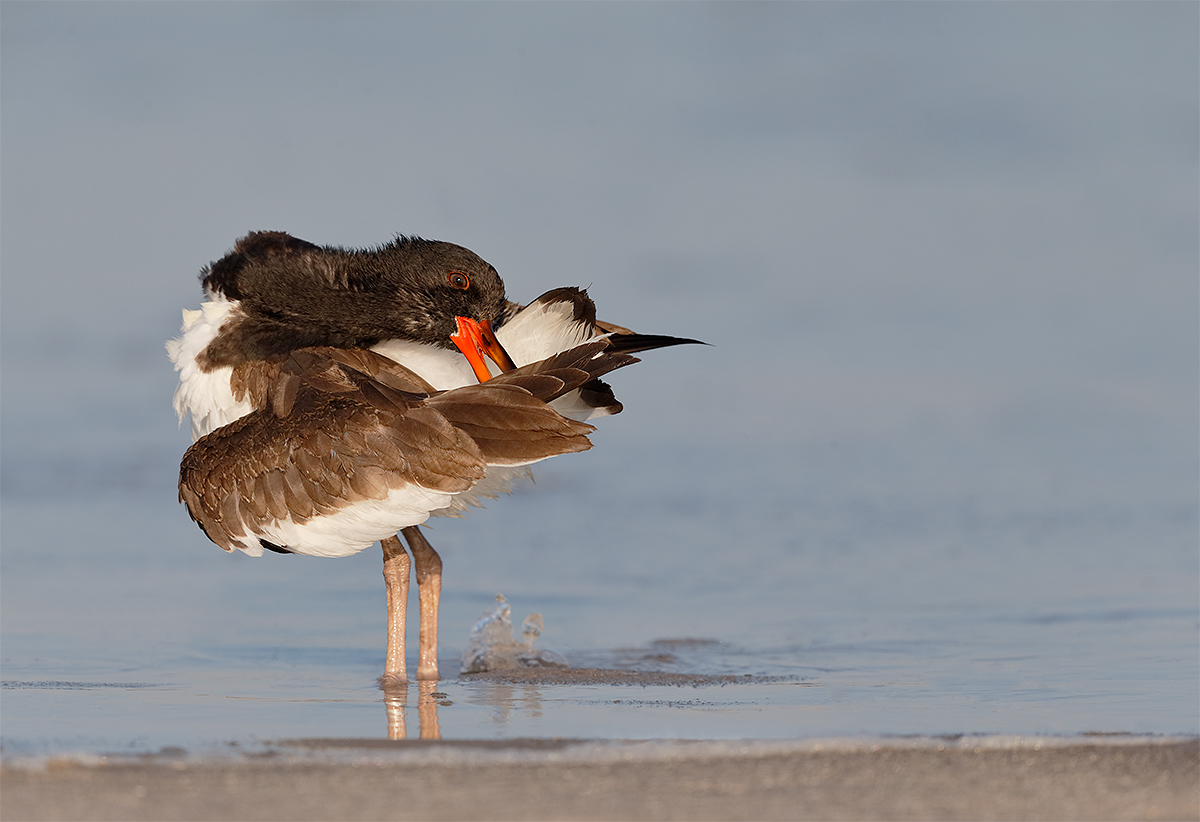
|
|
This image was created on last August’s Nickerson Beach IPT with the tripod-mounted Canon EF 600mm f/4L IS II USM lens, the Canon Extender EF 1.4X III, and the Canon EOS-1D X. ISO 400. Evaluative metering +2/3 stop: 1/1600 sec. at f/6.3. AWB.
Four AF points to the left and one row above the center AF Point/AI Servo Expand/Rear Focus AF as framed was active at the moment of exposure. Click here to see the latest version of the Rear Focus Tutorial. Click on the image to see a larger version.
|
The Preening Head Angle
There are lots of young oystercatchers at Nickerson Beach in August. If you would like to join me, see the IPT info below.
How would you rate the head angle of this preening young oystercatcher?
The Image Clean-up
After converting the image in DPP 4 and leveling it in Photoshop I spent about 20 minutes on the clean-up. In addition, I removed the aluminum band on the bird’s leg. As regular readers know, I am a huge advocate of using keyboard shortcuts to reduce the time spent in Photoshop. In fact, I have created probably close to a dozen personalized keyboard shortcuts that allow me to save a ton of time. All, and the methods that I use to create them, are detailed in Digital Basics. See more below. For the clean-up I used the Patch Tool (my P), the Clone Stamp Tool (S), the Spot Healing Brush (J), and a series of small Quick Masks fine-tuned with a Regular Layer Mask. The latter was used to cover the band.
Photoshop 6 (and previous versions?) Mystery & My Solution
I am currently running Photoshop CS-6 CC (if that it the proper designation) on my Macbook Pro with Retina Display. Half the time when I first open Photoshop, none of the keyboard shortcuts work. That includes the many default keyboard shortcuts that I use routinely as well the personalized ones that I have created. In addition, if you manually select the Clone Stamp Tool and attempt to use the left or right bracket keys to make the Clone Stamp Tool smaller or larger, nothing happens. Photoshop is simply dead to the world as far as keyboard shortcuts.
At times, everything is working fine from the get-go when suddenly the situation above is replicated. I remember similar things happening with CS-6 and perhaps with CS-5 as well. For folks like me who like to work quickly, this can be a real drag. Though it takes a few seconds to execute, I have come up with a fix: select the Clone Stamp Tool manually, go into the Brush Dialogue Box, and change the size of the brush manually with the slider. If your computer works like my mac or like Denise’s PC, all of your shortcuts will come back to life, and you will be able to change the brush sizes with the bracket keys. At least for a while….
I would love to hear from folks who have experiences this problem. My opinion? Adobe should be ashamed of itself. Of course, if anyone knows a permanent solution to this problem, please do share.
Digital Basics
Everything that I did to optimize today’s image is covered in detail in my Digital Basics File–written in my easy-to-follow, easy-to-understand style. Are you tired of making your images look worse in Photoshop? Digital Basics File is an instructional PDF that is sent via e-mail. It includes my complete digital workflow, dozens of great Photoshop tips, details on using all of my image clean-up tools, the use of Contrast Masks, several different ways of expanding and filling in canvas, all of my time-saving Keyboard Shortcuts, Quick Masking, Layer Masking, and NIK Color Efex Pro basics, Contrast Masks, Digital Eye Doctor techniques, using Gaussian Blurs, Tim Grey Dodge and Burn, a variety of ways to make selections, how to create time-saving actions, the Surface Blur (background noise reduction) settings as taught to me by Denise Ippolito, and tons more.
APTATS I & II
Learn the details of advanced Quick Masking techniques in APTATS I. Learn Advanced Layer Masking Techniques in APTATS II. Mention this blog post and apply a $5 discount to either with phone orders only. Buy both APTATS I and APTATS II and we will be glad to apply at $15 discount with phone orders only. Please call Jim or Jennifer at 863-692-0906 weekdays to order.
|

|
|
You can order your copy of “The Photographers’ Guide to Canon Digital Photo Professional 4.0” (aka the DPP 4 Raw Conversion eGuide) by Arash Hazeghi and Arthur Morris by clicking here.
|
The DPP 4 eGuide (PDF)
Learn how and why I and many other discerning photographers choose and use only DPP 4 to convert their Canon RAW files in the DPP 4 RAW Conversion Guide by Arash Hazeghi and yours truly. The latest version supports all of the newer Canon camera bodies and several older models including the EOS-7D and the EOS-1D Mark IV. The DPP IV Guide is the ideal companion to the 7D Mark II User’s Guide, a runaway best seller.
|

|
|
The strange thing is that when I lived in New York, I never knew about this amazing and consistently productive location.
|
Nickerson Beach/JBWR (possibly…)/Black Skimmer/Oystercatcher/migrant shorebird IPT: August 13-16, 2015. 3 1/2 DAYS: $1399.
Meet and greet on the evening of WED August 12. Limit 10/Openings 5.
Most of our seven photo sessions will be spent at Nickerson beach photographing the nesting Black Skimmers. In flight, sometimes battling. Carrying fish. Chicks of varying sizes from a very few just-hatched to lots of fledglings. It is likely that we will get to see some Great Black-backed Gulls preying on the juvenile skimmers. They swallow them whole. There will be lots of gulls to photograph as well as some Common Terns. Locally breeding shorebird species include American Oystercatcher–pretty much guaranteed, Willet, which is likely, and Piping Plover, which is probable but we need to get lucky with those to get close….
Save a space by calling Jim or Jen at the office and arranging to leave your deposit of $499. I hope to see you there.
JBWR?
If local conditions are ideal we may visit Jamaica Bay Wildlife Refuge to photograph southbound migrant shorebirds on one or possibly two mornings. Even if we do not visit JBWR we should get some good chances with the migrant shorebirds at the beach, especially Sanderling and Semipalmated Plover. Red Knot and others are possible.
|

|
|
As you can see, the oystercatchers are quite tame at Nickerson. And we will get you up early and we will stay out late.
|
Jamaica Bay Wildlife Refuge In-the-field Instructional Photo Workshop/Scouting Session. August 12, 2015. Morning only: $250. Cheap!
The tide will be pretty good at the East Pond…. If I learn that conditions there are un-photographable we will do Nickerson Beach as a back-up. This will work either as an add-on for out of town folks coming for the IPT above or as a stand alone session. Either way, you will, as always, learn a ton. And we might even get some good images.
Facebook
Be sure to like and follow BAA on Facebook by clicking on the logo link upper right. Tanks a stack!
Support the BAA Blog. Support the BAA Bulletins: Shop B&H here!
We want and need to keep providing you with the latest free information, photography and Photoshop lessons, and all manner of related information. Show your appreciation by making your purchases immediately after clicking on any of our B&H or Amazon Affiliate links in this blog post. Remember, B&H ain’t just photography!
…..
Amazon.com
Those who prefer to support BAA by shopping with Amazon may use this link:
Amazon Canada
Many kind folks from north of the border, eh, have e-mailed stating that they would love to help us out by using one of our affiliate links but that living in Canada and doing so presents numerous problems. Now, they can help us out by using our Amazon Canada affiliate link by starting their searches by clicking here. Many thanks to those who have written.
Typos
In all blog posts and Bulletins, feel free to e-mail or to leave a comment regarding any typos or errors. Just be right :).
June 15th, 2015 What’s Up?
I spent most of my birthday–thanks a stack to the huge number of folks who sent birthday wishes along either here or especially on Facebook–doing what I do most days when I am home: answered e-mails, worked on this blog post, worked on a few images, started another round of core exercises, and enjoyed a late afternoon swim. To celebrate, I “borrowed” about ten M&M Peanuts from Jim’s stash and injected 3 extra units of Regular insulin to cover that indulgence; I enjoyed them.
My Mom, my younger sister Arna, and my younger daughter Alissa called at about 10:00am to sing happy birthday, and younger daughter Jennifer and her family did that same in the afternoon. It was all very sweet and touching. Lissy and Jen teamed up to buy me an early birthday gift, a Cuisinart Food Processor that I have been putting to good use recently making crispy pizza dough from cauliflower. It is amazing. And healthy. Speaking of which, I tipped the scale this morning at an even 175 pounds, my lowest weight in about 5 years.
As I finished the last of 48 lengths of the pool I heard someone singing happy birthday to me. I looked up to see all six foot six or so of good friend Clemens Vanderwerf standing on the pool deck. He dropped by on his way home from Tampa. Then I got my real gift. He brought his three Golden Retrievers into the house where they proceeded to explore every inch of the place and lick me and kiss me up and down. They were quite well behaved yet playful as can be.
This blog post took about four hours to prepare and will be published at 5:00am early on the morning of Monday, June 15.
Blog Thanks
Those who wish to thank me for the work that I put into the blog and the hours I spend each week answering your e-mail questions are invited to click here or to send a Paypal to us at birdsasart@verizon.net. All donations are greatly appreciated. artie
|
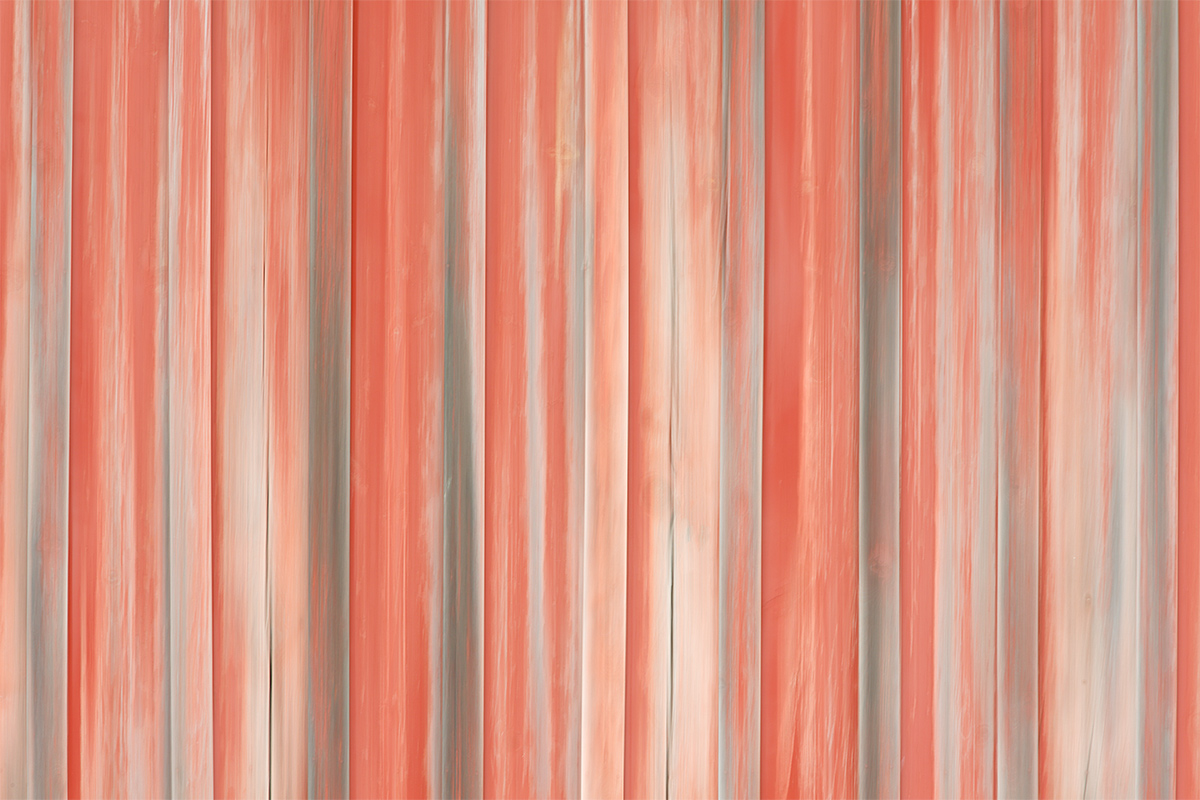
|
|
This image was created on the first Palouse IPT with the Canon EF 200-400mm f/4L IS USM lens with Internal 1.4x Extender, an external Canon Extender EF 1.4X III (at the max, 798mm), and the Canon EOS 5D Mark ISO 100. Evaluative metering +1 2/3 stops: 1/2 sec. at f/16 in Tv mode. AWB.
A Singh-ray 52mm Mor-Slo screw-in glass 5-Stop Neutral Density Filter in a Canon Drop-In Filter Holder for 52mm Screw-In Filters was used to get down to a really slow shutter speed in the bright sun. I will be doing a feature on the 52mm Singh-ray Mor-Slo Neutral Density Filters and the Canon Drop-In Filter Holders for 52mm Screw-In Filters in a blog post here soon.
Center AF point (Manual selection)/One-Shot/Shutter Button AF and pan from up to down. With the 5-stop ND in place in a super-telephoto lens you need to give your eyes a few seconds to adjust to the dark viewfinder. As long as there is some contrast to work with, AF should perform just fine. Click on the image to see a larger version.
Old Barn siding vertical pan blur.
|
Pan-Blurs
On each of the two Palouse IPTs we did several in-the-field tutorials covering the creation of both horizontal and vertical pan blurs. Most folks were open-eared, open-minded, and eager to learn.
What They are Saying…
Scattered throughout this blog post are comments from roughly half the folks who attended the two Palouse IPTs. It is interesting to note that 13 of the 14 folks quoted here have traveled and studied with either Denise or with me before. Of those, Only Lou Newman’s son Rick was a virgin, completely new to to either a BAA IPT or an A Creative Adventure workshop. Legacies are always welcome on our tours 🙂 Muriel McClellan’s daughter Mimi is joining her Mom and us on the UK Puffins and Gannets IPT. Come to think of it, parent/child workshop combos are about as huge a compliment as you might ever get….
In any case, what should be obvious to all who read the various comments is that Denise and I, with our different teaching styles, combine to make a powerful and creative teaching team. Denise’s style and encouragement actually got me a bit out of my box in the Palouse; I spent more time looking at rear LCDs than I ever had before. It is much harder to do that on bird trips as the subjects tend to move more than old barns or crop fields 🙂
If, after reading the comments here, you would like to join us in the Palouse next year, click here for details.
Lou Newman/Multiple BAA IPT Veteran
Artie and Denise, I wanted you to know that the Palouse IPT was A#1! Wow! The best! I have just returned from one of the best instructional photo tours I have ever attended. Arthur Morris and Denise Ippolito proved to be a superb teaching team. At each stop Artie and Denise provided personal attention to each participant, made sure that every participant was set-up properly, and answered all questions before even thinking about shooting themselves. Once they setup their own cameras they provided group instruction telling all what they were doing and why, then encouraging questions and alternatives and asking the participants for suggestions. Individual attention was always available.
All of the participants were experienced photographers so the group dynamics were great and there was considerable sharing of expertise and information. When we returned from the morning shoot we went right into the computer sessions which were held in an ideal small conference room with chairs facing tables for laptops and a projection screen in front. Artie and Denise had prepared presentations for four sessions, and requested that all participants submit images for review for the middle session. The Photoshop and image review sessions with this teaching team and group of talented photographers were exceptional. We all had lunch together, then free time prior to heading out in the late afternoon. It was exhausting, but proved to be one of the best learning experiences I have encountered on a photo tour. Kudos to Artie and Denise for this one! Lou
Cindy Gosselin/A Multiple Creative Adventure Workshop Veteran
Hey Guys, I want to thank the both of you for a wonderful trip to the Palouse. This area of the country has been on my “bucket list” for more than 5 years. Finally getting there did not disappoint!! But what made it extra special was that the two of you led the group. Thank you for sharing your tips and techniques. But most of all thanks for sharing your passion for photography. It is contagious and re-inspired me at every stop along the way. Cindy
Rick Newman
Artie and Denise, I went into this workshop with no landscape photography experience, yet had a wonderful time! Denise and Art have complementary teaching styles, giving me an abundance of opportunities to learn. I left with an entire new skill set, a deeper understanding of my camera, some previously undiscovered talent, and a new enthusiasm for photography. If you want to up your photographic game, attend this workshop! Rick
Colleen Malley/A Creative Adventure Workshop Veteran
Artie and Denise, I can’t say thank you enough times for such a wonderful trip! My confidence has skyrocketed with your and Art’s encouragement. I also learned so much more about the capabilities of my camera. You definitely have not seen the last of me. !!!! Colleen
Len Saltiel/A Multiple Creative Adventure Workshop Veteran
Denise and Art, Terrific workshop and is highly recommended. Terrific shots and memories Denise. Len
Joe Barranco/Multiple BAA IPT & A Creative Adventure Workshop Veteran
Denise and Artie, Workshop was awesome. I have never seen farmland that looked like this. Contour farming at its best. The images I got with help from Denise and Art Morris were great. Plus they made it a lot of fun. The landscape images are just different. Awesome place. The old barns and farm equipment blew me away. I liked the “wheel fence” images in one of Denise’s blog post because I did not “see” them. Denise has the best “eye” out there! Joe
Judy Helderman/Multiple A Creative Adventure Workshop Veteran
Hi Denise, I haven’t downloaded my Palouse pictures yet as I’m in the midst of changing computer systems, but I will as soon as I can and will send a couple for critiquing. I learned a lot from you in the Palouse. You were incredibly helpful. I’d like to take your Charleston workshop next spring.
Judy.
Muriel McClellan/Multiple BAA IPT & A Creative Adventure Workshop Veteran
Denise and Artie, What a fantastic experience. Denise and Artie did a fabulous job of finding the best opportunities in the middle of the maze that is the Palouse. I was blessed to be on this trip and my learning curve jumped off the charts. Muriel ps: see you in the UK!
Phil Frigon/BAA IPT Veteran
Hey Guys, Enjoyed the IPT, making new friends and the experiences. Thanks to all. Sign me up for the Greece/Dalmatian Pelicans IPT. Phil
Alan Glasser
Artie and Denise, The workshop was great. I learned an enormous amount and enjoyed it thoroughly. Your teaching styles exactly fit my style of learning. Kudos. Alan Glasser
Pat Fishburne/Multiple BAA IPT Veteran
Dear Art and Denise, Stokes and I really enjoyed the Palouse IPT! Pat
Catherine Costolo/Multiple BAA IPT & A Creative Adventure Workshop Veteran
Artie, The trip was awesome, thanks to you and Denise. Catherine
Mary Doherty/A Multiple Creative Adventure Workshop Veteran
Denise, Just wanted to let you know what a wonderful time I had on the workshop with you and Artie. Thanks both for making this such such a great workshop!!! I was totally blown away by all the different locations we visited and appreciated all the suggestions and guidance you provided during the workshop.The Palouse was amazing…beautiful landscapes (even without puffy white clouds) and lots of old and crumbly barns…so much to see and photograph. Thanks again for a wonderful workshop! Mary
Mary Doherty’s Barn Blur
In the opening image here, I went to my maximum focal length so that I could get only the red boards on the side of the barn. Mary included her vertical pan blur in the five images that she sent as part of her post-IPT critique. We offer that on all IPTs and A Creative Adventure Workshops; it is a great way to extend the learning that takes place on location. In any case, Mary took our pan blur instructions and ran with them. I loved that she included some of the grass below the barn.
Dust Bunnies
I noticed that Mary’s image had a ton of dust bunnies, lots of big ones and more smaller ones. Looking at the EXIF it is easy to see why. At f/22, even microscopic dust becomes a problem. I suggested to her via e-mail that she purchase either a 3-stop resin or a 5-Stop glass Mor-Slo Singh Ray Neutral Density filter. I wrote, Many folks would prefer the 3-stop resin Mor-Slo but I like the 5-stop glass ones. It takes your eye a moment to adjust to the dark view through the lens but it allows me to work in bright sun at relatively wide apertures and the AF system works just fine. The ideal situation would be to own both but that would surely be a bit extravagant for most.

Best News: 10% Discount/Code at checkout: artie10
To shop for a Singh-Ray 5-Stop Mor-Slo Fliter (for example), click on the logo link above, click on “Neutral and color
Solid Neutral Density Filters (glass), then click on “Mor-Slo™ 5, 10, 15 and 20-Stop Solid Neutral Density Filters (glass),” choose the size and model, add to cart, and then checkout. At checkout, type artie10 into the “Have a coupon? Click here to enter your code” box, and a healthy 10% discount will be applied to your total. In addition to enjoying the world’s best filter at 10% off you will be supporting my efforts here on the blog.
John Haedo/Multiple BAA IPT & A Creative Adventure Workshop Veteran
Artie and Denise, I had a wonderful time during the IPT, notwithstanding the blue skies. I learned quite a few new things and reinforced some of the things that I’ve been doing correctly. To everyone in the group, and especially to Gary and Phil, with whom I rode every day, I want to express my appreciation for your delightful company. I really enjoyed the IPT; all of you were very nice “happy campers”, as someone I know likes to say. I feel honored to have shared this experience with all of you and hope our paths will cross again in the future. Artie and Denise, thank you both for working your tails off (as always) to give us a great experience. And thanks for your friendship, patience and the ample sharing of your large reservoir of knowledge and experiences with us. Every IPT with you guys is better than the last. Thank you, and be well. John Haedo
Sally Foster/Multiple A Creative Adventure Workshop Veteran
Finally got to the Palouse and it was everything I had imagined and more. Artie and Denise make quite a team with their knowledge and willingness to share. Sally
A Guide to Pleasing Blurs
If you would like to learn the fine points of creating pleasing pan-blurs but cannot make an IPT get yourself a copy of A Guide to Pleasing Blurs by Denise Ippolito and yours truly. Dozens of other creative techniques are detailed as well.
Facebook
Be sure to like and follow BAA on Facebook by clicking on the logo link upper right. Tanks a stack!
Support the BAA Blog. Support the BAA Bulletins: Shop B&H here!
We want and need to keep providing you with the latest free information, photography and Photoshop lessons, and all manner of related information. Show your appreciation by making your purchases immediately after clicking on any of our B&H or Amazon Affiliate links in this blog post. Remember, B&H ain’t just photography!
…..
Amazon.com
Those who prefer to support BAA by shopping with Amazon may use this link:
Amazon Canada
Many kind folks from north of the border, eh, have e-mailed stating that they would love to help us out by using one of our affiliate links but that living in Canada and doing so presents numerous problems. Now, they can help us out by using our Amazon Canada affiliate link by starting their searches by clicking here. Many thanks to those who have written.
Typos
In all blog posts and Bulletins, feel free to e-mail or to leave a comment regarding any typos or errors. Just be right :).
June 14th, 2015 What’s Up?
I spent all morning getting the information needed for the National Trust memberships together for the sold out UK Puffins and Gannets IPT; the task was finished just before lunch. Now I need to get the passes. That on Monday.
I went to granddaughter Maya’s dance recital in the afternoon and created 1117 images with the hand held 5D Mark III/70-200mm f/2.8L IS combo. I have been going every year for quite awhile. For some reason on the way over today I realized that when I first started going that Mayas was one of the tiny tot dancers. Today she has been transformed into a beautiful young lady. And she is quite an excellent dancer as well. Kudos also to Maya’s Dad, my son-in-law, Erik Egensteiner (who is married to my older daughter Jennifer, the executive director of BIRDS AS ART). As he has been doing for more than a few year’s Erik is one of the Dancing Dad’s. I will share an image or three with y’all here soon.
This blog post took about an hour to prepare and will be published at 5:00am on the early morning of Sunday, June 14. Hey, I almost forgot; happy birthday to me: 69 :).
Blog Thanks
Those who wish to thank me for the work that I put into the blog and the hours I spend each week answering your e-mail questions are invited to click here or to send a Paypal to us at birdsasart@verizon.net. All donations are greatly appreciated. artie
|
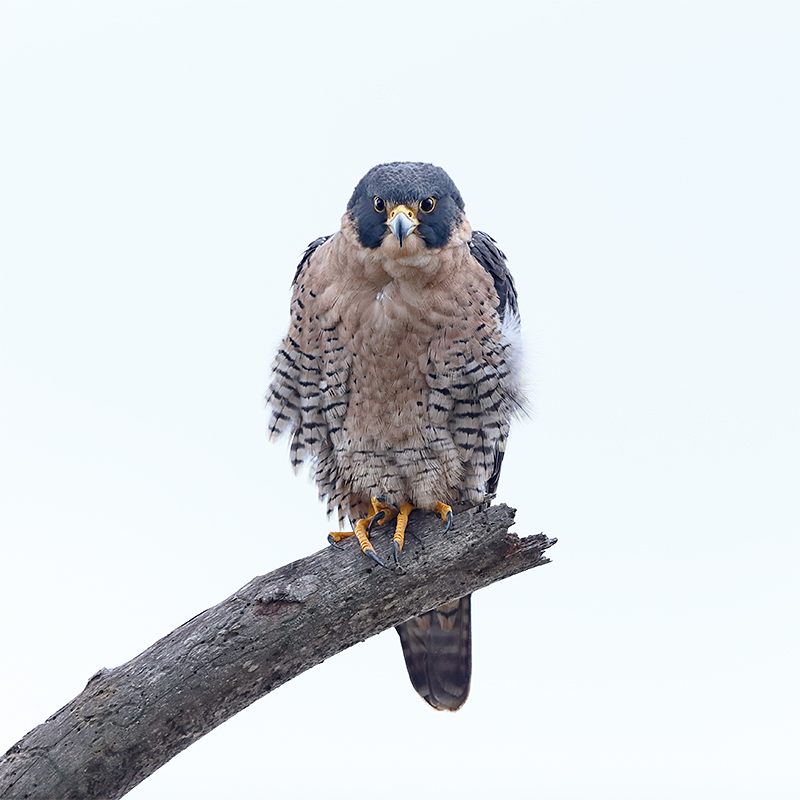
|
|
This image was created on the last San Diego IPT with the tripod-mounted Canon EF 600mm f/4L IS II USM lens and the Canon EOS-1D X. ISO 800. Evaluative metering +3 stops as originally framed: 1/80 sec. at f/4 in Manual mode.
Center AF point (Manual selection)/AI Servo/Rear Focus AF on the bird’s eye and re-compose. Click here to see the latest version of the Rear Focus Tutorial. Click on the image to see a larger version.
Low light Peregrine Falcon
|
Local Knowledge Rocks
This bird or its mate sits above the pelican cliffs in LaJolla, CA most mornings. Most photographers simply walk on by without checking the trees above carefully. Most days the bird is not perched in a pleasing position. Sometimes you get lucky. But only if you know to check….
Dealing with the Low Light
This square crop is from a horizontal original. That means that most of the frame was white sky. In the pre-dawn. I added three stops of light to the exposure as framed and set that manually. When the scene averages close to WHITE and the sun is not out at full strength our camera meters are really dumb. Learn to expose to the right in all situations to ensure less noise and the largest possible image files with maximum color information.
The Crop…
Do you like the square crop for this image? Why or why not? Please remember that it is from a horizontal original.
|

|
|
San Diego offers a wealth of very attractive natural history subjects. With annual visits spanning more than three decades I have lot of experience there….
|
2015 San Diego 4 1/2-DAY BIRDS AS ART Instructional Photo-Tour (IPT) JAN 8 thru the morning of JAN 12, 2016: $1899 (Limit: 10)
Meet and Greet at 7:00pm on the day before the IPT begins
Two great leaders: Arthur Morris and Denise Ippolito
Join us in San Diego to photograph the spectacular breeding plumage Brown Pelicans with their fire-engine red and olive green bill pouches; Brandt’s and Double-crested Cormorants in breeding plumage with their amazing crests; breeding plumage Wood and Ring-necked Duck; other species possible including Lesser Scaup, Redhead, and Surf Scoter; a variety of gulls including Western, California, and the gorgeous Heerman’s, all in full breeding plumage; shorebirds including Marbled Godwit, Willet, Sanderling and Black-bellied Plover; many others possible including Least, Western, and Spotted Sandpiper, Whimbrel, Black and Ruddy Turnstone, Semipalmated Plover, and Surfbird; Harbor Seals (depending on the current regulations) and California Sea Lions likely; and Bird of Paradise flowers. And as you can see by studying the two IPT cards there are some nice landscape opportunities as well.
Did I mention that there are wealth of great birds and natural history subjects in San Diego in winter?
This IPT will include five 3 1/2 hour morning photo sessions, four 2 1/2 hour afternoon photo sessions, five lunches, after-lunch image review and Photoshop sessions, and a thank you dinner. To ensure early starts, breakfasts will be your responsibility.
A $499 non-refundable deposit is required to hold your slot for this IPT. You can send a check (made out to “Arthur Morris) to us at BIRDS AS ART, PO Box 7245, Indian Lake Estates, FL, 33855. Or call Jim or Jennifer at the office with a credit card at 863-692-0906. Your balance, payable only by check, will be due on 11/1//2015. If we do not receive your check for the balance on or before the due date we will try to fill your spot from the waiting list. Please print, complete, and sign the form that is linked to here and shoot it to us along with your deposit check. If you register by phone, please print, complete and sign the form as noted above and either mail it to us or e-mail the scan. If you have any questions, please feel free to contact me via e-mail.
|

|
|
Though the pelicans will be the stars of the show on this IPT there will be many other handsome and captivating subjects in wonderful settings.
|
Facebook
Be sure to like and follow BAA on Facebook by clicking on the logo link upper right. Tanks a stack!
Support the BAA Blog. Support the BAA Bulletins: Shop B&H here!
We want and need to keep providing you with the latest free information, photography and Photoshop lessons, and all manner of related information. Show your appreciation by making your purchases immediately after clicking on any of our B&H or Amazon Affiliate links in this blog post. Remember, B&H ain’t just photography!
…..
Amazon.com
Those who prefer to support BAA by shopping with Amazon may use this link:
Amazon Canada
Many kind folks from north of the border, eh, have e-mailed stating that they would love to help us out by using one of our affiliate links but that living in Canada and doing so presents numerous problems. Now, they can help us out by using our Amazon Canada affiliate link by starting their searches by clicking here. Many thanks to those who have written.
Typos
In all blog posts and Bulletins, feel free to e-mail or to leave a comment regarding any typos or errors. Just be right :).
June 13th, 2015 What’s Up?
My first night home I slept eight hours with five pit stops. After my first ice bath in more than two weeks on Thursday, I slept seven hours with no pit stops. The power of the ice baths is amazing. No swim on Friday, just an ice bath. When I finish this blog post I hope to get on the floor and resume my core, shoulder, and knee exercises….
Though I got a ton done today, I did not get online to arrange the National Trust memberships for the sold out UK Puffins and Gannets IPT that I am leading with Denise Ippolito. This blog post took about four hours to prepare and will be published at 5:00am on the early morning of Saturday, June 13.
Blog Thanks
Those who wish to thank me for the work that I put into the blog and the hours I spend each week answering your e-mail questions are invited to click here or to send a Paypal to us at birdsasart@verizon.net. All donations are greatly appreciated. artie
Lake Kerkini Dalmatian Pelicans IPT
If the promised deposit checks arrive, there is only one spot left on this amazing trip. See the blog post here.
2016 Palouse IPTs
We received several more deposits today for each of the two 2016 Palouse IPTs. Click here for more information.
Please Remember to shop the BAA Online Store, and to use our Affiliate Links 🙂
To show your appreciation for my continuing efforts here, we ask, as always, that you use our the B&H and Amazon affiliate links on the right side of the blog for all of your purchases. B&H is recommended for you major photography gear purchases, Amazon for your household, entertainment, and general purpose stuff. Please check the availability of all photographic accessories in the BIRDS AS ART Online Store, especially the Mongoose M3.6 tripod heads, Gitzo tripods, Wimberley heads and plates, LensCoats and accessories, and the like. We sell only what I have used, have tested, and can depend on. We will not sell you junk. We know what you need to make creating great images easy and fun. And we are always glad to answer your gear questions via e-mail. I just learned that my account was suspended during my absence; it should be up and running by Monday at the latest.
I would of course appreciate your using our B&H affiliate links for all of your major gear, video, and electronic purchases. For the photographic stuff mentioned in the paragraph above we, meaning BAA, would of course greatly appreciate your business. Here is a huge thank you to the many who have been using our links on a regular basis and visiting the BAA Online store as well.
|
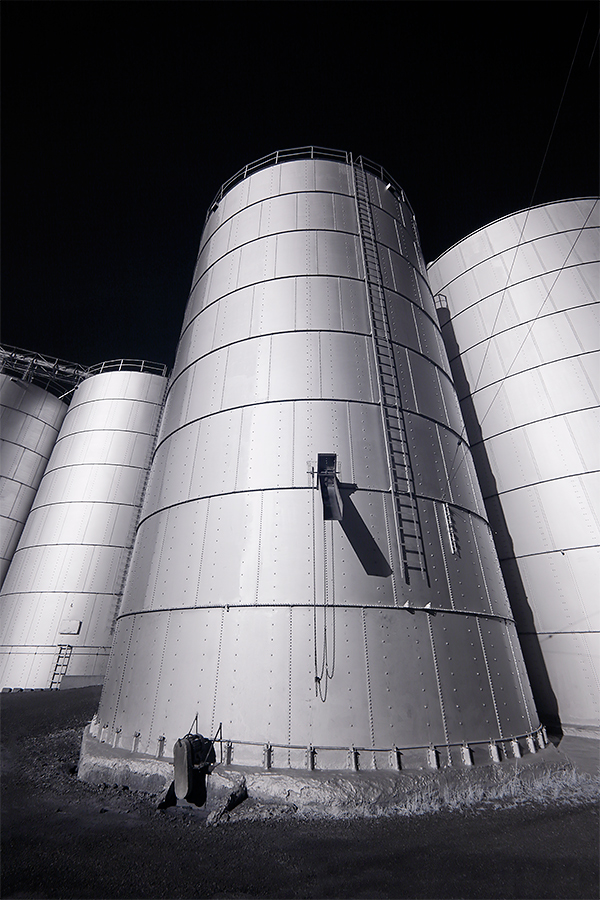
|
|
This image was created on the second Palouse IPT with the hand held Canon EF 11-24mm f/4L USM lens (at 14mm) and an EOS-5D Mark II converted to Infrared at 720nm by Kolari Vision. Evaluative metering +1 1/3 stops: 1/500 sec. at f/11. Custom WB.
Center AF point/One Shot/Shutter Button AF as framed. Click on the image to see a larger version.
Image #1: Modern Grain Elevators/Infrared Capture
|
Infrared Info
About a month ago, on the advice of IR expert Mark Hilliard, I had a 5D Mark II in pretty decent shape converted to IR at 720 nm (nanometers) Infrared by Kolari Vision. Both Denise and I used the body extensively on both Palouse IPTs and shared it often with more than a few participants who wanted to dabble. Everyone had a ton of fun. Digital IR is new and different and exciting, at least to denise and to me. Both of us were very happy with the quality of the work done by Kolari Vision and with the resulting image quality as well. There is a pretty steep learning curve with IR photography but we are a very clever team and we figured things out pretty quickly.
Kolari Vision Infrared Camera Conversions
If you are ready to join the fun and have a camera converted to Infrared, use the Kolari Vision logo-link above to order your conversion and I will be glad to send you my simple guide to properly setting a Custom White Balance for infrared photography at 720nm. Simply forward your Kolari Vision receipt to me via e-mail and we will be glad to shoot you the PDF.
Kolari Vision prides themselves on their fast turnaround times and excellent customer service; they are getting better and faster as they employ several full time technicians to service everything as quickly as possible. The filters they use have been specifically designed for each camera and filter combination to be the optimal thickness for best autofocus performance between lenses, and the best corner sharpness. The filters also fit directly into the frame making the conversion non-damaging and reversible if needed. Others uses a few standard-sized thick filters that they calibrate the camera around. Doing this reaches accurate autofocus with their test lens. But when a filter is too thick for what the optics were designed for, the sharpness can suffer, particularly in the corners, and other lenses will not consistently focus accurately. Some other IR converters glue their filters directly to the sensor; that makes it almost impossible to revert back or to change the filter.
Kolari offers a comprehensive shop for infrared bodies; customers can order converted cameras directly from KV. Their focus on optical quality built from the ground up has allowed them to recently offer a service that improves the performance of Sony A7 series cameras to the level of the Leica M240 cameras. Content-wise, Kolari has a very comprehensive article list and an exhaustive lens performance database chock full of technical details. Soon, KV will feature an interactive gallery that will showcase different camera/filter picture combinations to get rid of some of the mystery of picking a camera to convert.
|
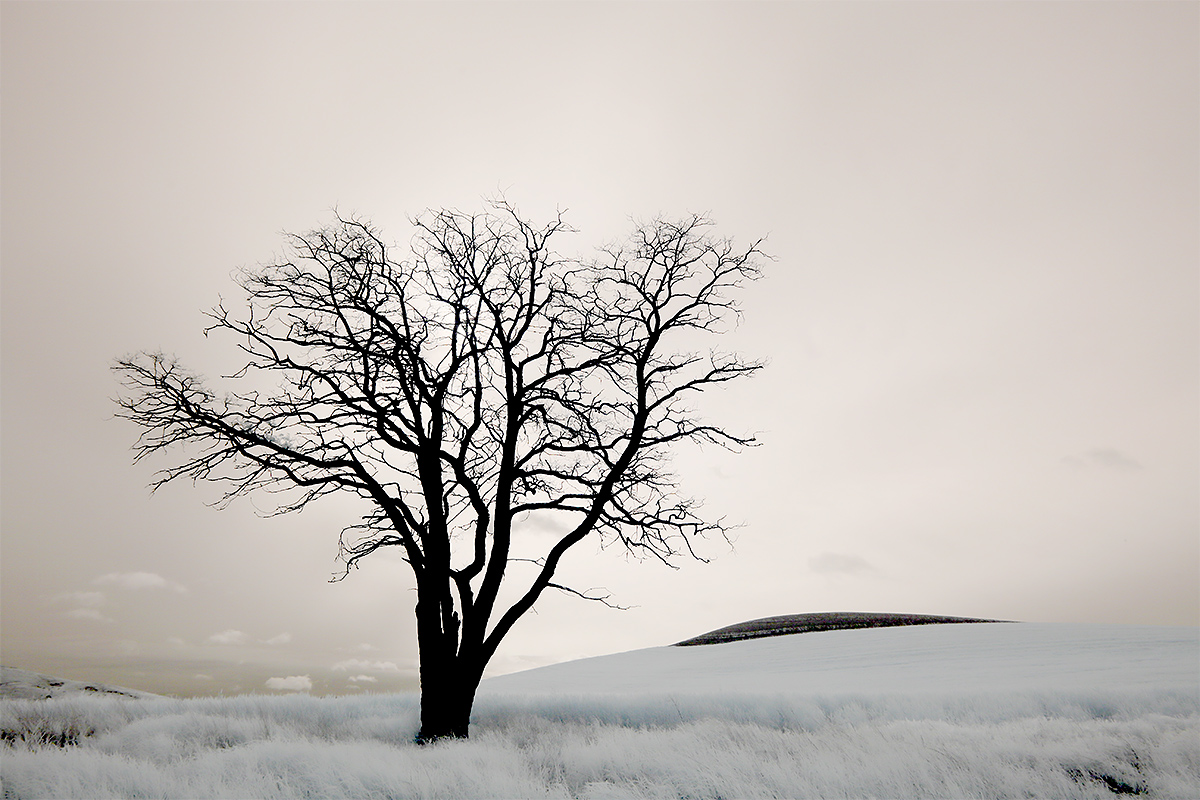
|
|
This image was created on the first Palouse IPT with the hand held Canon EF 11-24mm f/4L USM lens (at 20mm) and an EOS-5D Mark II converted to Infrared at 720nm by Kolari Vision. Evaluative metering +1 stop: 1/1250 sec. at f/9. Custom WB.
Center AF point/One Shot/Shutter Button AF on the branches and recompose while half-pressing the shutter button. Click on the image to see a larger version.
Image #2: Denise’s Tree/Infrared Capture/Image copyright 2015: Arthur Morris/BIRDS AS ART
|
Choosing a Filter
Filter Choices
The text below is cut and pasted from an informative Kolari Vision article. You can access the complete photo illustrated tutorial by clicking here.
We currently have 6 filters to pick from. We offer the 720nm standard infrared, the 850nm deep infrared, the 665nm extra color infrared, the 590nm infrared, a full spectrum filter, and a two spectrum filter. All filters are the same price.
The Standard IR Filter (720nm) allows for good false color, and good contrast for black and white. This is equivalent to the Hoya R72 and the Wratten 89b.
The Ultra Color filter (590nm) lets more visible light in. It produces the most vibrant colors: leaves are golden yellow, skies are bright blue.
The Enhanced Color filter (665nm) has an effect between the 720nm and 590nm, producing more vibrant colors than the 720nm for pale yellow leaves and soft blue skies.
The Deep Black and White filter (850nm) is good for a dedicated black and white IR. The camera and will produce bright whites and pronounced blacks. It is Equivalent to the Wratten 87c.
After some serious thinking I converted my camera at 720nm. We did get a chance to experiment with Catherine Costolo’s super-color IR camera.
Costs
Kolari Vision offers economical IR conversions for a great variety of camera bodies.
|
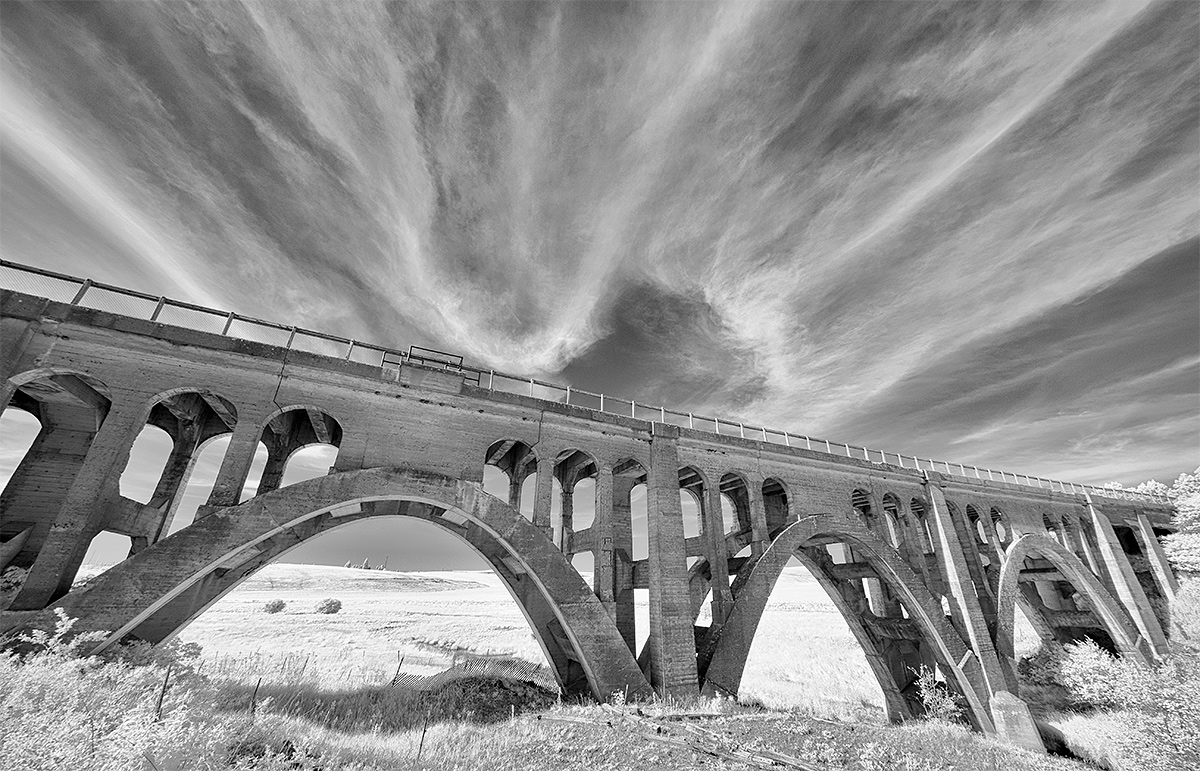
|
|
This image was created on the second Palouse IPT with the hand held Canon EF 11-24mm f/4L USM lens (at 11mm) and an EOS-5D Mark II converted to Infrared at 720nm by Kolari Vision. Evaluative metering +1 1/3 stops: 1/200 sec. at f/8. Custom WB.
Center AF point/One Shot/Shutter Button AF on the center of the bridge and recompose while half-pressing the shutter button. Click on the image to see a larger version.
Image #3: Old Railroad Bridge/Infrared Capture
|
Your Favorite?
Which of today’s three infrared images is your favorite? Please let us know why you made your choice.
Facebook
Be sure to like and follow BAA on Facebook by clicking on the logo link upper right. Tanks a stack!
Support the BAA Blog. Support the BAA Bulletins: Shop B&H here!
We want and need to keep providing you with the latest free information, photography and Photoshop lessons, and all manner of related information. Show your appreciation by making your purchases immediately after clicking on any of our B&H or Amazon Affiliate links in this blog post. Remember, B&H ain’t just photography!
…..
Amazon.com
Those who prefer to support BAA by shopping with Amazon may use this link:
Amazon Canada
Many kind folks from north of the border, eh, have e-mailed stating that they would love to help us out by using one of our affiliate links but that living in Canada and doing so presents numerous problems. Now, they can help us out by using our Amazon Canada affiliate link by starting their searches by clicking here. Many thanks to those who have written.
Typos
In all blog posts and Bulletins, feel free to e-mail or to leave a comment regarding any typos or errors. Just be right :).
|
|



